Baroque art (Final exam)
1/216
There's no tags or description
Looks like no tags are added yet.
Name | Mastery | Learn | Test | Matching | Spaced |
|---|
No study sessions yet.
217 Terms
Portrait of an Elderly Man

Anthony van Dyck
1618
Period/Movement
Flemish Baroque
Van Dyck was active during the Baroque period, a time marked by dramatic expression, realism, and emphasis on the human figure. By 1618, van Dyck had already become a prominent figure in Peter Paul Rubens’ workshop in Antwerp and was beginning to develop his own elegant portrait style that would soon distinguish him across Europe.
Medium
Oil on Canvas
Van Dyck’s mastery of oil paint allowed him to render soft textures, expressive faces, and luminous flesh tones—qualities that are evident in this portrait.
Current Location
Kunsthistorisches Museum, Vienna, Austria
Context
This portrait was painted when van Dyck was only around 19 years old, showcasing his precocious talent and his rising status as a portraitist. He was already working in Rubens' workshop, absorbing the grand Baroque style and refining his own distinctive approach to character and elegance.
The subject is unknown, but the focus on the sitter’s age, expression, and wisdom suggests a humanist interest in the psychological depth of the individual, rather than a mere record of social rank.
Composition and Form
The seated man, dressed in dark, formal clothing with a modest white collar, is depicted in a three-quarter view.
The background is neutral, allowing the viewer to focus on the sitter’s face and hands—key expressive features in Baroque portraiture.
Van Dyck uses subtle chiaroscuro to model the forms, giving a sense of depth and presence while maintaining a refined elegance.
Themes and Symbolism
Dignity in Aging: The subject’s lined face and solemn gaze evoke dignity, experience, and inner strength. Unlike more theatrical Baroque portraits, this work is subdued and contemplative.
Naturalism and Psychological Insight: Rather than idealizing the sitter, van Dyck emphasizes his humanity. This reflects a growing interest in the individual and a humanist appreciation for character.
Style
The portrait reflects influence from Rubens, particularly in its naturalism and soft handling of flesh and fabric.
Van Dyck’s emerging elegant and refined portrait style—which would later become synonymous with the English court—is evident in the sitter’s posture and expressive face.
The restrained color palette and the focus on mood over ornamentation distinguish this work from the more exuberant tendencies of High Baroque portraiture.
Function
Likely a private commission, possibly meant for familial remembrance or to honor the subject's wisdom and stature in life.
The intimate size and naturalistic execution suggest it was intended for personal rather than public display.
Legacy and Influence
This portrait is an early example of van Dyck’s ability to combine empathy, elegance, and psychological realism, qualities that would make him the preeminent court portraitist of Charles I of England in the following decades.
His influence would resonate across England and the Continent, shaping portraiture well into the 18th century.
Christ Crowned with Thorns
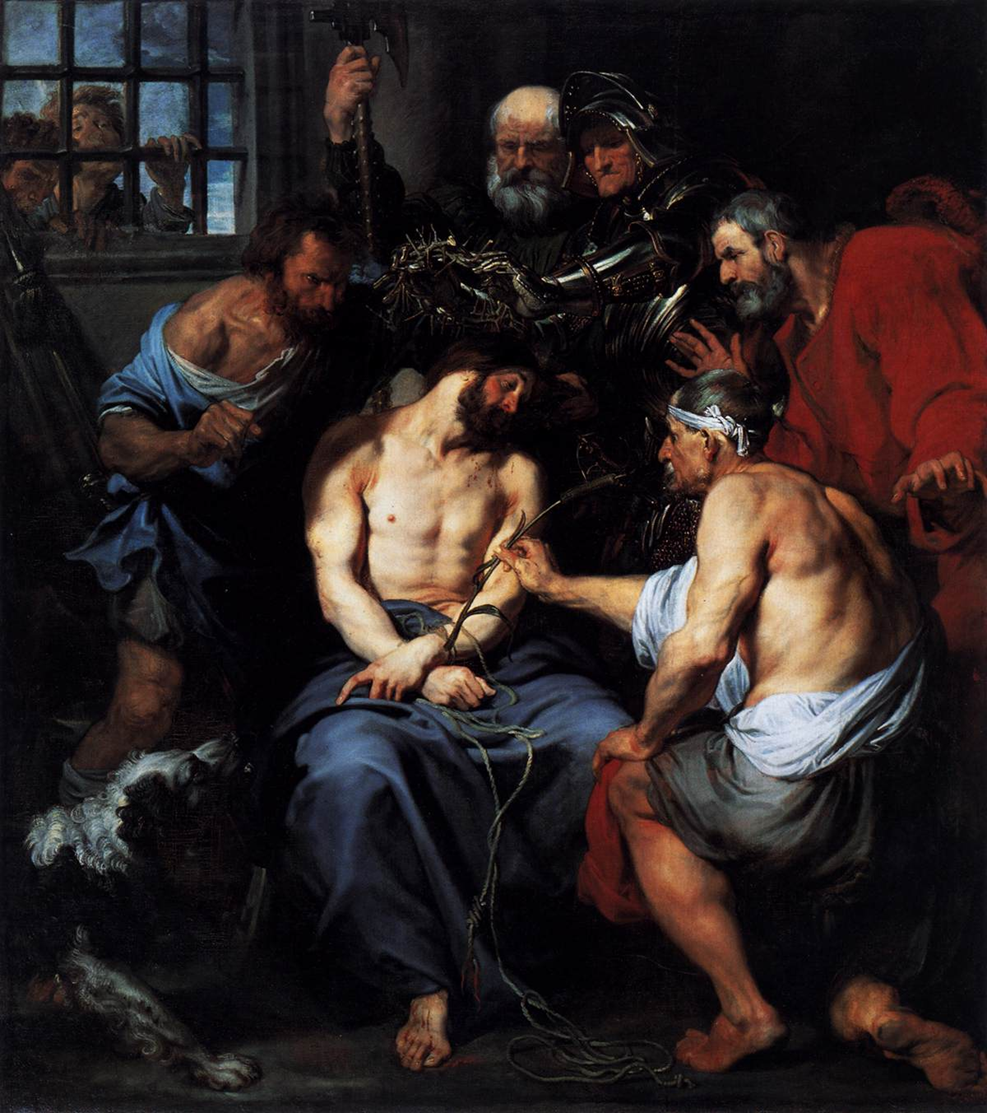
Anthony van Dyck
ca. 1620
Period/Movement
Flemish Baroque
Painted around the time van Dyck had just returned from his first Italian journey (c. 1621), this work reflects both the emotional intensity of the Baroque and the influence of Italian masters, especially Titian and Veronese, blended with the dramatic realism of Rubens.
Medium
Oil on Canvas
Current Location
Museo del Prado, Madrid, Spain
Context
This painting is one of several religious works van Dyck produced early in his career, during or just before his time in Italy.
Influenced by Rubens’ dynamic figures and Italian coloration and composition, van Dyck here balances Flemish realism with a venetian softness and luminosity.
The subject, Christ mocked and crowned with thorns before his crucifixion, was a common devotional image in Counter-Reformation art—designed to inspire empathy, penitence, and reflection.
Composition and Form
Christ is seated in the center, surrounded by soldiers who press a crown of thorns onto his head. The pose is passive and sorrowful, emphasizing his suffering and humility.
The figures crowd the canvas, their gestures and facial expressions full of aggression or contempt, while Christ’s face is calm and resigned.
Van Dyck uses diagonal composition, contrasting light and shadow (tenebrism), and muscular, expressive bodies, in a style reminiscent of both Rubens and Caravaggio.
Themes and Symbolism
Sacrifice and Redemption: The crown of thorns is a clear symbol of Christ’s willing suffering for humanity’s sins.
Contrast of Divine and Human: The calm, idealized Christ contrasts sharply with the rough, emotional tormentors—reflecting the theme of innocence persecuted.
Emotional Realism: The image is meant to evoke empathy and devotional reflection, central goals of Baroque religious art in the post-Tridentine world.
Style
Strong Caravaggesque lighting, with dark background and light hitting key figures (especially Christ).
Influences from Titian in the color palette and Rubens in the energetic forms and twisting bodies.
Van Dyck blends Baroque drama with refined elegance, especially in the rendering of Christ’s flesh and features.
Function
Likely commissioned as an altarpiece or private devotional painting, meant to aid in spiritual contemplation and emotional engagement with the Passion of Christ.
Fits into Counter-Reformation goals of using art to instruct and move the faithful through powerful, affective imagery.
Legacy and Influence
One of van Dyck’s early masterpieces in religious art, it shows his mastery of pathos and form before turning more fully to portraiture in the 1620s.
Helped solidify his international reputation, especially in Italy and Spain, where this kind of deeply emotional devotional image was in high demand.
Madonna of the Rosary
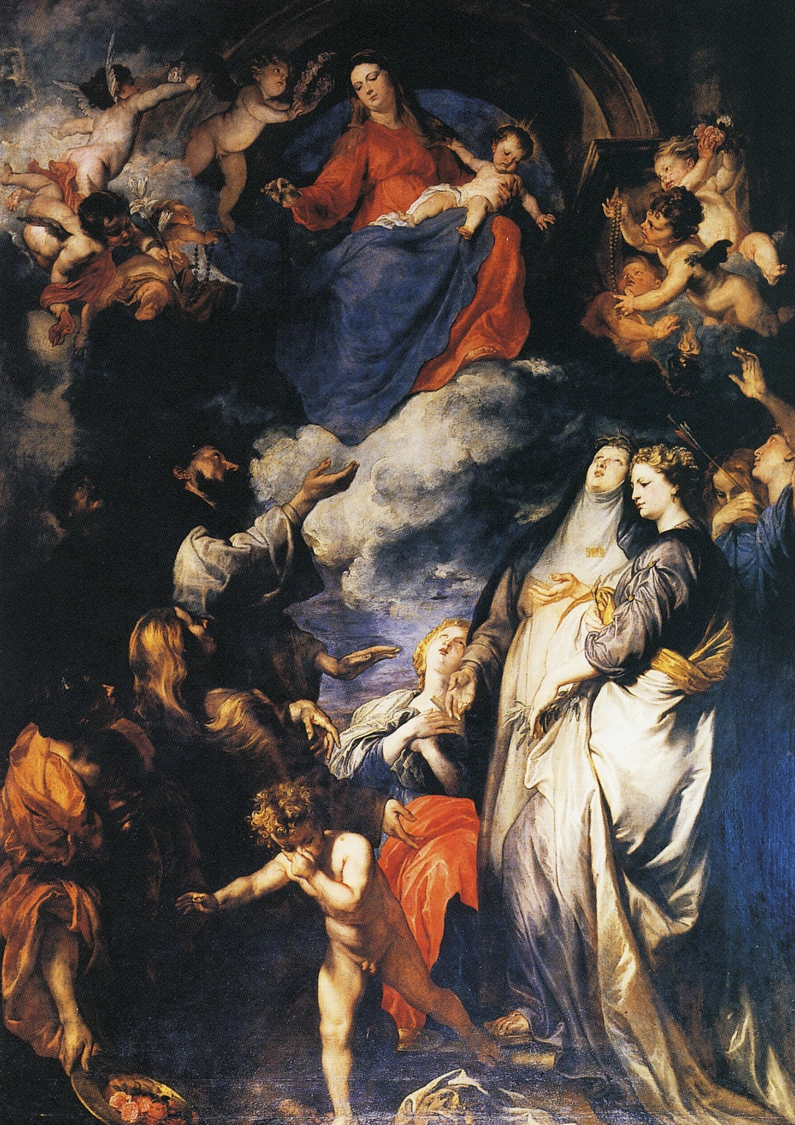
Anthony van Dyck
1624-26
Period/Movement
Flemish Baroque
This work comes from van Dyck’s mature Italian period, specifically while he was in Palermo, Sicily, during a time of plague. It reveals the influence of Titian, Rubens, and the broader goals of the Counter-Reformation.
Medium
Oil on canvas
Current Location
Oratorio del Rosario di Pompei, Palermo, Sicily
Context
Painted during van Dyck’s Italian travels, Madonna of the Rosary was commissioned by a Dominican brotherhood during a plague outbreak. The subject was deliberately chosen for its spiritual association with protection and intercession.
The rosary was a powerful devotional tool promoted by the Dominicans, and images of the Madonna distributing it symbolized divine grace and healing.
Van Dyck had fled to Palermo in 1624 to escape plague in mainland Italy, only to encounter another outbreak—this work is deeply tied to that context of faith amidst crisis.
Composition and Form
The Virgin and Child are enthroned high above, seated on clouds and surrounded by putti (cherubs), distributing rosaries.
Below, St. Dominic and St. Catherine of Siena (key Dominican saints) distribute rosaries to the faithful. The saints are idealized, yet grounded in human emotion and realism.
The composition has a vertical, pyramidal structure, drawing the eye upward to the Virgin, symbolizing heavenly intercession and salvation.
The use of rich Venetian color, soft modeling, and atmospheric light reflects van Dyck’s study of Titian and Veronese, with added Flemish detail and dynamism.
Themes and Symbolism
Intercession: The Virgin acts as a mediator between heaven and earth, offering the rosary as a spiritual lifeline during the plague.
Faith and Protection: The act of distributing the rosary reflects Catholic doctrine that prayer and devotion offer divine protection and grace.
Triumphant Virgin: Seated above, Mary also evokes the Queen of Heaven, reinforcing her exalted status in Catholic devotion.
Style
Combines Italian coloration with Flemish emotional realism.
Strong diagonal lines, luminous skin tones, graceful gestures, and richly draped fabrics.
Figures are elegant and idealized—hallmarks of van Dyck’s mature religious style—while still conveying emotion and naturalistic presence.
Function
Served as a public altarpiece for the Dominican Oratory, reinforcing devotion to the rosary and offering spiritual solace during the plague.
Aimed at eliciting empathy, piety, and awe—key goals of Baroque religious art aligned with Counter-Reformation ideals.
Legacy and Influence
This painting helped cement van Dyck’s reputation in Italy and led to further commissions.
It showcases his successful synthesis of Italian grandeur and Flemish sensitivity, and anticipates the courtly elegance he would later bring to English portraiture.
Sacra conversazione
Meaning "holy conversation" in Italian, refers to a specific type of religious artwork, particularly a painting. It depicts the Virgin Mary and the infant Jesus surrounded by saints, often in a unified space, engaged in a "conversation" or interaction. This artistic form replaced the polyptych (multiple panel altarpiece) during the Renaissance, offering a new way to portray the Christian community across time and space.
Cardinal Guido Bentivoglio

Anthony van Dyck
1622-27
Medium
Oil on canvas
Current Location
Palazzo Pitti, Florence
Historical Context
Painted during van Dyck’s extended stay in Italy, this portrait shows the influence of Titian and Rubens, particularly in its rich color palette, psychological depth, and sophisticated elegance.
Guido Bentivoglio (1579–1644) was a prominent Cardinal, papal diplomat, and historian. Known for his intellect and statesmanship, he served as nuncio in Flanders, where he became a patron and acquaintance of Rubens—creating a direct connection to van Dyck’s Flemish world.
This portrait may have been commissioned shortly after Bentivoglio’s return to Rome in 1618 and reflects van Dyck’s ability to capture the authority and refinement of elite sitters.
Formal Analysis
Pose & Composition: Bentivoglio is depicted seated in a dignified, three-quarter pose, turned slightly to his right, with a calm but commanding expression. His right hand rests lightly on the armrest, the left possibly holding a letter—subtly referencing his diplomatic and intellectual career.
Color & Texture: Van Dyck masterfully renders the deep crimson robes of a cardinal, with meticulous attention to texture, light, and layering. The satin glows under soft light, adding a sense of richness and physicality.
Background: Neutral, dark, and unobtrusive—enhancing the prominence of the cardinal and lending a sense of gravitas and introspection.
Expression: The sitter's calm, intelligent gaze, slightly raised eyebrows, and parted lips suggest both alertness and self-assurance, revealing van Dyck’s gift for psychological nuance.
Style
A superb example of Baroque portraiture, combining Flemish realism with the elegance and restraint of the Italian high style.
Influences include Titian’s portraits of Venetian nobility, seen in the rich fabrics and subtle modeling of the face.
Van Dyck's hallmark characteristics are present: elongated figures, refined hands, and a fluid, painterly surface.
Themes and Symbolism
Power and Prestige: Bentivoglio’s rank is announced through both his cardinal’s robes and the serenity of his pose—he is in control, dignified, a representative of church and intellect.
Diplomacy and Learning: The inclusion of a letter or paper (if present) subtly nods to his roles in international negotiation and his authorship of historical texts.
Human Presence: Unlike some colder court portraits, van Dyck’s sitter feels real—he breathes, thinks, and reflects, aligning with the Baroque ideal of emotional connection.
Function
Likely intended as an official portrait to commemorate Bentivoglio’s elevated status and role within the papal court.
Reinforced his political and intellectual authority, possibly for public display in his residence or as a diplomatic gift.
Legacy and Influence
This work showcases van Dyck’s development into one of the premier portraitists of his age, soon to be tapped by Charles I of England.
The painting helped shape the Baroque ideal of noble portraiture—dignified yet personal, stately yet alive.
It influenced later papal and ecclesiastical portraiture, echoing even into 18th-century depictions of clerics.
Elena Grimaldi

Anthony van Dyck
Marchesa Cattaneo
1623
Medium
Oil on canvas
Current Location
National Gallery of Art, Washington, D.C.
Historical Context
Painted during van Dyck’s Italian period (1621–27), specifically while he was working in Genoa, a wealthy port city known for its patronage of foreign artists.
The Grimaldi and Cattaneo families were among Genoa’s elite, and portraiture was a way to project status, lineage, and refinement.
This portrait was commissioned at a time when van Dyck was actively cultivating a courtly, aristocratic style, influenced by Titian and Rubens.
The Sitter
Elena Grimaldi was married into the Cattaneo family, placing her at the top of Genoese society.
Her depiction as a dignified and graceful noblewoman not only celebrates her beauty and rank but also adheres to ideals of virtue, poise, and nobility.
Formal Analysis
Pose & Composition: Elena stands full-length, turned slightly to the side with a composed and almost statuesque bearing. Her gaze is steady, yet slightly detached—appropriate for noble portraiture of the time.
Gesture & Accompaniment: She is accompanied by a black page (a common Baroque trope indicating exotic wealth), who draws back a curtain, revealing her in a formal setting. This dramatic gesture emphasizes her importance and theatrical presentation.
Attire: Her black silk gown, trimmed with lace and gold, and her elaborate jewelry indicate extreme wealth and refinement. The dress’s shimmering material and stiff structure heighten her formality.
Color & Light: Van Dyck uses a limited, luxurious palette—deep blacks, golds, and whites—with silvery highlights. Light reflects softly on her skin and fabrics, giving the figure a regal glow.
Setting: The inclusion of a balustrade and curtain creates a stage-like effect, enhancing the portrait's performative quality.
Style
Shows van Dyck’s shift toward the Italian Baroque elegance seen in the works of Titian, especially in full-length noble portraits.
Compared to his earlier Flemish works, this portrait is more stylized and idealized, favoring graceful elongation and subtle theatricality.
The vertical format and grand scale align with contemporary traditions of noble representation.
Themes and Symbolism
Nobility and Refinement: Every aspect of Elena’s appearance communicates wealth, status, and decorum.
Power and Exoticism: The presence of the Black page signals not only colonial wealth but also serves to highlight the sitter’s whiteness and importance—a complex racial and social dynamic typical of elite European portraiture.
Stage and Spectacle: The curtain being drawn aside reflects the Baroque fascination with illusion, performance, and grandeur.
Function
Commissioned to document and display social status, beauty, and family prominence.
Likely hung in a palazzo or reception space where visitors would encounter the image as a visual declaration of the family’s elite position.
Legacy and Influence
A key example of van Dyck’s Genoese portraits, which influenced Italian and Northern European portraiture alike.
Helped establish the aristocratic portrait model—full-length, elegant, with a balance of formality and liveliness—that van Dyck would later perfect in England.
Reflects the globalized, hierarchical world of 17th-century Europe, where art, status, and empire intersected.
Virgin and Child with Sts. Paul, Peter, and Rosalie
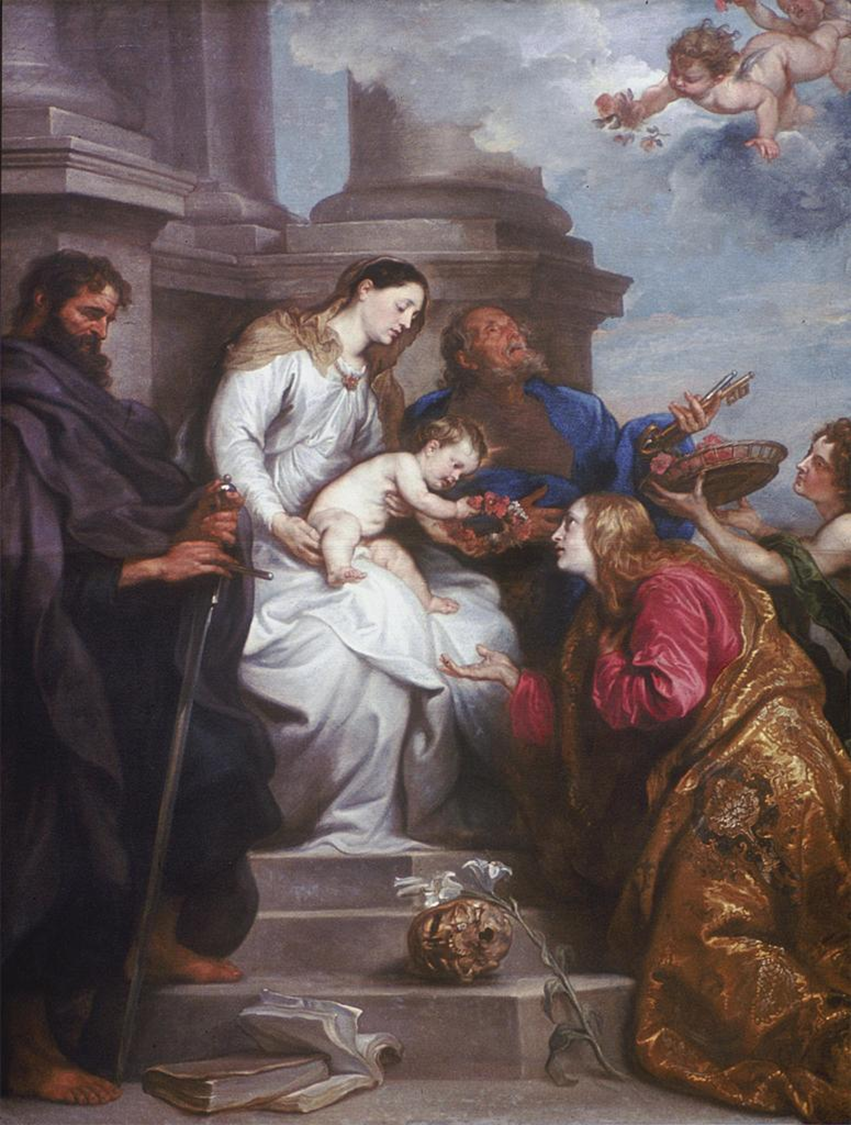
Anthony van Dyck
1629
Medium
Oil on canvas
Current Location
Galleria Nazionale della Sicilia (Palazzo Abatellis), Palermo, Italy
Historical and Religious Context
Commissioned while van Dyck was active in Palermo, Sicily, during his stay in Southern Italy between 1624 and 1629.
This period coincided with a plague outbreak, during which Saint Rosalie, a local saint of Palermo, was venerated for her miraculous protection against the disease.
The painting reflects a plague ex-voto tradition, where artworks were created as offerings of thanksgiving or as petitions for divine intervention during times of crisis.
Subject and Iconography
Virgin and Child: Positioned at the center and elevated, representing divine authority, grace, and intercession. The Virgin gestures with maternal tenderness, while the Christ Child often extends a blessing or interacts with the saints below.
St. Peter: Usually shown with keys, a symbol of his authority and role as gatekeeper of heaven.
St. Paul: Identified by his sword, referencing both his martyrdom and his role as a militant apostle of the faith.
St. Rosalie: Portrayed in a contemplative and humble posture, dressed as a hermit with long flowing hair and a wreath of flowers or roses—her symbols as the patron saint of Palermo.
Formal Analysis
Composition: Strongly vertical, with the holy figures placed in a heavenly realm above and the saints arranged below, creating a spiritual hierarchy. The viewer’s gaze is drawn upward to the Virgin and Child.
Color Palette: Rich but softened—deep reds, muted blues, earthy browns, and glowing skin tones. The ethereal lighting and gentle contrasts lend the work a warm, devotional atmosphere.
Use of Light: A subtle divine radiance emanates from the Virgin and Child, enhancing their sanctity. The lighting adds volume and dignity to the figures without overt drama.
Gesture and Expression: Calm and reverent. Each saint appears absorbed in devotion, reflecting inner piety rather than outward emotion—typical of Van Dyck’s religious works.
Style
Reflects a synthesis of Italian Baroque influence (especially Titian and Correggio) with van Dyck’s Flemish sensitivity to texture and emotion.
Compared to his earlier works, this painting exhibits a gentler elegance and spiritual serenity, a hallmark of his mature religious compositions.
The figures are idealized but individualized, creating a sense of both the sacred and the accessible.
Function
Likely intended for a private or public devotional space, possibly commissioned as a plague-related votive offering to honor Saint Rosalie’s intercession.
Served to inspire prayer and veneration in a time of communal suffering, providing both visual beauty and spiritual comfort.
Legacy
A significant work from van Dyck’s Palermitan period, where he adapted his portraiture skills to large-scale, multi-figure religious compositions.
Demonstrates van Dyck’s ability to blend Flemish detail and Italian grandeur, making him a key figure in the development of international Baroque painting.
The inclusion of Saint Rosalie, relatively rare outside of Palermo, also links this piece to a specific moment in Sicilian religious history and van Dyck’s direct response to it.
Rinaldo and Armida
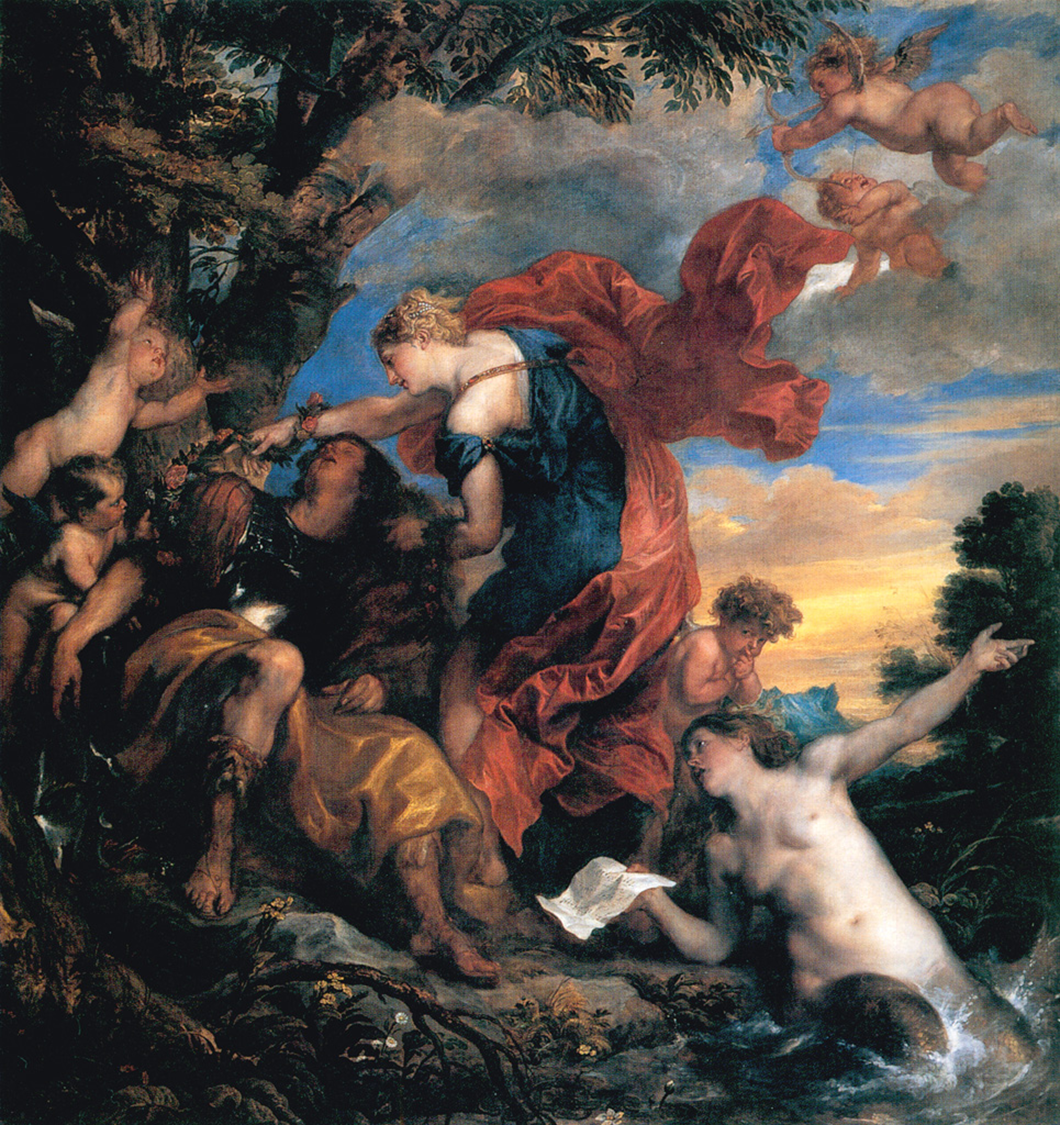
Anthony van Dyck
1629
Medium
Oil on canvas
Current Location
Kunsthistorisches Museum, Vienna, Austria
Literary and Mythological Context
Based on Jerusalem Delivered (La Gerusalemme Liberata, 1581), an epic poem by Torquato Tasso.
Tasso’s poem blends Christian crusade narrative with romantic fantasy, following the exploits of Christian knights during the First Crusade.
The story of Rinaldo and Armida is one of its most famous subplots:
Rinaldo, a Christian knight, is seduced and enchanted by the sorceress Armida, an enemy of the crusaders.
She brings him to her magical garden to distract him from his divine mission.
Eventually, other knights find Rinaldo and break the spell, prompting his return to duty.
The tale balances themes of love, temptation, and heroic virtue.
Subject and Iconography
Van Dyck depicts the moment when Armida gazes lovingly at the sleeping Rinaldo, hesitating between killing him (as instructed) and falling in love.
Rinaldo lies nude and vulnerable, a classical pose that recalls ancient statuary, symbolizing innocence and beauty.
Armida is richly dressed and leaning over him, her dagger either drawn or cast aside—highlighting her emotional transformation.
The garden setting is lush and enchanted, visually evoking temptation and sensuality.
Cupid or putti may be present, reinforcing the themes of love and enchantment.
Formal Analysis
Composition: The diagonal positioning of Rinaldo’s body contrasts with the upright, twisting figure of Armida, creating visual tension and narrative drama.
Light and Color: Van Dyck uses a warm, golden light to model the flesh and rich fabrics. The luminous palette enhances the scene’s emotional and seductive tone.
Brushwork: Smooth and refined, particularly in the rendering of skin and textiles, showcasing Van Dyck’s Flemish roots and influence from Titian.
Emotion and Gesture: Armida’s face reflects conflict, tenderness, and awe, while Rinaldo’s peaceful slumber evokes purity and trust, increasing the dramatic irony.
Style and Influence
Strong influence from Titian and the Venetian tradition, particularly in the sensuous treatment of mythological subjects.
Van Dyck’s use of psychological nuance and expressive body language reflects his deepening maturity as an artist.
Combines Baroque theatricality with Renaissance grace, balancing spectacle with emotional depth.
Function and Patronage
Likely commissioned for a private collection, intended to entertain and intellectually engage an elite viewer familiar with Tasso’s poem.
Mythological and literary subjects were highly prized in aristocratic settings, showcasing both erudition and aesthetic sophistication.
This work provided visual pleasure, moral reflection, and classical reference—ideal for Baroque connoisseurs.
Legacy and Interpretation
One of Van Dyck’s most compelling mythological paintings.
Explores the power dynamics between genders, the tension between duty and desire, and the fine line between violence and love—all major Baroque themes.
A masterclass in narrative painting, where the viewer is drawn into a single, suspended moment full of psychological drama.
Torquato Tasso, gerusalemme liberata
Jerusalem Delivered, also known as The Liberation of Jerusalem, is an epic poem by the Italian poet Torquato Tasso, first published in 1581, that tells a largely mythified version of the First Crusade in which Christian knights, led by Godfrey of Bouillon, battle Muslims in order to take Jerusalem.
Charles I
A major figure during the Baroque period and played a significant role in the development of the art movement in England. He was a keen collector of art, particularly of the Old Masters, and is known to have commissioned works by famous Baroque artists. Notably, he employed Anthony van Dyck as his official court painter, and van Dyck created numerous portraits of Charles I and his court, showcasing the grandeur and dynamism characteristic of the Baroque style
Charles I with Monseigneur de St. Antoine

Anthony van Dyck
1633
Medium
Oil on canvas
Current Location
Royal Collection, London (Hampton Court Palace)
Context & Patronage
Commissioned by King Charles I to promote royal authority and the divine right of kings.
Van Dyck had recently been knighted and appointed "Principal Painter in Ordinary" to the king (1632).
This equestrian portrait aligns Charles I with the grandeur of Roman emperors and the chivalric ideals of Renaissance monarchs.
Monseigneur de St. Antoine was Charles’s riding master, representing discipline, nobility, and classical equestrian prowess.
Subject and Iconography
Charles I is depicted mounted on a powerful horse, dressed in gilded armor with a baton of command in hand—evoking the iconography of a victorious general or emperor.
His calm expression and noble posture project authority, while the horse's raised leg and controlled movement suggest energy under control.
M. de St. Antoine follows on foot, helmet in hand, positioned deferentially behind and slightly below the king—emphasizing hierarchy and service.
The distant landscape and dramatic sky contribute to the grandeur, suggesting a world under royal dominion.
The image blends portraiture and state propaganda, intended to exalt Charles I’s kingship and martial elegance.
Formal Analysis
Composition: Triangular structure focusing on the king and horse, with strong diagonals from lance, limbs, and gaze.
Color and Light: Rich, cool hues with metallic highlights; van Dyck renders armor with great attention to luster and reflection.
Scale and Space: Monumental; the king and horse dominate the canvas, enhancing their symbolic stature.
Naturalism vs. Idealization: Charles I’s features are true to life but idealized in bearing—combining portrait precision with classical grandeur.
Style and Influence
Inspired by Titian's equestrian portraits (e.g., Charles V at Mühlberg) and Rubens’ courtly magnificence.
Merges Flemish detail with Italianate monumentality.
Van Dyck’s signature elegance and psychological poise distinguish his royal sitters from earlier English portraiture (e.g., the stiffer style of Daniel Mytens).
Function and Message
A visual assertion of authority during a time when Charles’s rule was under scrutiny (pre-English Civil War tensions).
Communicates the ideals of divine monarchy, chivalry, and martial discipline.
Serves as a propagandistic masterpiece, reinforcing Charles’s image as the natural, rightful sovereign.
Legacy and Interpretation
One of Van Dyck’s most celebrated equestrian portraits.
Sets a standard for royal portraiture in Britain, influencing artists like Joshua Reynolds and Thomas Gainsborough.
Seen as an emblem of Stuart kingship, later imbued with nostalgia and tragedy after Charles I’s execution in 1649.
The Duke of Lerma
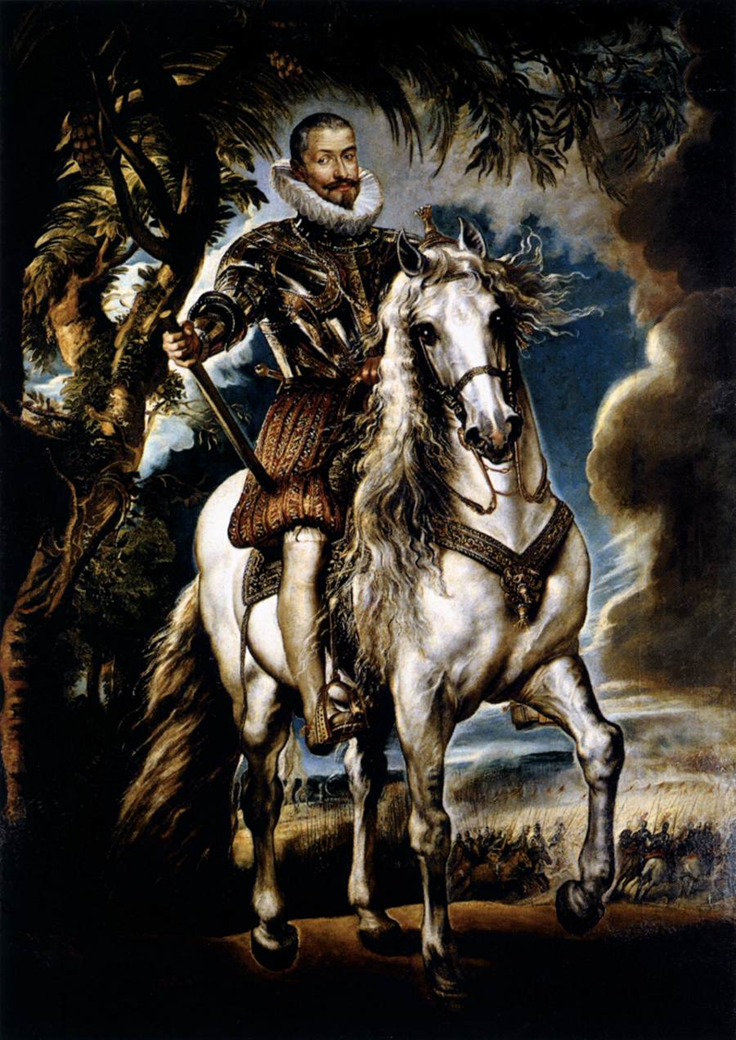
Peter Paul Rubens
ca. 1603
Medium
Oil on canvas
Current Location
Museo del Prado, Madrid
Historical Context
Created during Rubens’s diplomatic visit to Spain in 1603 as an envoy from the Duke of Mantua.
The sitter, Francisco Gómez de Sandoval y Rojas, Duke of Lerma, was the powerful favorite (valido) of King Philip III of Spain, effectively running the kingdom.
The painting was part of Rubens’s early career and helped establish his international reputation.
Subject & Iconography
The Duke of Lerma is shown on horseback, dressed in elaborate armor, with a marshal’s baton, commanding the viewer's attention as a ruler and military leader.
His horse rears dynamically, evoking Roman imperial imagery and reinforcing his dominant political role.
He is framed by a dramatic landscape and sky, contributing to the heroic, triumphal tone.
Visual & Formal Analysis
Composition: Classic triumphal equestrian format, with strong diagonals in horse’s body and the baton guiding the viewer’s eye.
Color and Texture: Rich, velvety fabrics and glistening metal; Rubens’s painterly surface creates depth and opulence.
Light and Atmosphere: A strong use of chiaroscuro emphasizes both realism and theatricality, placing the Duke in a near-divine glow.
Pose and Gesture: The Duke’s posture is upright, serene, and confident—a blend of naturalism and idealized authority.
Influence & Style
Reflects Rubens’s exposure to Titian and Venetian colorism, merged with his own emerging Baroque dynamism.
Anticipates the grandeur of later equestrian portraits (e.g., Rubens’s Charles V at Mühlberg, 1620s) and influences van Dyck's Charles I equestrian paintings.
Function & Message
Serves as a political and propagandistic portrait, glorifying Lerma’s de facto power over Spain.
Reinforces the iconography of martial nobility, linking Lerma to Roman emperors and Christian knightly ideals.
The painting asserts Lerma’s personal prestige as much as his institutional authority.
Legacy & Significance
One of Rubens’s earliest major state portraits, revealing his diplomatic skill as well as artistic prowess.
Sets a precedent for the Baroque equestrian portrait, combining monumentality, grace, and theatrical narrative.
Offers a visual record of early 17th-century Spanish court culture, filtered through the lens of Flemish flair.
Le Roi a la Chasse (The King at the Hunt)
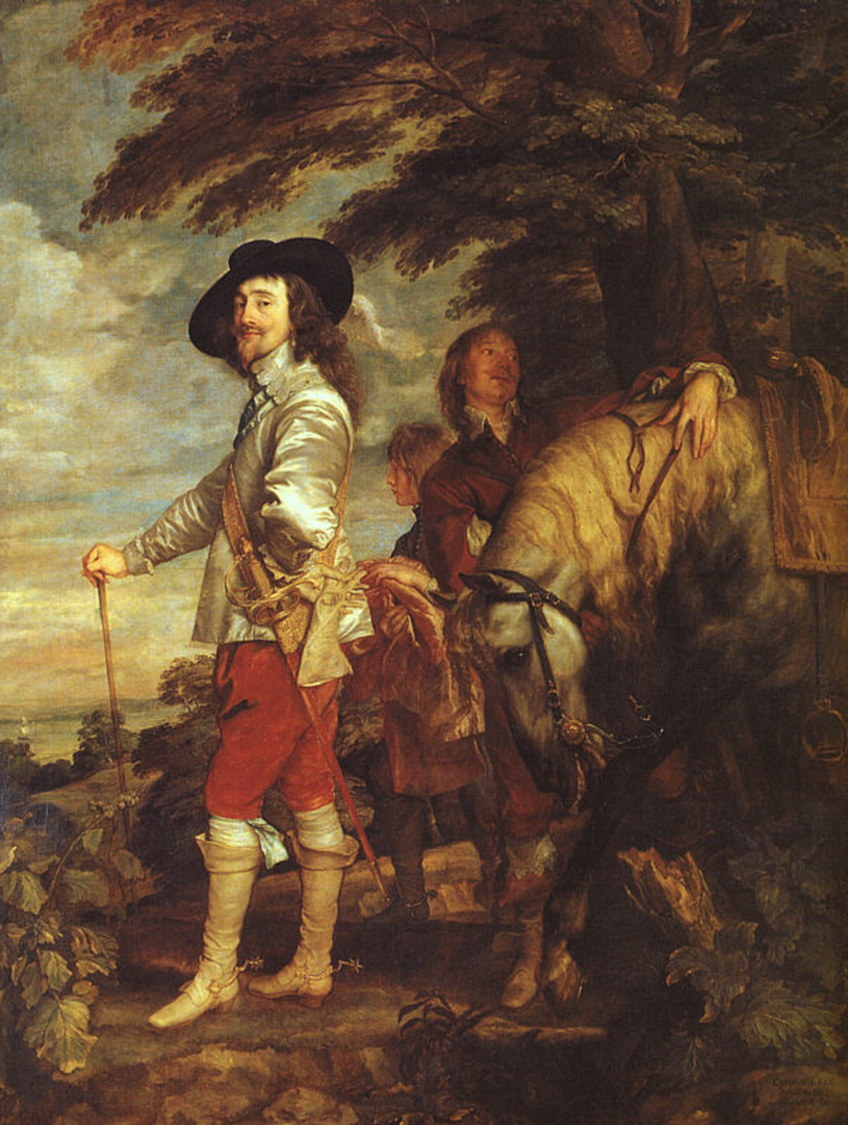
Anthony van Dyck
1635
Medium
Oil on canvas
Current Location
Louvre Museum, Paris
Patron & Subject
Commissioned by or for King Charles I of England, van Dyck’s chief patron.
Charles is shown as an elegant gentleman hunter, not in military dress, emphasizing refined kingship rather than martial prowess.
The figure is flanked by two attendants and a horse, set in a lush countryside—symbolic of royal dominion over land and leisure.
Historical & Political Context
Painted during a period of increasing political tension in England, just a few years before the English Civil War.
This portrait subtly reinforces Charles’s divine right and royal poise, while offering a less formal, more natural image of kingship.
Reflects courtly ideals of nobility and cultured refinement, crucial to Charles’s self-image and propaganda.
Visual & Formal Analysis
Composition: Charles stands off-center, facing the viewer with a slight contrapposto stance, allowing his elegance to dominate the space without grandeur.
Gesture: One hand rests on his hip, the other holds a walking stick—calm, controlled, subtly authoritative.
Attire: Not in armor, but richly dressed in leisure clothing with high boots and a plumed hat, exemplifying courtly fashion.
Landscape: A calm, sweeping English countryside, evoking harmony, nobility, and stewardship.
Lighting: Soft and atmospheric, highlighting the textures of Charles’s clothing and the serene ambiance.
Stylistic Characteristics
Strong influence from Titian and Rubens in color, pose, and landscape integration.
Van Dyck’s signature refined, aristocratic naturalism—the king appears both idealized and realistic.
Lacks overt symbolism or allegory, yet exudes authority through composition and elegance.
Function & Message
A non-military image of monarchy, highlighting taste, control, and noble demeanor.
Projects absolute monarchy through aesthetic confidence rather than force.
Meant to portray Charles as God’s chosen ruler, capable of ruling with grace and harmony.
Comparative Notes
Contrasts with Rubens’s Duke of Lerma or Equestrian Portrait of Charles V, which depict military authority.
Closer in tone to Velázquez’s informal court portraits or Gainsborough’s later naturalistic aristocrats.
A companion piece to van Dyck’s Charles I on Horseback (1637), but this one is more intimate and approachable.
Legacy & Significance
One of the most iconic royal portraits of the 17th century.
Helped define the image of the Stuart monarchy, influencing court portraiture for decades.
Van Dyck’s treatment became the standard for aristocratic portraiture—elegant, poised, and subtly powerful.
waterschilder
watercolor painter
Holy Family with St. John the Baptist
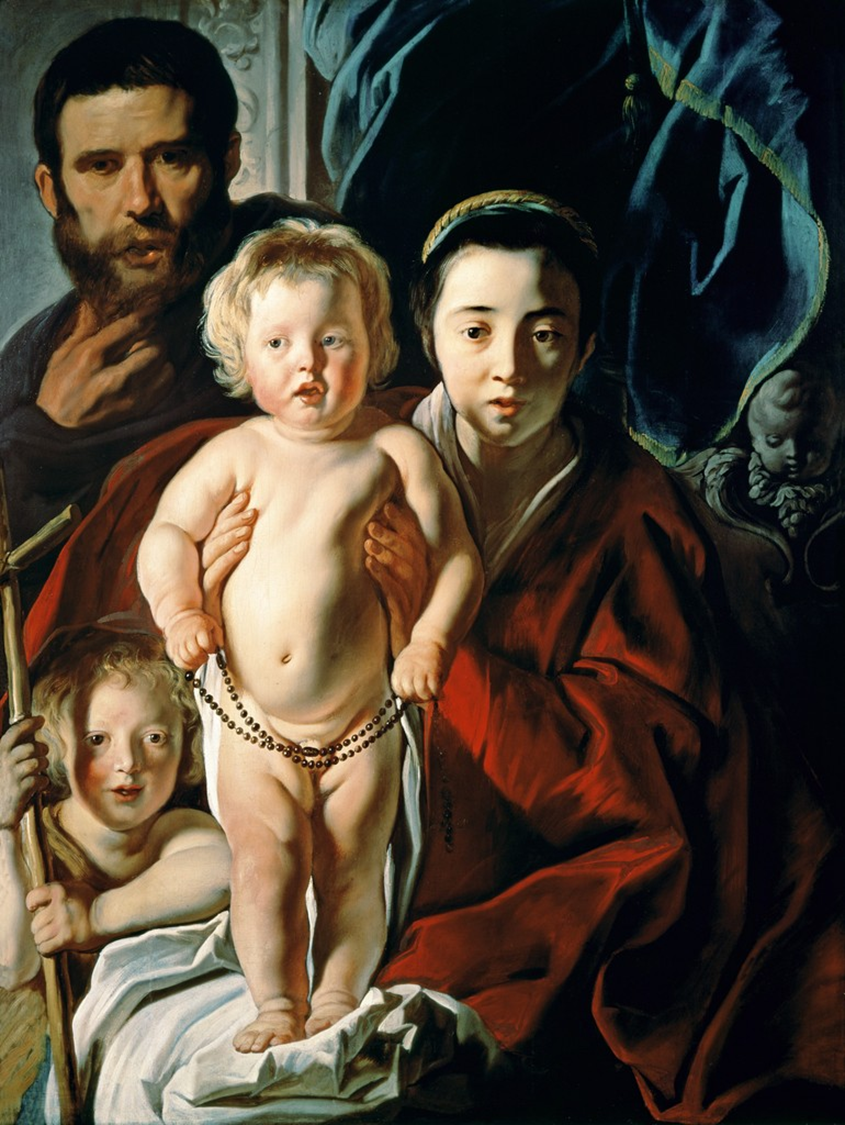
Jacob Jordaens
ca. 1620
Medium
Oil on canvas
Overview
This painting presents a domestic, intimate vision of the Holy Family—Mary, Joseph, the Christ Child, and the young St. John the Baptist—interacting in a warm, naturalistic setting. It exemplifies the Flemish Baroque approach to religious themes: emotionally immediate, physically robust, and suffused with light and vitality.
Visual & Formal Analysis
Composition: The figures are gathered in a tight, pyramidal group, enhancing a sense of intimacy.
Emotion & Interaction: The expressions are affectionate and focused on the children, emphasizing familial bonds. The Virgin often looks tenderly at Jesus, while Joseph and John form the outer framework, directing attention inward.
Children: The Christ Child and John the Baptist are rendered with rosy vitality, playfully engaging with each other—Jordaens often portrayed children with a slightly stocky and exuberant realism.
Light & Color: Rich, warm tones dominate—reds, ochres, and earthy browns—with strong chiaroscuro to model the figures and create a sense of three-dimensionality. The lighting focuses on the central figures, enhancing their spiritual presence while maintaining a naturalistic atmosphere.
Setting: The background is either neutral or softly suggests a domestic interior, reinforcing the humanized, relatable nature of the Holy Family.
Stylistic Characteristics
Influenced by Rubens in terms of muscular forms, emotional expressiveness, and compositional structure.
Jordaens’s style is more robust and grounded, lacking the idealized elegance of van Dyck.
His figures exude a Flemish earthiness, rooted in genre scenes and daily life, giving sacred stories a real-world immediacy.
Function & Message
Intended to inspire devotional intimacy—viewers could connect with the Holy Family not only as sacred figures but also as models of love, tenderness, and domestic virtue.
Reinforces Catholic values of the Counter-Reformation: the sanctity of family, the humanity of Christ, and accessible spirituality.
St. John the Baptist’s presence also alludes to his later role as Christ’s forerunner, though here he is shown as a child—innocence foreshadowing destiny.
Context
Produced during a time when religious art in the Spanish Netherlands was being used to reaffirm Catholic doctrine and encourage personal piety in the wake of the Reformation.
Jordaens, though never traveling to Italy, responded directly to the Italianate trends set by Rubens and Caravaggio, favoring drama, naturalism, and emotional connection.
Comparative Notes
Similar in tone to Rubens’s Holy Family under the Apple Tree or Rest on the Flight into Egypt.
Contrasts with Caravaggio’s more austere, psychological interpretations—Jordaens is lusher and more familial.
Shares thematic resonance with Murillo’s later Spanish Holy Family paintings, though with more physicality and less ethereal softness.
Madonna of the Rosary

Caravaggio
1607
Medium
Oil on canvas
Current Location
Kunsthistorisches Museum, Vienna
Commission & Context
Likely commissioned by a member of the Dominican Order, given the central presence of St. Dominic and the theme of the Rosary.
Created during Caravaggio’s Neapolitan period, marked by a heightened theatricality, grander scale, and more public, communal religious works, in contrast to his earlier private commissions.
This period reflects Caravaggio’s own sense of vulnerability, exile, and a new intensity in his spiritual subjects.
Subject Matter
At the center, the Virgin Mary, seated on a throne with the Christ Child, hands a rosary to St. Dominic (right), the founder of the Dominican Order.
On the left stands St. Peter Martyr, with his palm of martyrdom.
A crowd of supplicants, including a donor (possibly the commissioner), kneels or stands at the bottom, receiving rosaries or gazing upward in awe.
The scene symbolizes the spiritual and salvific power of the Rosary, a key tool of Counter-Reformation devotion.
Formal Analysis
Composition: Monumental, pyramidal, and staged like a sacred theater. The Virgin is enthroned at the apex, visually anchoring the composition.
Chiaroscuro: Caravaggio’s signature tenebrism is fully developed—sharp contrasts between light and dark pull focus to the Virgin, Christ, and saints, while the background is engulfed in shadow.
Color: Rich, saturated reds dominate the Virgin’s cloak and the curtain above—perhaps symbolic of martyrdom and divine authority. Earth tones in the lower figures ground the scene in realism.
Naturalism: The faces and gestures of the figures are unidealized, drawn from real people. The supplicants display emotional urgency—wide eyes, clasped hands, and pleading expressions.
Hierarchy: The painting carefully orchestrates viewer response—divine figures above, humans below, emphasizing intercession and grace through the saints.
Theological & Iconographic Meaning
Promotes Marian devotion and the power of the Rosary to guide souls toward salvation—a key message of Counter-Reformation Catholicism.
The dominance of St. Dominic and St. Peter Martyr reflects the Dominican mission to combat heresy and spread the Rosary devotion.
The human figures below underscore the idea that divine grace is mediated through Church figures—saints as intercessors.
The curtain, dramatically pulled back, suggests a theatrical revelation of the sacred, reinforcing Baroque notions of spectacle and divine immediacy.
Function & Audience
Meant for public display, likely an altarpiece or church commission.
Served both a didactic function (educating about the Rosary’s power) and a devotional one (inspiring prayer and awe).
The inclusion of a donor portrait links the work directly to its patron’s piety and social status.
Comparative Notes
Compositional grandeur and vertical hierarchy are similar to Titian’s and Venetian altarpieces, which Caravaggio would have known.
The theatricality and deep emotional realism align with Caravaggio’s contemporaneous works like the Seven Works of Mercy (1607), also painted in Naples.
Unlike earlier, more intimate Caravaggios, this piece engages a broader communal spirituality, in line with post-Tridentine ideals.
The Calling of Sts. Peter and Andrew
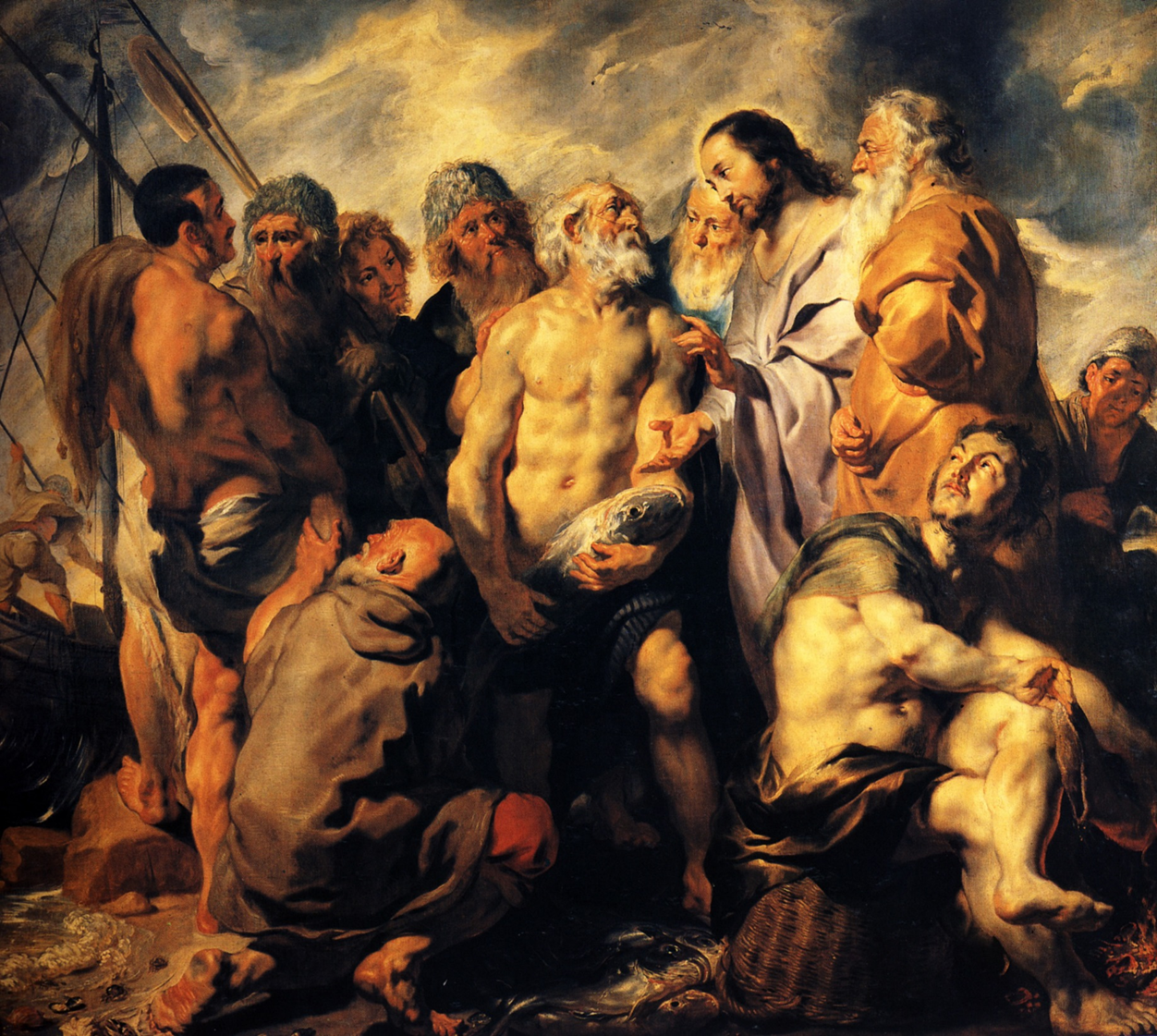
Jacob Jordaens
ca. 1618
Medium
Oil on canvas
Current Location
Museo del Prado, Madrid
Subject Matter
A biblical scene from the Gospels (primarily Matthew 4:18–22 and Mark 1:16–20), where Christ calls the fishermen brothers, Peter and Andrew, to become his disciples, saying:
“Follow me, and I will make you fishers of men.”Christ stands on the shore of the Sea of Galilee, gesturing to Peter and Andrew, who respond with surprise, humility, and attention.
Formal Analysis
Composition: A tightly framed scene with three main figures. Christ, at the left, gestures calmly yet authoritatively, while Peter and Andrew, kneeling or leaning toward him, respond with astonishment.
Light and Color: Influenced by Caravaggisti tenebrism—strong light-dark contrast, especially in the faces and garments. The earthy tones of the fishermen contrast with Christ’s slightly more idealized, luminous form.
Figures:
Christ is shown in a calm, idealized manner, with flowing drapery and a commanding pose.
Peter and Andrew are burly, rugged, and realistic—depicted as laborers, not idealized saints.
Their expressive faces and dynamic gestures reflect emotional immediacy and humanity.
Naturalism: The sea, fishing net, and muscularity of the figures anchor the work in real-world physicality, consistent with Jordaens’ style and Flemish realism.
Gesture & Movement: The moment is suspended at the peak of narrative action—Christ’s calling hand, the brothers’ reactions, and the physical weight of their bodies in motion.
Theological & Iconographic Meaning
The moment of divine calling highlights obedience, humility, and the transformative power of Christ’s word.
Peter and Andrew’s response—immediate and unquestioning—emphasizes apostolic authority and devotion, key messages in Counter-Reformation art.
Their depiction as ordinary men supports the notion that holiness is accessible to all, not reserved for the elite.
Comparative Notes
Jordaens’ Caravaggesque realism contrasts with Rubens’ more idealized and heroic figures.
Similar themes of calling or conversion are found in Caravaggio’s Calling of St. Matthew (1599–1600), though Jordaens replaces urban settings with a natural, seaside context.
Unlike earlier depictions, which might render the apostles more symbolically, Jordaens gives them flesh and labor, anchoring the spiritual moment in the material world.
Related in tone to early Rubens works such as The Miraculous Draught of Fishes (1610s), though Jordaens’ style is generally more grounded and less courtly.
Function & Audience
Likely intended for a church or private devotional setting, meant to inspire reflection on divine calling and humility.
Visualizes a moment of transformation—ordinary men becoming saints through divine encounter—a popular theme in Baroque didactic art.
Rubensian
Refers to something related to or characteristic of the paintings of Peter Paul Rubens, particularly his depiction of full-figured women. It can also describe a woman's figure as being plump and curvaceous.
Portrait of a Young Married Couple
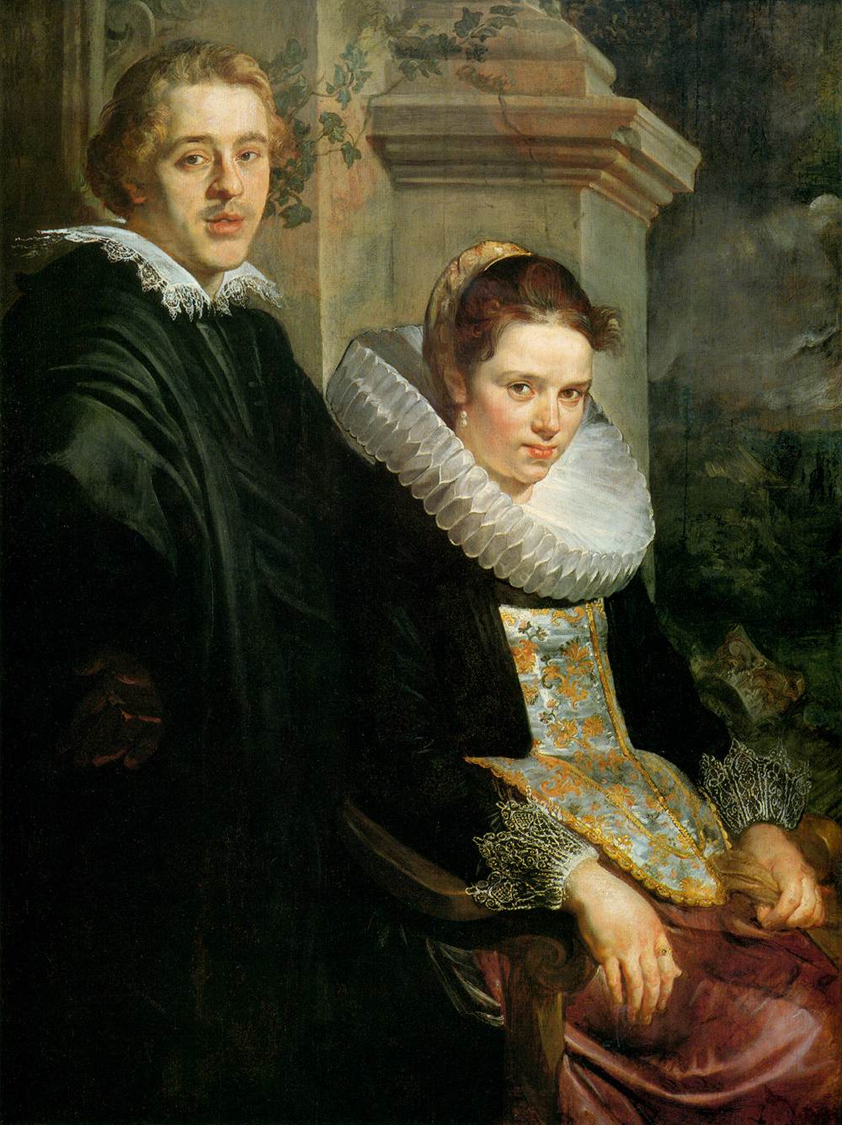
Jacob Jordaens
1615-20
Medium
Oil on canvas
Current Location
Louvre Museum, Paris
Subject Matter
A double portrait of an affluent young couple, likely from Antwerp’s merchant or patrician class.
The sitters are shown seated in a garden setting, with the woman’s hand resting on the man’s arm—a rare gesture of mutual affection and intimacy in early 17th-century portraiture.
A cherub and possibly symbolic flowers or animals appear in the composition, subtly underscoring themes of love, fertility, and harmony.
Formal Analysis
Composition: Balanced yet relaxed. The couple is arranged diagonally, lending a sense of movement and naturalism rather than rigid symmetry.
Gesture & Expression: Both figures look out toward the viewer, but their slight tilt toward one another conveys emotional closeness.
Costume:
The man is dressed in rich black velvet, with a white lace collar and cuffs, denoting status and sobriety.
The woman wears a sumptuous white satin gown with fine lace and jewelry, emphasizing wealth, purity, and elegance.
Background: A garden with trees, vines, and cherubs—symbolic of marital harmony and possibly referencing classical love allegories.
Color & Light: Warm, rich tones with soft illumination create a sense of intimacy and vitality. The textures of fabrics and skin are rendered with Baroque attention to sensual detail.
Naturalism: Jordaens captures individualized features, subtle gestures, and lifelike textures, elevating the portrait above courtly idealization.
Influence of Rubens: Seen in the lush garden, sensual textures, and use of mythological elements to frame the domestic.
Iconographic & Cultural Meaning
A celebration of marital unity, prosperity, and virtuous love.
The positioning of the figures—physically close but with the woman resting her hand on the man—suggests mutual respect and emotional warmth, unusual for the time.
The cherub(s) and garden allude to fertility, Venus, or divine favor in marriage.
Portraits like this served not only to commemorate a union but to assert familial prestige and piety.
Comparative Context
Compared to Rubens’ aristocratic portraits, Jordaens’ figures appear more grounded and physically robust, more bourgeois than courtly.
Similar domestic and symbolic touches can be seen in Anthony van Dyck’s portraits, though van Dyck leans more toward idealization and grace.
The portrait also draws from genre traditions, especially Northern European ones, where symbolic objects (like gardens or animals) quietly convey meaning.
Function & Audience
Likely commissioned to commemorate a recent marriage—possibly part of a dowry arrangement or family estate decoration.
Served to represent the couple’s social status, values, and affection, possibly displayed in a private salon or gallery.
Self-Portrait with Isabella Brandt
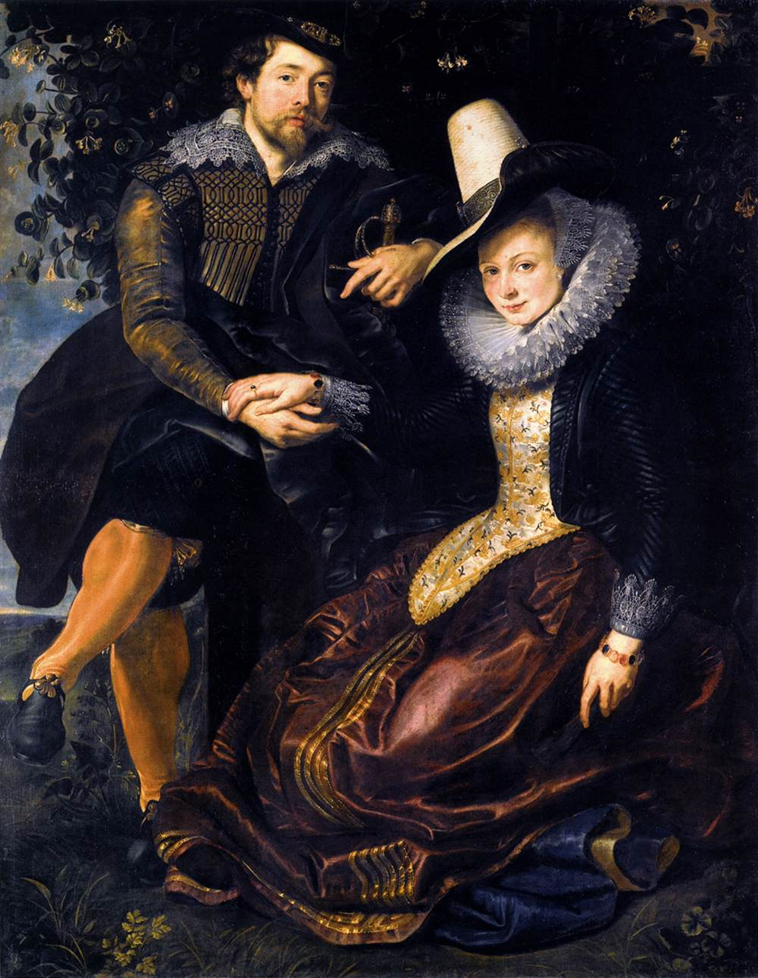
Peter Paul Rubens
1609-10
Known as The Honeysuckle Bower
Medium
Oil on canvas (or oil on panel, depending on source)
Current Location
Alte Pinakothek, Munich
Subject Matter
Rubens and Isabella are depicted seated in a garden bower of honeysuckle, symbolizing love, fidelity, and marital harmony.
Both figures are richly dressed: Rubens in aristocratic black with a rapier (sword), and Isabella in a sumptuous red gown with delicate lace and pearls.
They sit close together, hands intertwined, a deeply personal and tender pose.
The honeysuckle bower framing them was a traditional emblem of conjugal love and faithfulness in Northern Renaissance and Baroque iconography.
Formal Analysis
Composition: Balanced and symmetrical, with the couple forming a gentle arc under the bower—suggesting unity and harmony.
Gesture: Their joined hands rest at the center of the composition, drawing attention to the marriage bond.
Clothing and Accessories:
Rubens wears a stylish wide-brimmed hat, lace collar, and a sword, emphasizing his status as a gentleman and courtier.
Isabella’s elegant attire, pose, and subtle smile project both her dignity and warmth.
Background: The lush garden and honeysuckle vines not only offer visual richness but reinforce the symbolic celebration of love.
Light & Color: Soft, warm lighting bathes the couple in a golden glow, enhancing the sense of domestic bliss. Rich, yet restrained colors reflect their noble yet intimate surroundings.
Naturalism: Both faces are carefully individualized—Rubens gives his own a slightly idealized calm, while Isabella’s expression is genuinely affectionate, with a faint, knowing smile.
Iconographic & Cultural Meaning
Portrait as Love Token: This work functions both as a marriage portrait and a personal celebration of love, companionship, and mutual respect.
The joined hands, garden setting, and intimate composition reflect themes of fidelity, fertility, and intellectual union.
The inclusion of the rapier and formal pose elevates the painting to assert Rubens’ social status—he was recently knighted and had returned to Antwerp with enhanced prestige.
Comparative Context
This portrait can be compared with Jacob Jordaens’ Portrait of a Young Married Couple for its shared emphasis on mutual affection and garden symbolism, though Rubens’ version is more polished and courtly.
Contrasts with Anthony van Dyck’s portraits, which are more idealized and aristocratic in presentation, while Rubens balances grandeur with warmth.
The pose is reminiscent of Renaissance double portraits, like those of Jan van Eyck, but with Baroque softness and vitality.
Function & Audience
Likely intended for private enjoyment, possibly hung in Rubens’ home as a personal commemoration.
It presents Rubens not just as a painter, but as a refined man of the world—a humanist, nobleman, and devoted husband.
Portrait of an Elderly (Old) Man
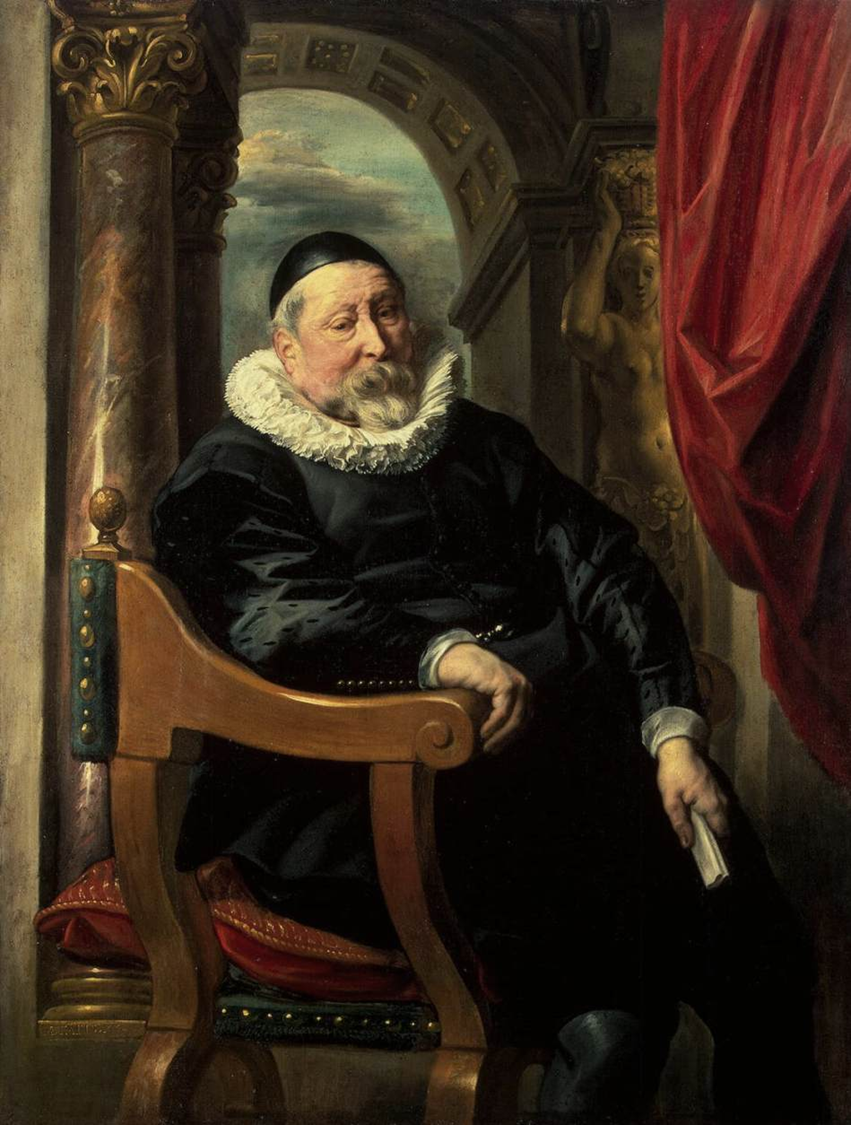
Jacob Jordaens
ca. 1637
Medium
Oil on canvas
Current Location
Likely housed in a European museum or private collection—this specific work is less widely circulated than Jordaens’ genre scenes, but remains representative of his portraiture from the 1630s.
Subject Matter
A three-quarter-length portrait of a bearded older man, seated or standing, rendered with intense realism and dignity.
The sitter may wear dark, formal clothing with a white collar or ruff, typical of 17th-century Flemish bourgeoisie or professional class.
His expression is thoughtful, perhaps a little weary or wise—emphasizing age, experience, and inner character over idealized beauty.
The hands (if visible) may be folded or holding an object, lending further insight into his occupation or status.
Formal Analysis
Naturalism: Jordaens excels at capturing skin texture, facial lines, and the subtle asymmetries of age—eschewing idealization for honesty and vitality.
Light & Shadow: Strong chiaroscuro gives the face volume and a sense of presence, drawing attention to the psychological realism.
Brushwork: Loose and expressive, especially in the background and fabric, but tighter and more focused around the face and hands.
Color: Muted earth tones dominate, with restrained use of color—a somber palette befitting the age and character of the sitter.
Background: Likely dark and neutral, allowing the sitter to emerge from the shadows—typical of Baroque portraiture and creating an intimate focus.
Function & Meaning
This is likely a private commission, intended to commemorate the individual and perhaps honor a life of public or professional service.
The lack of overt symbolism (compared to allegorical works) emphasizes real identity and lived experience—Jordaens’ strength.
It may convey themes of stoicism, dignity in aging, or even familial legacy, depending on whether it was meant for a family collection.
Context
Painted at a time when portraiture was rising in popularity among the merchant and middle classes in Antwerp.
Unlike the idealized elegance of van Dyck, Jordaens’ portraits speak to a more grounded and introspective aesthetic.
Comparable in spirit to Rembrandt’s portraits of elderly men and women, though Jordaens uses richer color and more robust modeling.
The King Drinks
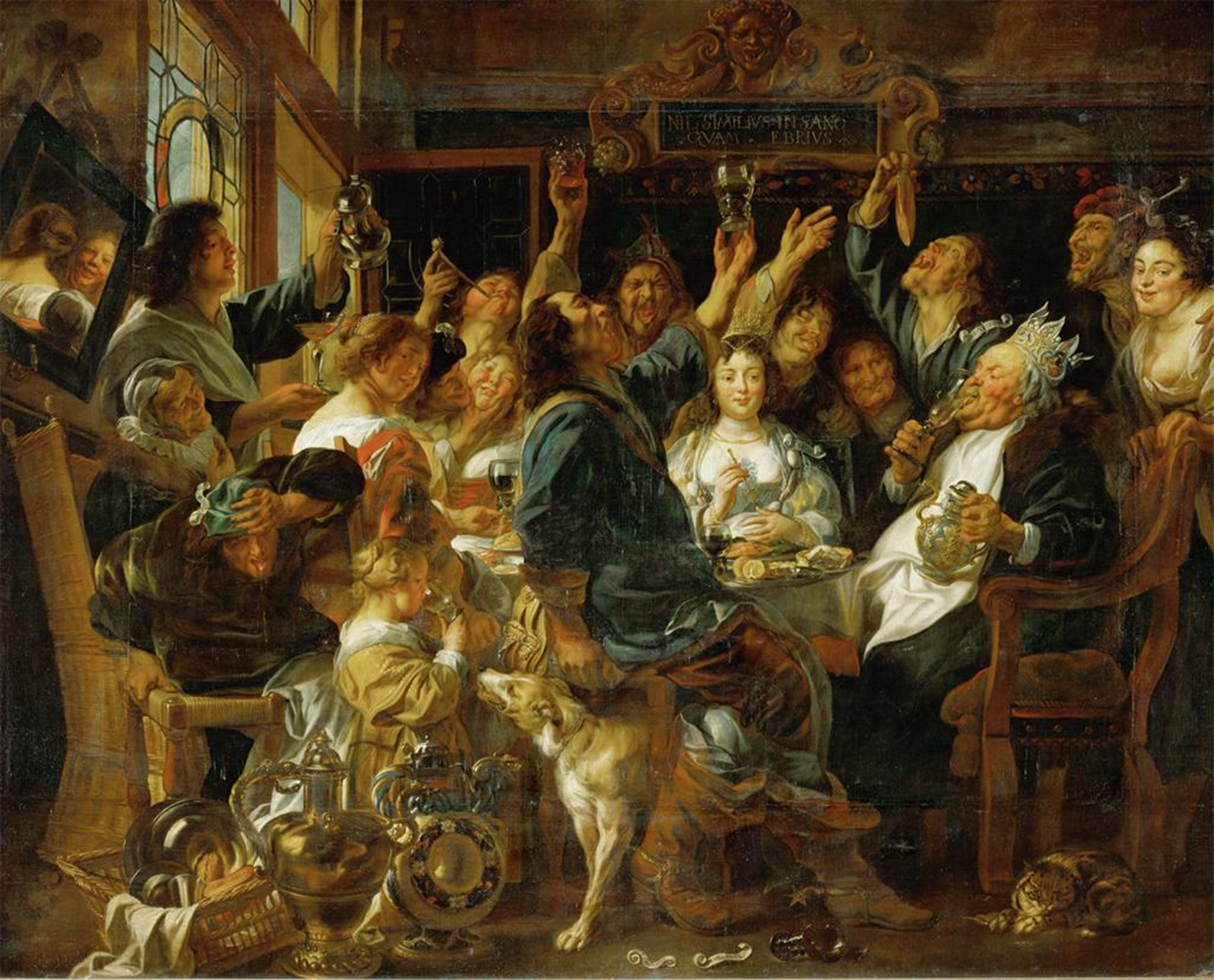
Jacob Jordaens
ca. 1655
Medium
Oil on canvas
Current Location
Several versions exist in museums such as the Royal Museum of Fine Arts, Brussels, the Hermitage Museum, and the Musée des Beaux-Arts de Lille.
Subject Matter
A raucous Twelfth Night (Epiphany) feast, where a man (the “king”) is chosen by lot and celebrated with drink and merriment.
The central figure, often an older man wearing a paper crown, raises a wine goblet high, grinning with flushed cheeks.
He’s surrounded by a crowd of revelers: musicians, children, dogs, and women laughing or joining in.
A child or servant may hold a pie or bring more wine, and animals (especially dogs or cats) add a humorous touch.
Formal Analysis
Composition: Dense and lively, with figures packed tightly, leading the viewer’s eye in a circular rhythm around the central toast.
Color: Warm, rich earth tones with brilliant touches of red, white, and gold—heightening the sense of festivity and bodily warmth.
Light: Often strong interior lighting from the left, enhancing the volumes of figures and the gleam of pewter, glass, and fabric.
Brushwork: Vigorous and increasingly expressive—Jordaens by this point favored broad, painterly strokes with great energy.
Facial Expressions & Gesture: Exaggerated, joyful, and sometimes grotesque—emphasizing the earthiness of human indulgence.
Function & Meaning
More than just a genre scene, this painting carries moral and social commentary.
May refer to the Flemish proverb “As the old sing, so pipe the young”, a frequent theme for Jordaens.
→ Adults’ behavior sets an example—here, the elders’ drinking and bawdiness may reflect generational corruption or harmless folly.Also tied to the custom of Epiphany feasts, where a commoner is crowned “king” for a day—symbolizing reversal of order and Carnivalesque license.
Context
Painted during the post-Rubens generation in Antwerp, when genre painting flourished.
Jordaens’ version of genre scenes had a moralistic but celebratory tone, different from the more restrained Dutch scenes.
Reflects Catholic Flanders’ openness to bodily expression, humor, and satire, unlike Protestant Dutch painting of the same period.
genre scene
Still lives; capture momentary appearances/ responses, Significance in the everyday.
“As the Old Sing, so the Young Pipe”
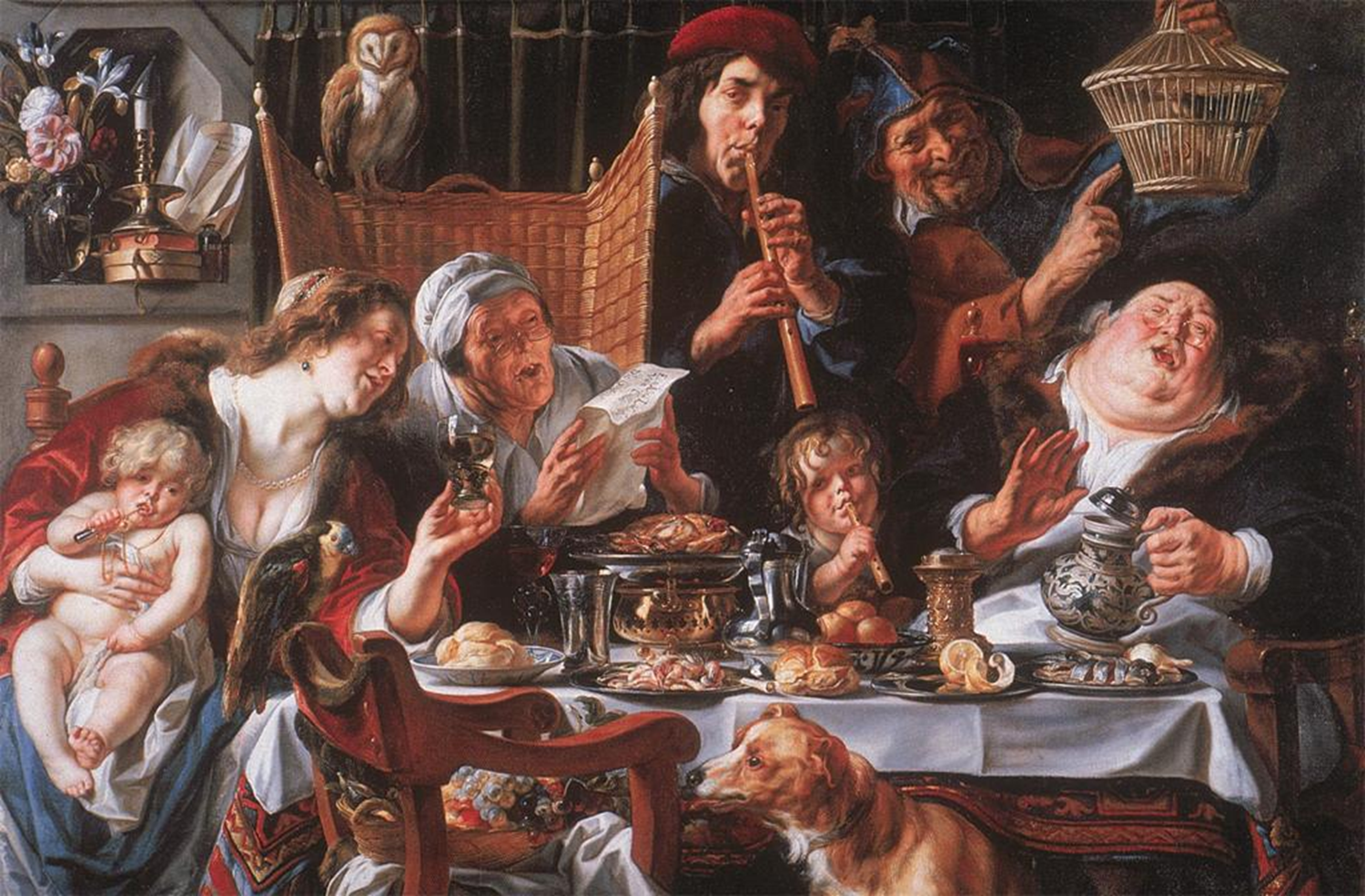
Jacob Jordaens
ca. 1640-45
Title & Proverb
"As the Old Sing, So the Young Pipe" (“Soo d’oude songen, soo pypen de jonge”)
A well-known Flemish proverb warning that children imitate adult behavior, for better or worse.
Jordaens painted several versions of this subject throughout his life.
The ca. 1640–45 version is one of the most refined, likely located in the Mauritshuis, The Hague.
Medium
Oil on canvas
Subject Matter
A domestic scene with three older adults singing boisterously—often a father, mother, and grandmother—while a group of children play pipes or flutes.
A bagpiper (often associated with crude humor) typically accompanies the group.
A parrot, often present, reinforces the theme of mimicry.
Expressions range from cheerful to exaggeratedly grotesque—conveying both humor and warning.
Formal Analysis
Composition: Triangular and tightly knit, focusing on the generational connection—elders above, children below.
Color: Warm and saturated tones—ochres, reds, browns, and glowing highlights—create a sense of intimacy and abundance.
Lighting: Caravaggisti influence with strong chiaroscuro, spotlighting key faces and gestures.
Brushwork: Fluid and confident, with attention to textures of skin, fabric, and fur.
Facial Expressions: Carefully rendered, from open mouths to furrowed brows—heightening emotional immediacy and a touch of the grotesque.
Interpretation & Moral
The proverb serves as a cautionary tale: children mimic what they see.
Jordaens doesn't lecture, but presents the scene with humor and realism, allowing viewers to reflect.
The bagpipe and parrot reinforce mimicry and folly.
The painting may critique moral decay, parenting, or simply celebrate the vitality of family life.
Cultural & Artistic Context
Part of a long Netherlandish tradition of moralizing genre scenes, going back to Bruegel.
In Catholic Flanders, such scenes could be earthy and exuberant while still moral in tone.
Contrasts with more restrained Dutch Calvinist genre scenes (e.g. Jan Steen, who painted similar themes with more irony).
Jordaens’ background in tapestry design is reflected in his attention to texture and layering.
Legacy
As the Old Sing, So the Young Pipe became one of Jordaens’ signature compositions.
It was widely copied and engraved, and its theme remains relevant: how do adults shape the young through example?
Comparison to The King Drinks
Both works explore intergenerational dynamics, festivity, and behavior.
The King Drinks emphasizes excess and revelry; As the Old Sing is more didactic and family-focused.
Both offer a blend of satire and affection, showing Jordaens’ gift for making morality deeply human and relatable.
Assumption of the Virgin
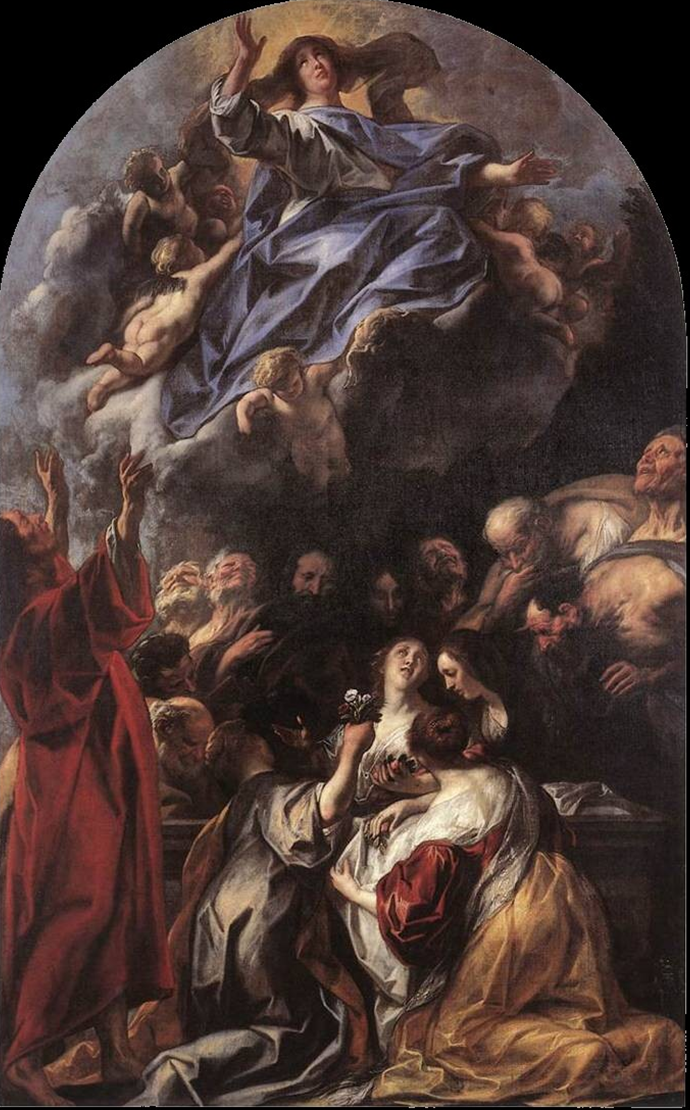
Jacob Jordaens
ca. 1655
Medium
Oil on canvas
Likely painted for an altarpiece, possibly in Antwerp or nearby.
Composition
Divided into two registers:
Lower level: Apostles and witnesses—some gesturing, others in awe—cluster around the empty tomb.
Upper level: The Virgin, in luminous robes, is lifted by angels, ascending toward Heaven, surrounded by divine radiance.
Central, vertical axis emphasizes spiritual ascension and hierarchical divine order.
Formal Elements
Color: Rich jewel tones—especially deep blues, golds, and reds—emphasize Mary's sacred status.
Light: Brilliant heavenly light highlights Mary, drawing the viewer’s eye upward in an almost cinematic burst of radiance.
Movement: Flowing drapery, swirling clouds, and gesturing figures create Baroque dynamism.
Figures: Expressive and robust—Jordaens’ figures are solid, energetic, and deeply emotional.
Brushwork: Energetic but controlled, with soft modeling that evokes Rubens’ influence.
Theological Significance
Reinforces Catholic doctrine of the Assumption, emphasized during the Counter-Reformation.
The painting acts as a visual affirmation of faith, glorifying Mary and suggesting the reward of divine grace.
Artistic Influences
Rubens: Jordaens draws on Rubens' 1626 Assumption of the Virgin (Cathedral of Antwerp), but infuses it with his own earthy strength and emotional directness.
Italian Baroque: Influence of Caravaggio and Carracci seen in dramatic light and muscular forms.
Interpretation
Jordaens' Virgin is both majestic and human—a relatable spiritual figure.
The apostles’ emotional variety—ranging from awe to confusion—invites viewer empathy and reflection.
Emphasizes the triumph of divine love, suggesting that Mary’s bodily assumption foreshadows the promise of eternal life for all believers.
Legacy
Though less famous than Rubens’ version, Jordaens’ Assumption remains a powerful example of late Baroque religious painting in Flanders.
It shows how Protestant artists in Catholic Flanders could navigate religious subjects with devotion, craft, and flair.
A synthesis of theatricality, devotion, and human warmth—hallmarks of Jordaens’ sacred works.
Calvinism
Calvinism teaches that the glory and sovereignty of God should come first in all things. Calvinism believes that only God can lead his church—in preaching, worship, and government. And Calvinism expects social change as a result of the proper teaching and discipline of the church. Jacob Jordaens converted in 1655.
Still-Life with Bouquet of Flowers
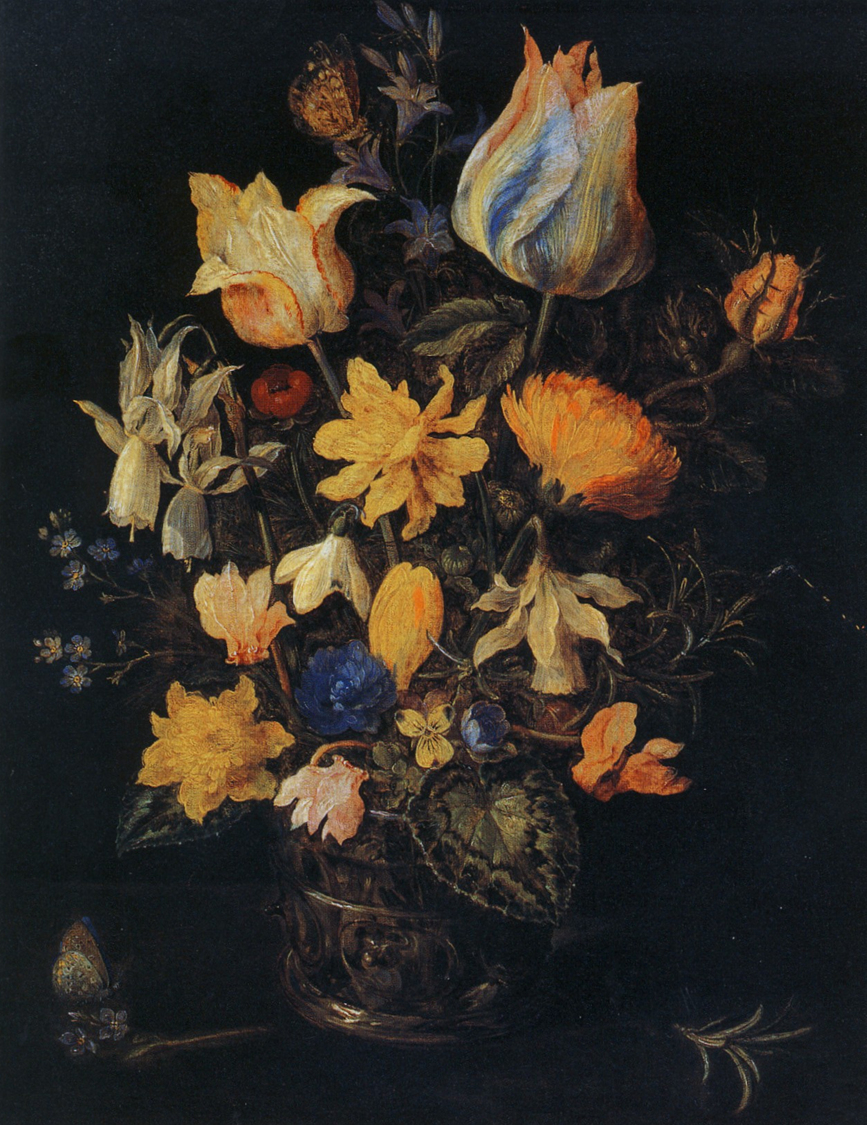
Jan Brueghel, the Elder
ca. 1607
Title
Still-Life with Bouquet of Flowers
Also known as Flowers in a Glass Vase.
Among the earliest examples of the flower still-life as an independent genre.
Not a real bouquet, but a composite of blossoms from different seasons, arranged with idealized naturalism.
Date
ca. 1607
Early in Brueghel’s mature period.
Coincides with the scientific curiosity and botanical exploration of the era.
Reflects Antwerp’s role as a hub of trade, science, and collecting.
Medium
Oil on panel or copper
Copper was often used for these paintings: allowed for extreme detail, smooth surfaces, and preservation of color.
Composition
A single glass vase, often placed on a stone ledge.
Contains a dense and diverse bouquet: tulips, roses, irises, peonies, marigolds, and more.
Often includes insects (butterflies, beetles), snails, or drops of water, heightening the sense of naturalism.
Flowers overlap, twist, and cascade, showing Brueghel’s attention to botanical structure and elegance.
Formal Elements
Color: Brilliant, varied palette—each bloom rendered in rich, luminous color.
Light: Soft, even lighting enhances surface textures and subtle shading.
Detail: Microscopic precision—each petal, stamen, and leaf is lovingly articulated.
Space: Shallow depth, focusing attention on the bouquet itself.
Brushwork: Fine, controlled—especially suited to copper support.
Symbolism and Meaning
Often read as a memento mori: beauty is fleeting, nature is impermanent.
The inclusion of insects, fallen petals, or wilting blooms reinforces this theme.
Reflects a scientific interest in flora—many flowers were rare imports from Asia or the New World.
May have functioned as a cabinet piece—artwork for private contemplation and collecting.
Context
Part of the emerging genre of flower painting in the early 17th century.
Tied to the Catholic Counter-Reformation’s celebration of natural beauty as divine creation.
Also reflects Dutch and Flemish interest in collecting, classification, and study—linked to botanical gardens and herbals.
Legacy
Jan Brueghel was a pioneer in flower still-life.
Influenced artists like Daniel Seghers, Rachel Ruysch, and Jan Davidsz de Heem.
His floral still lifes are seen as scientific, devotional, and aesthetic objects, blending art and nature with elegance.
vanitas
Genre of memento mori symbolizing the transience of life, the futility of pleasure, and the certainty of death, and thus the vanity of ambition and all worldly desires. The paintings involved still life imagery of transitory items. The genre began in the 16th century and continued into the 17th century.
Still life with Parrots
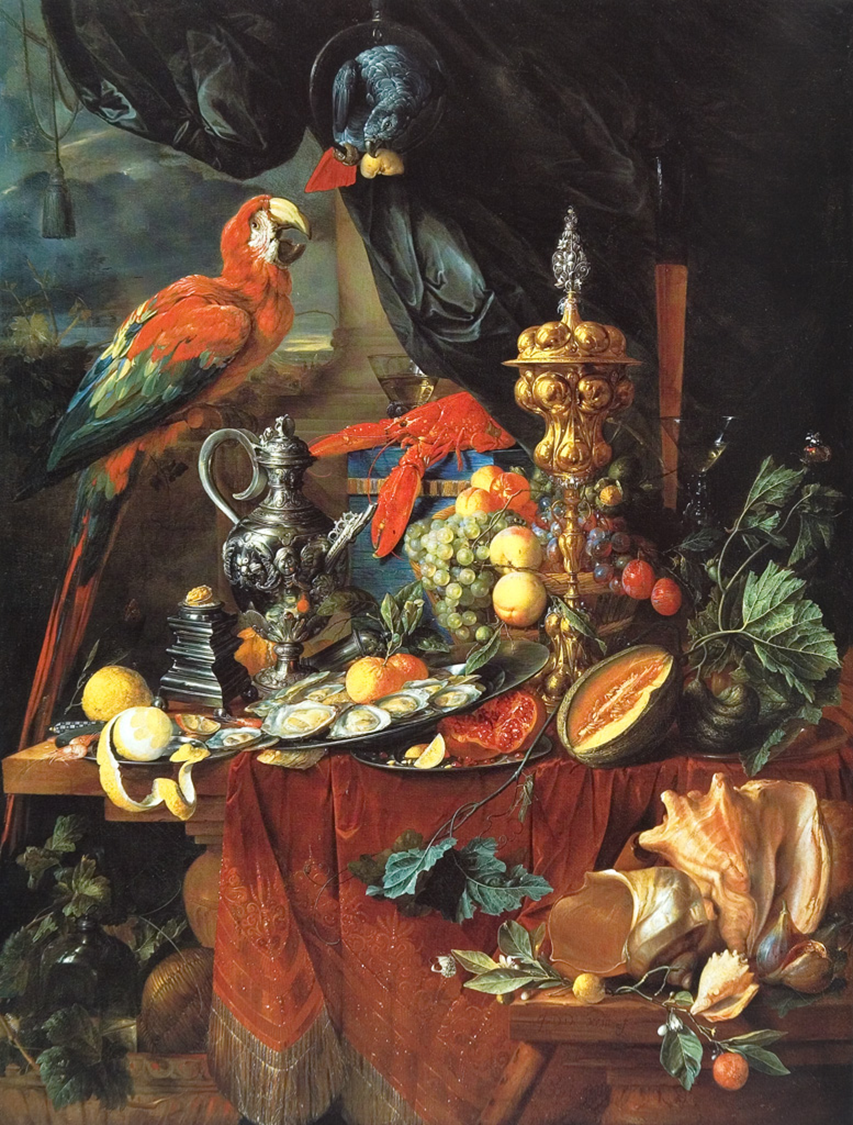
Jan Davidz de Heem
1640-45
Date
ca. 1640–1645
Created during the height of the Dutch Golden Age, when the Dutch Republic was a leader in trade, exploration, and cultural development.
The period also coincides with prosperity in the Netherlands and growing demand for luxurious and exotic items, especially from the East Indies.
Medium
Oil on canvas
Classic medium for Dutch still lifes, offering the ability to create vivid colors and textures.
Composition
The painting features a sumptuous array of objects:
Exotic fruits, such as pineapples, oranges, and pomegranates, showcasing the wealth of the era.
Colorful parrots, symbolizing luxury and the exotic.
A decorative glass vessel or bowl, often containing a flower arrangement or grapes, placed next to the fruit.
Insects (flies or bees) are occasionally included, a feature often used in still-life painting to underline the transient nature of beauty.
The parrots often serve as an exotic accent, underscoring both the artist's technical skill and the wealth generated by global trade.
Formal Elements
Color: The bright and contrasting colors of the parrots, fruits, and flowers stand out against the dark background, emphasizing the detail of each object.
Lighting: Soft, naturalistic lighting illuminates the scene, highlighting the texture of the fruits, feathers, and glass.
Texture: Masterful rendering of textures—from the glossy shine of the glass to the softness of the fruit and the delicate feathers of the parrots.
Detail: Hyper-realistic detail, especially in the depiction of the parrots’ feathers, the texture of the fruit skins, and the light reflections on the glass.
Space: The objects are tightly arranged, with overlapping elements that create a dense, rich effect.
Symbolism and Meaning
Exoticism and Wealth: The parrots and exotic fruits are symbols of the wealth and luxury of the Dutch Golden Age, where the Dutch East India Company (VOC) brought back goods from Asia and the New World.
Vanitas: The parrots’ fleeting nature and the decaying fruits can also be interpreted as a memento mori, reminding viewers of the ephemeral nature of life.
The Transience of Beauty: The insects, fading fruit, and perishable nature of the arrangement serve as a reminder that beauty and wealth are transient.
Symbol of Status: Still lifes like this were often commissioned by wealthy patrons and served as symbols of status, showcasing both the luxury and intellectual culture of the owner. They also represented the Dutch obsession with naturalism and the desire to capture the wonders of the world.
Context
During the Dutch Golden Age, the Netherlands experienced a flourishing of art, trade, and cultural exchange.
The Dutch East India Company brought exotic goods into Europe, and items like parrots became status symbols for wealthy collectors.
This period saw an explosion of still-life painting, where artists like de Heem specialized in rendering luxury objects with incredible detail.
The growing middle class in the Netherlands, with its access to trade and cultural capital, provided a steady demand for these types of works.
Still life paintings often reflected the emerging scientific interest in the natural world and the fascination with exoticism.
Legacy
Jan Davidsz de Heem is considered a master of still life and his works, such as Still Life with Parrots, are among the finest examples of the genre.
His detailed renderings of flowers, fruits, and animals influenced later artists, and he is regarded as one of the foremost Dutch Golden Age still-life painters.
The luxurious objects in his paintings serve as a celebration of the art of collecting during the period and have maintained their appeal for collectors and museum-goers alike.
Pronk stil-leven
showy still-lives
It refers to a style of still life painting popular in the 17th century Netherlands, characterized by elaborate displays of luxury goods, fruits, and other items, often arranged on a rich surface like a carpet-covered table.
fijnschilder
Translates to "fine painter" or "fine school" in Dutch. It refers to a style of painting developed in the 17th century in Leiden, Netherlands, characterized by meticulous detail, small-scale works, and a focus on creating realistic representations of everyday life. Artists like Gerrit Dou, Frans van Mieris Sr., and Adriaen van der Werff were known for their fijnschilder style.
Still-life with Poultry and Venison
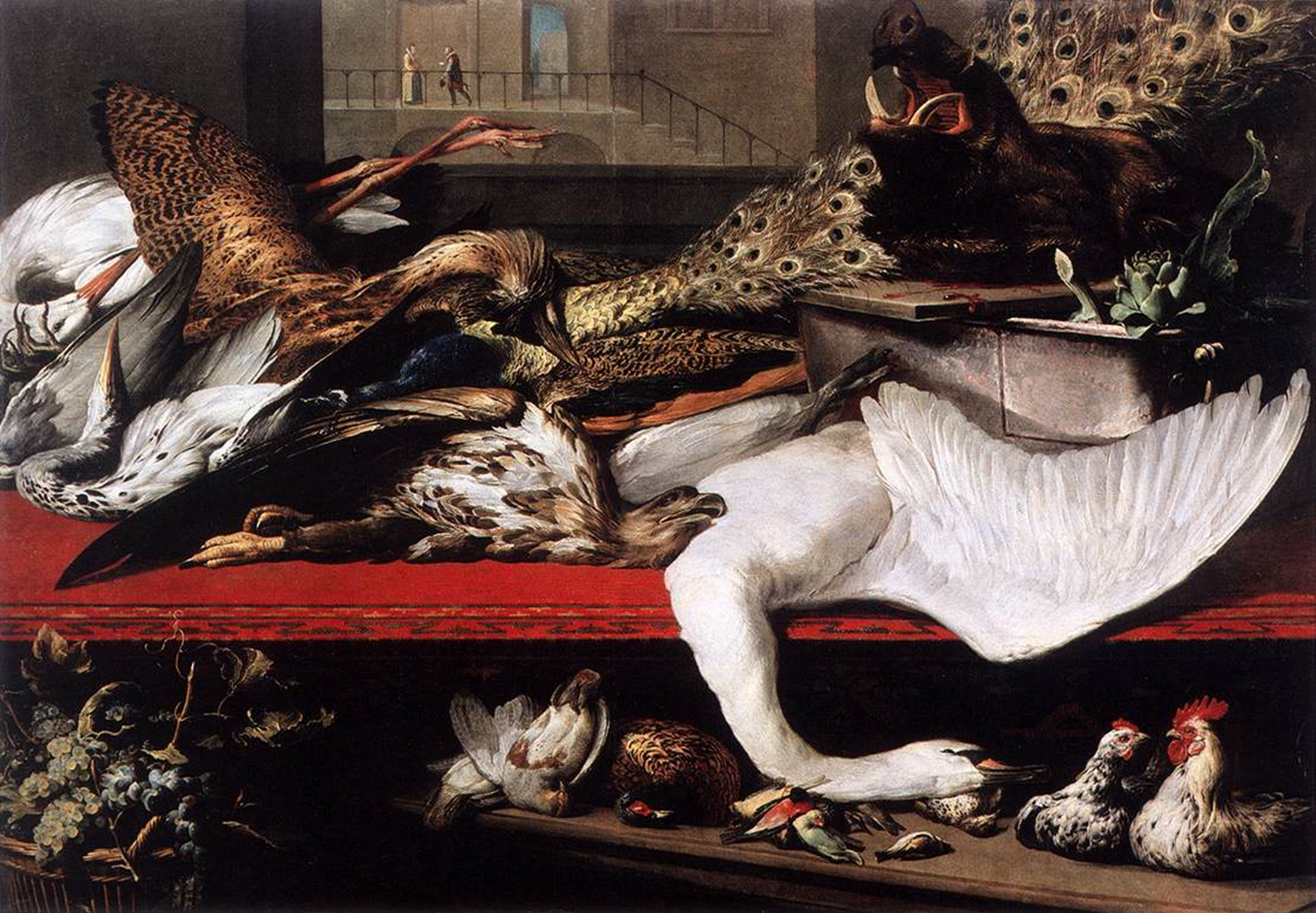
Frans Snyders
1614
Date
1614
This is a typical early 17th-century Flemish still life where the Dutch and Flemish artists were mastering the depiction of realism in both the objects of nature and the symbolism tied to them.
The early 1600s in Flanders saw the rise of specialized genres such as still life, with a particular focus on the luxury market, showcasing both natural bounty and exotic trade goods.
Medium
Oil on canvas
As with many Flemish still lifes, the oil on canvas technique allowed for vivid, realistic textures—a hallmark of Snyders' work.
The medium also provided the flexibility to show complex textures like the plumpness of poultry, the gleaming surface of venison, and the tactile quality of natural elements.
Composition
The composition is bountiful and dynamic, showcasing a variety of game birds such as ducks and pheasants, as well as cuts of venison.
The game birds are often seen with their feathers arranged to show off their iridescent plumage, while the venison is often partially carved, showcasing meaty texture with juicy cuts.
The placement of the objects gives a sense of abundance—a feast for the eyes—with richly detailed foodstuffs laid out across the canvas.
There may also be hunting tools or other farming implements incorporated into the scene, subtly referring to the labor of hunting and its link to wealth and social status.
Formal Elements
Color: The composition features earthy tones that celebrate the textures of meat, feathers, and the shine of polished surfaces (such as glassware or metallic items). The warm browns and deep reds contrast against the pale skin of the poultry and venison.
Lighting: The dramatic lighting in Snyders' works highlights the textures of the meats and the sheen of feathers, making them seem almost tangible.
Detail: Incredible detail is given to every element, from the feathers of the poultry to the marbling of the venison. Snyders was a master of showing light reflection, such as how it bounces off the glistening surface of the meat.
Space: The cluttered composition creates a sense of fullness and overflowing abundance, often used in Flemish still life to underscore the theme of material wealth.
Symbolism and Meaning
Abundance and Luxury: The display of meats and poultry reflects the wealth of the owner and the growing consumer culture in the Flemish and Dutch Golden Age.
Vanitas: The scene can also be interpreted as part of the vanitas tradition, which uses the abundance of food to remind the viewer of life's fleeting nature. The display of game and meat could reflect the finiteness of pleasure and impermanence of material goods.
Symbol of Mastery: The incredibly detailed rendering of the game animals and venison demonstrates the artist’s technical mastery and could be seen as a visual representation of Snyders’ skill in capturing nature’s intricacies.
Hunting and Social Status: The venison and poultry suggest the luxury that comes from hunting, which was historically a pastime of the aristocracy. The presence of such game animals symbolizes the privileged status of those who could afford these expensive meats.
Context
During the 17th century, Flemish artists, particularly in Antwerp, developed an extraordinary mastery in painting still lifes as they capitalized on the growing market for luxury goods.
The Dutch and Flemish trade networks brought exotic and luxurious goods into Europe, contributing to an increased interest in capturing the wealth and variety of items available in this period.
The still-life genre was highly popular with wealthy patrons, who saw these works as a means of displaying both their taste and wealth.
Legacy
Frans Snyders is considered one of the foremost masters of Flemish still life and his work influenced later generations of still-life painters, including Jan Davidsz de Heem and Willem Kalf.
His dynamic and detailed animal and food depictions continue to be admired for their vivid realism and their capacity to evoke both luxury and mortality.
Snyders’ ability to render natural textures with such precision continues to be a benchmark for still-life painters even today
baroque still-lives
Popular in the 17th century, often explored the theme of vanitas, which means "the vanity of vanities." These paintings conveyed the fleeting nature of earthly pleasures and the inevitability of death, often through symbolic imagery like skulls, hourglasses, and fading flowers. They also served to demonstrate an artist's technical skill and love for detail, especially in depicting textures and light.
Bitter Drinks

Adriaen Brouwer
ca. 1630
Date
c. 1630
This piece was created during Brouwer's time in Antwerp, where he worked in the early 17th century, a period marked by the growing interest in genre painting.
Brouwer was also influenced by Dutch realism, which captured everyday life in stark detail, often emphasizing realistic and gritty depictions of ordinary people and their habits.
Medium
Oil on Panel
Brouwer typically used oil on panel for his works, which allowed him to achieve intricate detail and create lively, expressive textures in his figures and surroundings.
His style was characterized by bold brushwork and a dramatic use of light and shadow, often seen in his representations of faces and figures.
Composition
The composition of the painting focuses on a single figure, the man holding the glass of bitter drink, who occupies the foreground.
His face is typically worn, possibly reflecting the effects of alcohol consumption.
Brouwer often used expressive facial gestures to communicate the psychological state of his subjects, in this case, suggesting the unpleasant nature of the drink or the grim reality of overindulgence.
The background is typically minimal, often focusing on the immediate experience of the subject and highlighting facial expressions and gestures.
Formal Elements
Color: The palette of the painting is earthy and muted, with tones of brown, red, and yellow often dominating. This reflects the grittiness of the subject matter and the intimate, close-up nature of the scene.
Lighting: Brouwer uses strong contrasts of light and dark (chiaroscuro), bringing attention to the subject’s face and the expression of distaste as he drinks.
Brushwork: The brushwork is loose yet precise, capturing the roughness and texture of the subject’s face and hands. Brouwer’s characteristic vivid realism shines through in the facial features and emotions of his figures.
Emotion: The figure’s expression conveys a sense of discomfort or displeasure, which might be indicative of the negative effects of drinking. His emotive reaction captures the human flaws Brouwer often explored in his work.
Symbolism and Meaning
Alcoholism and Intoxication: Bitter Drink can be seen as a commentary on the dangers of overindulgence in alcohol. The unpleasant reaction of the figure suggests a warning about the consequences of such behavior.
Human Folly: Brouwer often painted people in situations of drunkenness or excess, capturing the human follies of pleasure-seeking and excess. His works often reflect moral lessons about the emptiness or unpleasantness of such indulgence.
Social Commentary: The depiction of a common person drinking suggests a critique of social behavior among the lower classes, yet it also serves as a universal reflection on human vice.
Psychological Depth: Brouwer’s skillful rendering of facial expressions and bodily gestures reveals a deep understanding of human psychology, emphasizing the emotional responses of the figure to the act of drinking.
Context
During the Dutch and Flemish Baroque period, genre painting became increasingly popular, with artists like Brouwer specializing in everyday life and depictions of ordinary people.
Brouwer was part of the tradition of artists that explored moral themes through intimate genre scenes, often exposing the less flattering aspects of society.
The 17th century also saw the rise of still-life and genre scenes in response to an increased focus on materialism, individuality, and humanism, reflecting both the richness and flaws of human life.
“rough brush” style
in art generally refers to a painting technique that uses bold, visible brushstrokes to create a textured and energetic effect, often evoking a sense of dynamism or movement. It's not directly synonymous with "baroque style," but it can be a characteristic used in baroque paintings.
This style involves using brushstrokes that are not smoothly blended or blended at all. Instead, the brushstrokes are left visible and often create a textured surface. This can be achieved by applying paint with a dry brush or using thicker, more visible strokes.
Picture Gallery of Cornelis van der Geest
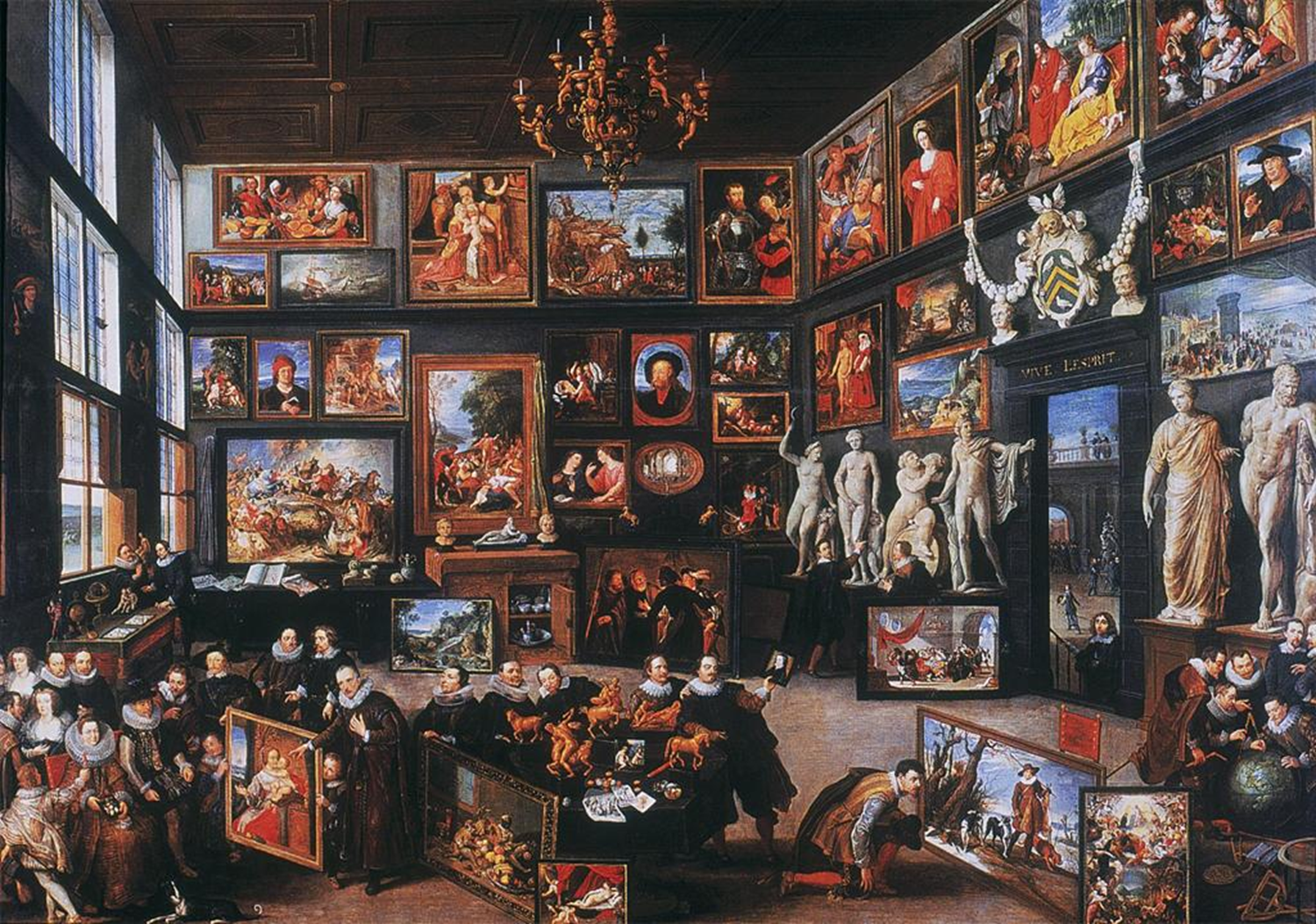
Willem van Haecht
1628
Date
1628
The painting was completed during the Baroque period, a time when art collecting was highly fashionable among the European elite.
The 17th century saw the rise of private art collections as a means of displaying wealth, taste, and intellectual achievement.
This work was created when Flemish art was flourishing, influenced by both the Italian Baroque and the rise of the Dutch Golden Age, which brought a focus on realism and depictions of everyday life.
Medium
Oil on Canvas
Van Haecht, like many of his contemporaries, used oil paints to achieve fine details and rich textures in the depiction of the paintings and sculptures within the gallery.
The use of oil paint allowed van Haecht to capture the depth and luminosity of the art objects and the reflections in the glass frames.
The medium was also ideal for capturing the interior of the gallery, with the play of light and shadow creating a realistic and immersive environment.
Composition
Picture Gallery of Cornelis van der Geest is a large interior scene depicting a spacious gallery filled with paintings and sculptures displayed on walls and pedestals.
In the foreground, there are figures (such as Cornelis van der Geest and his guests) admiring the art, engaging in conversations, or pointing to works that attract their attention.
The scene is carefully organized, with attention to perspective and the arrangement of the artworks. The architecture of the gallery and the space between the figures creates a sense of depth and balance.
Formal Elements
Lighting: The light is carefully controlled, with certain paintings and sculptures illuminated by natural light streaming through windows, while others are shrouded in shadow, creating a sense of mystery and depth.
Color: Van Haecht uses a rich palette of earthy tones—reds, browns, and ochres—that create a warm, inviting atmosphere. The vibrant colors of the art objects contrast with the neutral tones of the room and the figures, bringing the viewer’s attention to the paintings and sculptures on display.
Detailing: The artist’s attention to detail is evident in the intricate frames of the paintings, the reflective surfaces of the glass, and the textures of the wooden furniture and architectural elements. The realistic portrayal of the artworks on the walls serves as both an artistic statement and a tribute to the art of collecting.
Figures: The individuals in the scene are depicted with distinct expressions and postures, emphasizing their roles as collectors, viewers, or admirers of the works around them. Their gestures convey appreciation and intellectual engagement with the art.
Symbolism and Meaning
Art as a Reflection of Status: The painting depicts the high status of Cornelis van der Geest, who, like many wealthy collectors of the time, amassed a collection to show his wealth, taste, and intellectual sophistication.
The Artist's Role: The scene underscores the importance of the artist as part of the cultural elite in the 17th century. The displays of art are symbolic of the artist’s role in shaping cultural identity and preserving the intellectual achievements of society.
Art Collecting as a Moral Pursuit: During this period, art collecting was also seen as a moral endeavor that reflected patronage of the arts and cultural preservation. The careful curation of an art collection was considered a means of supporting the arts and furthering civilization.
Historical Context
The Rise of the Art Market: The early 17th century was a period of great flourishing for art markets, especially in Flanders and the Netherlands, where wealthy individuals, such as Cornelis van der Geest, began to collect paintings from well-known artists.
Patronage: The relationship between artists and patrons was crucial in this period. Collectors like van der Geest played a key role in the production and distribution of art, making private galleries an important symbol of cultural sophistication.
Baroque Art: The painting is representative of the Baroque style, with its realistic rendering of objects, dramatic lighting, and emotional depth. The Baroque period was defined by a passion for artifice, decorative grandeur, and the exploration of human emotions through visual means.
Legacy
Willem van Haecht's Picture Gallery of Cornelis van der Geest became one of the defining works of the genre of gallery paintings in the Flemish Baroque.
The painting offers a glimpse into the world of art collecting during the early 17th century and highlights the cultural importance of art in shaping social identity and elite culture.
Van Haecht's detailed representation of the gallery space influenced later artists who would focus on the depiction of art collections and the intellectual environment of art patronage.
“art collection” paintings
Unique to Flanders. A painting featuring a collection of other paintings, or paintings within a painting, is a common theme in art history. This can be a self-portrait with a painting in the background, a scene of an art gallery or museum, or even a painting depicting paintings as part of a larger narrative. The term for this concept is often referred to as "painting within a painting" or "a painting of paintings".
Taste
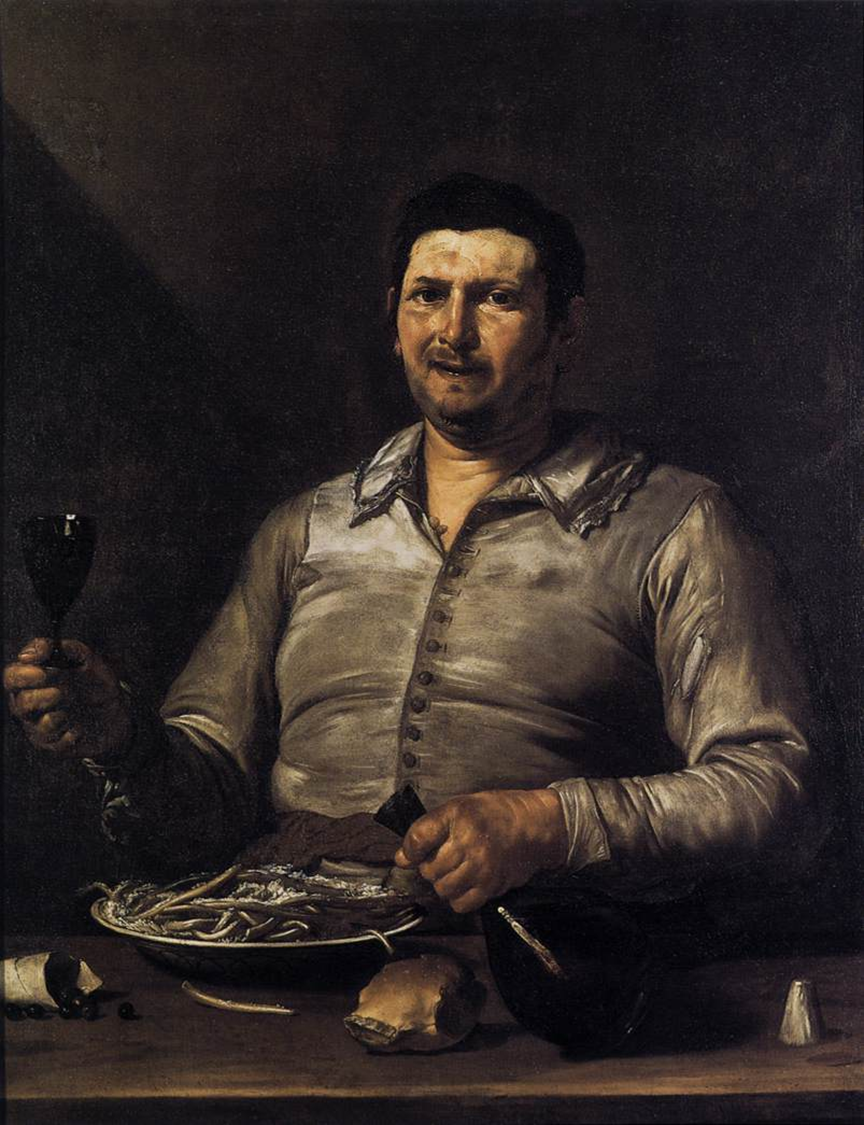
Jusepe de Ribera
ca. 1615
Date
ca. 1615
One of Ribera’s early works, painted not long after his arrival in Naples.
Reflects the Caravaggesque influence he absorbed while possibly studying or working in Rome.
The early 17th century saw a rise in allegorical painting, especially among Caravaggio’s followers, who added realism and earthiness to traditional subjects.
Medium
Oil on canvas
Ribera uses the medium to its fullest, achieving rich textures, naturalistic flesh tones, and dramatic contrasts of light and dark.
The heavy, tactile use of oil paint adds to the sensory impact of the subject—appropriate for a painting about taste.
Composition
A single male figure is shown in three-quarter view, grinning as he chews or eats, with food and drink present—often a roast bird, bread, and wine.
The figure may appear somewhat grotesque, unidealized, and earthy, in line with Ribera’s interest in the lower classes and raw physicality.
The background is dark, setting off the figure dramatically through tenebrism, a hallmark of Ribera’s style and his Caravaggesque influences.
Formal Elements
Chiaroscuro: Strong contrast between the light-struck face and dark background, heightening the physical immediacy of the act of eating.
Color: Warm tones dominate—browns, reds, and flesh hues—creating a visceral feel. The limited palette enhances the material reality of the subject.
Texture: Ribera excels in rendering textures: grizzled hair, coarse cloth, greasy fingers, and the succulent sheen of food.
Expression: The man’s grimace-grin borders on comedic or even grotesque, emphasizing the bodily pleasure and perhaps even gluttony tied to taste.
Symbolism and Meaning
Taste is portrayed in a deeply earthly, even base, way—a far cry from idealized or philosophical allegories.
Ribera draws attention to the physicality of sensory experience, emphasizing flesh, food, and pleasure.
The work may reflect a counter-Reformation interest in the mortality and physical reality of the body—or a moralizing undertone against indulgence.
The unrefined character could represent common humanity or even a mocking take on sensual indulgence.
Historical Context
Caravaggism was sweeping through Italy and Spain in the early 1600s, with artists like Ribera embracing realism and drama.
In Naples, Ribera became the leading painter of his generation, catering to both local patrons and Spanish collectors.
The theme of the Five Senses was part of a broader intellectual tradition linking philosophy, science, and the arts, but Ribera’s treatment reflects a more humanistic and earthy approach.
Legacy
Ribera’s Taste is a powerful example of how genre painting, allegory, and Caravaggism intersected in the early Baroque.
His intense realism influenced later artists like Velázquez and Zurbarán, and his approach to allegorical types became a model for naturalistic depictions of common people in grand subjects.
Today, the painting is admired for its psychological depth, raw immediacy, and masterful technique.
Drunken Silenus
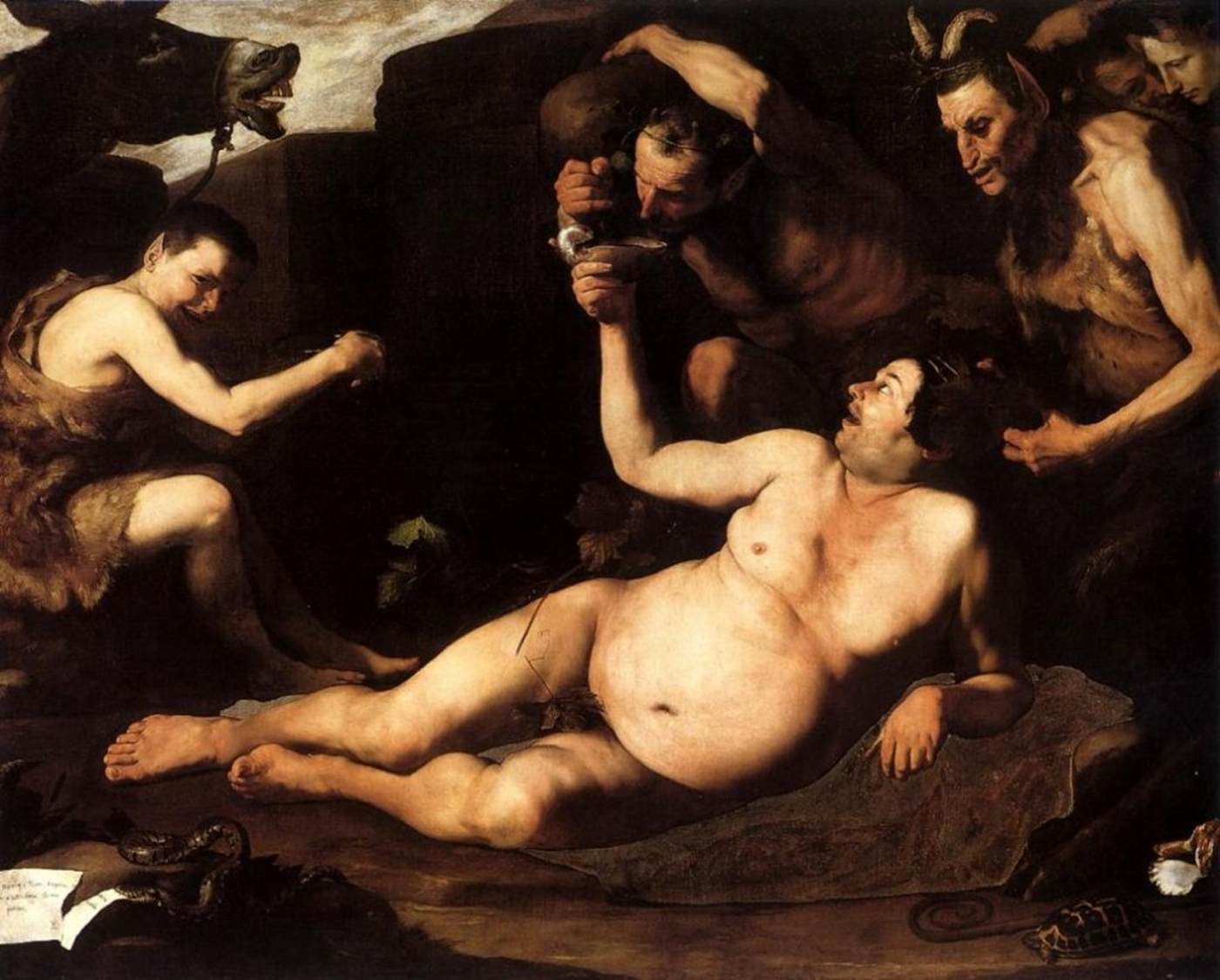
Jusepe de Ribera
1626
Date
1626
Mid-career Ribera, fully settled in Naples and enjoying high-profile commissions.
Reflects his mature Caravaggesque style while displaying increasing complexity in composition and theatricality.
Medium
Oil on canvas
Ribera exploits oil’s capacity for rich color, thick texture, and dramatic light, especially in the folds of flesh, skin tones, and atmospheric shadows.
Composition
Silenus lies semi-reclined, nearly nude, exposed in his aged, bloated body, his paunchy stomach and sagging skin on full display.
Surrounded by figures who seem both amused and indulgent—one crowns him with ivy, another offers wine.
In the foreground: a tortoise, symbolizing slowness and possibly earthly indulgence.
A wine flask and a thyrsus (Dionysian staff) add to the mythological context, but the focus remains on physical excess and decrepitude.
Formal Qualities
Chiaroscuro: Strong contrast heightens the drama—his fleshy body glows under a shaft of light against a shadowy background.
Color: Warm, earthy tones dominate—flesh, brown, ochre, crimson, conveying warmth but also decay.
Texture: Ribera’s signature attention to detail—wrinkles, veins, sagging skin, grizzled beards, and glassy eyes—adds to the grotesque realism.
Dynamism: Though Silenus is static, the scene is full of movement, from the gesturing attendants to the expressive handling of form.
Interpretation & Symbolism
Drunkenness is portrayed as both comic and tragic—Silenus’s fall from mythic dignity to a bloated, aging drunk carries a moral undercurrent.
The image may serve as a vanitas—a reminder of the frailty of the body, foolishness of indulgence, or the fleeting nature of pleasure.
Alternatively, the scene could celebrate Bacchic ecstasy, aligning with ancient ideas of truth through madness.
The tortoise may reinforce ideas of earthly inertia, indulgence, or even absurdity in the human condition.
Historical & Cultural Context
Baroque art often explored themes of bodily extremes—whether in pain, pleasure, ecstasy, or grotesquery.
Mythological subjects like Silenus offered allegorical flexibility—they could be read as moral lessons, celebrations of nature, or humorous parodies.
Naples, under Spanish rule, was a hub of intellectual culture, but also of raw realism in visual art. Ribera catered to both ends of this spectrum.
Legacy
This painting is one of Ribera’s most celebrated mythological works, often compared with the earthy naturalism of Caravaggio and the boisterous sensuality of Rubens.
It bridges classical antiquity and Baroque humanity, showing how myth could be made immediate, physical, and psychological.
A key example of the anti-idealization trend in Baroque art—beauty gives way to truth, and even gods can be pathetic.
Pan
The god of the wild, shepherds, flocks, rustic music, and impromptus. He is often depicted as half-man, half-goat, with the hindquarters, legs, and horns of a goat. Pan was associated with the pastoral sphere, including beekeeping, hunting, and fishing, and was also seen as a fertility god. He was believed to have oracular powers and is sometimes credited with teaching Apollo the art of prophecy.
St. Jerome with the Angel of Judgement

Jusepe de Ribera
1626
The same year as Ribera's Drunken Silenus—shows his range from grotesque myth to intense spirituality.
Mature period: Ribera was by then a major figure in Naples, with a style marked by emotional intensity, dramatic chiaroscuro, and brutal realism.
Medium
Oil on canvas
Oil allows for Ribera’s layered textures, glowing light effects, and earthy palette.
Composition
St. Jerome is depicted as a gaunt, elderly man, semi-nude, muscular yet frail, seated on the ground or a rock.
His body twists upward toward a glowing angel, who may be blowing a trumpet—symbolizing the Last Judgment.
The skull, Bible, and crucifix are traditional Jerome attributes, symbolizing mortality, divine knowledge, and faith.
The angel appears as a brilliant, divine presence, cutting diagonally across the darkened background—marking a sharp contrast between heaven and earth.
Formal Qualities
Chiaroscuro: Strong tenebrism highlights Jerome’s aged, wiry body against the dark surroundings, emphasizing spiritual intensity and bodily vulnerability.
Texture: Ribera’s skill in rendering skin, hair, and bones is astonishing—Jerome's body is visceral, every vein and sinew exposed.
Color: Earthy browns, grays, and golds dominate, punctuated by the heavenly glow around the angel.
Dramatic diagonals: The figure of Jerome leans up and to the right, his gesture mirrored by the angel's descent, creating visual tension and divine communication.
Interpretation & Symbolism
The painting captures Jerome’s confrontation with divine judgment, likely alluding to the moment he heard the trumpet of the Last Judgment in a vision.
Jerome’s exposure and aging body communicate humility, mortality, and readiness for spiritual reckoning.
The angel’s trumpet is not merely a narrative device but a symbol of divine authority and finality—calling both Jerome and the viewer to reflection.
The juxtaposition of flesh and spirit—earthly Jerome and celestial angel—underscores a Baroque tension between the material and the eternal.
Historical & Cultural Context
Counter-Reformation Catholicism encouraged emotional engagement with religious figures—St. Jerome was a favorite due to his scholarly devotion and penitence.
Ribera’s gritty, anti-idealized figures appealed to patrons in Spain and Naples, where realism and spiritual gravity were especially valued.
The painting can be read as a vanitas image, reminding viewers of the inevitability of death, the necessity of repentance, and the hope of salvation.
Legacy
This work stands as a key example of Ribera’s ability to unite Baroque drama, Caravaggesque realism, and theological meaning.
It showcases how even sacred ecstasy and divine confrontation could be portrayed through the vulnerable, aging body, adding a profound humanism to Catholic spirituality.
Ribera helped redefine the visual language of sanctity, moving away from graceful idealism toward raw truth and emotional authenticity.
Immaculate Conception
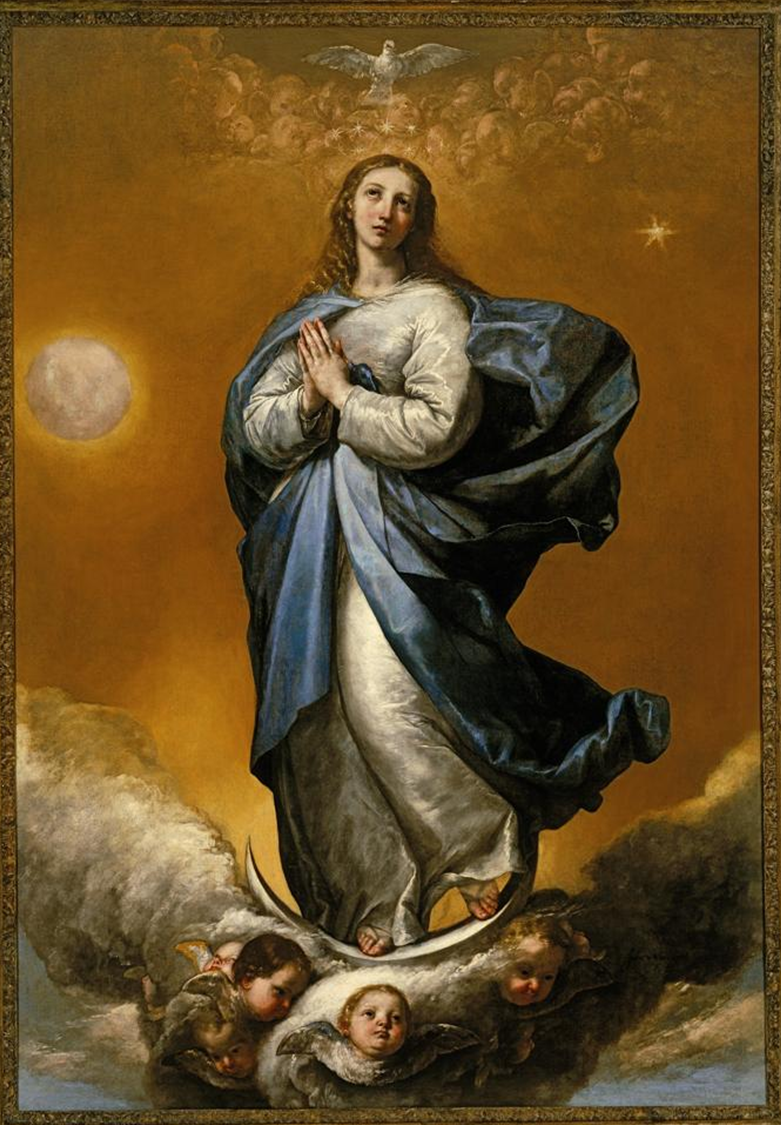
Jusepe de Ribera
1637
A mature work: Ribera was deeply established in Naples and had shifted from stark realism to a more refined, poetic style, while retaining Baroque drama.
This period shows his engagement with ideal beauty, Venetian color, and classical grace—likely in response to Roman and Bolognese trends.
Medium
Oil on canvas
Composition
The Virgin Mary is shown in awe-struck prayer, hands clasped, eyes upturned toward heaven.
She stands on a crescent moon, surrounded by cherubs and putti, many bearing Marian symbols: roses, lilies, a mirror (speculum sine macula), palm, and olive branches.
Her flowing robes—typically blue and white—billow in an upward diagonal movement, enhancing her ethereal ascent and purity.
The cloud-filled background, pierced with golden light, gives a sense of cosmic elevation.
Formal Qualities
Light: Rather than Ribera’s typical tenebrism, here we see radiant illumination, with Mary glowing against the atmospheric setting.
Color: Dominated by cool blues and whites, punctuated by the warm flesh tones of cherubs and subtle golds—evoking spiritual clarity and innocence.
Idealization: Mary is youthful, serene, and graceful—almost Raphael-esque in features—departing from Ribera’s usual gritty realism.
Composition: Diagonal motion of Mary’s robes and the upward swirl of angels creates dynamism and spiritual elevation—hallmarks of Baroque movement and grace.
Symbolism & Iconography
Crescent moon: Echoes Revelation 12; Mary as the Woman of the Apocalypse.
Crown of twelve stars (sometimes included): Symbolizes her celestial queenship.
Putti with attributes: Represent traditional Marian symbols of purity (lily), wisdom (mirror), and paradise (rose).
Floral and botanical elements: Point to her status as the new Garden of Eden, untarnished and blooming with virtue.
Her gesture and upward gaze suggest divine election and receptivity—hallmarks of Catholic Marian piety.
Context & Meaning
Spain and Naples were centers of Marian devotion, with the Immaculate Conception championed by the Franciscans and supported politically.
Ribera, often seen as harsh and realistic, demonstrates stylistic flexibility here—embracing grace, idealism, and a gentler devotional atmosphere.
Reflects the Counter-Reformation’s emphasis on accessible, emotionally compelling sacred imagery—even within doctrinally dense subjects.
Possibly commissioned for a Franciscan setting or a private Spanish patron.
Significance
A rare example of Ribera engaging Marian theology, and one of his most idealized works.
Shows his engagement with Italian High Renaissance ideals (especially Raphael and Correggio), merging them with Baroque motion and luminosity.
Anticipates the fully triumphant Marian visions of later 17th-century Neapolitan artists like Luca Giordano.
Stands as evidence that naturalism and idealism were not mutually exclusive in Ribera’s oeuvre—but rather complementary facets of his deep spirituality.
Boy with a Club Foot
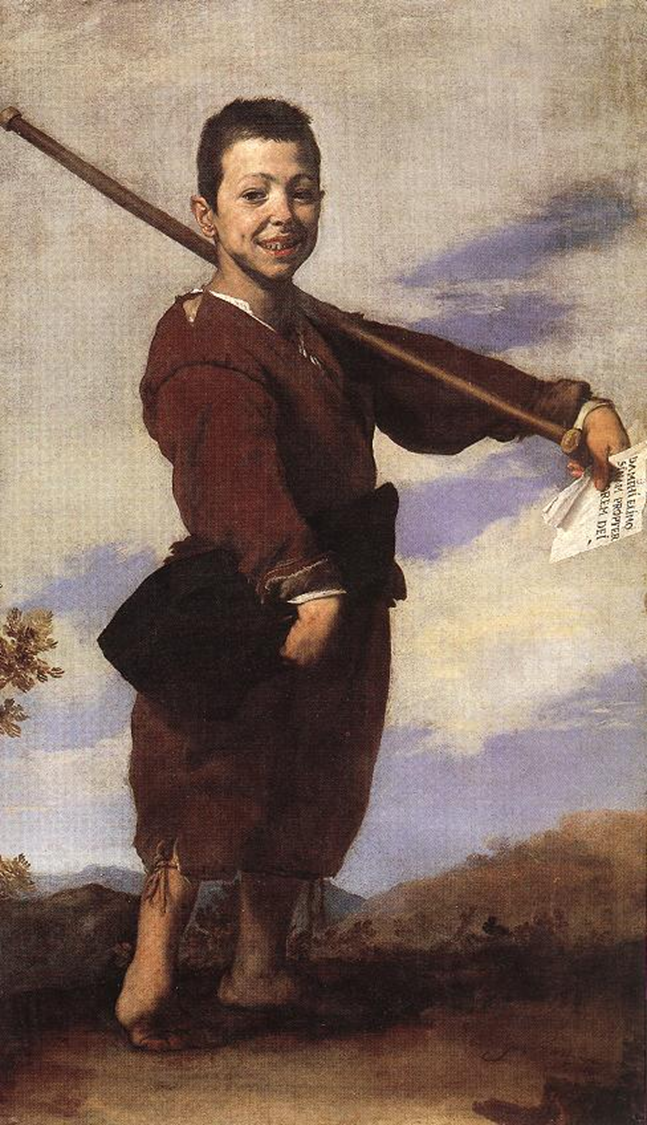
Jusepe de Ribera
1642
A mature work reflecting Ribera’s humanistic turn in the 1640s, where depictions of ordinary or suffering individuals take on increased dignity, psychological complexity, and poetic sensitivity.
Medium
Oil on canvas
Composition
The boy stands alone, leaning on a crude wooden crutch, his twisted right foot and shortened leg clearly visible.
His bare legs and patched clothing mark his poverty, yet his broad smile, direct gaze, and relaxed stance convey surprising confidence.
He holds a piece of paper with the Latin inscription:
“Da mihi elimosinam propter amorem Dei” – “Give me alms for the love of God.”A vast, empty landscape recedes behind him, emphasizing his isolation but also giving him space and stature.
Formal Qualities
Realism: Ribera’s trademark – every wrinkle, scar, and fold of cloth rendered with intense accuracy.
Light and shadow: Gentle chiaroscuro highlights the boy’s face and hands; the overall lighting is more subdued than Ribera’s earlier tenebrist work, emphasizing soft humanity over drama.
Color: Earth tones dominate—brown, beige, gray—highlighting the humility of the subject but also enhancing the realism.
Gesture and pose: The boy’s open stance, crutch casually underarm, and joyful expression subvert conventional portrayals of suffering.
Interpretation
A revolutionary portrayal of disability and poverty—rather than pity or marginalization, the subject is shown with dignity, humor, and individuality.
The inclusion of the Latin plea for alms positions him within the Catholic charitable framework of Naples, but also brings the viewer into direct ethical engagement—we must respond to the boy’s request.
His barefoot stance and visible deformity are not hidden or idealized—Ribera insists on truth, yet offers tenderness.
Social and Religious Context
Naples had a large population of poor, disabled, and diseased individuals, many of whom relied on public almsgiving.
Ribera’s work echoes the Catholic ethos of charity, central to the Counter-Reformation, but with an intimate human focus rather than doctrinal illustration.
The image bridges genre painting and portraiture, elevating a typically overlooked subject to the status of high art.
Possible Models and Influences
May have been inspired by Velázquez’s early genre portraits or the Neapolitan “bambocciata” style of everyday street scenes.
Shares thematic kinship with Caravaggio’s young beggars and Murillo’s street urchins, though Ribera’s gaze is more psychological and less sentimental.
Significance
One of the most poignant and humanistic images in Baroque art.
Challenges conventions of portraiture, sanctity, and ideal beauty—asking the viewer to see the sacred in the broken.
Emblematic of Ribera’s ability to fuse realism with grace, and suffering with joy.
This painting has become a powerful icon in disability studies and visual culture, often cited for its rare and respectful representation of a disabled figure in early modern European art.
San Gennaro Emerging Unharmed from the Furnace
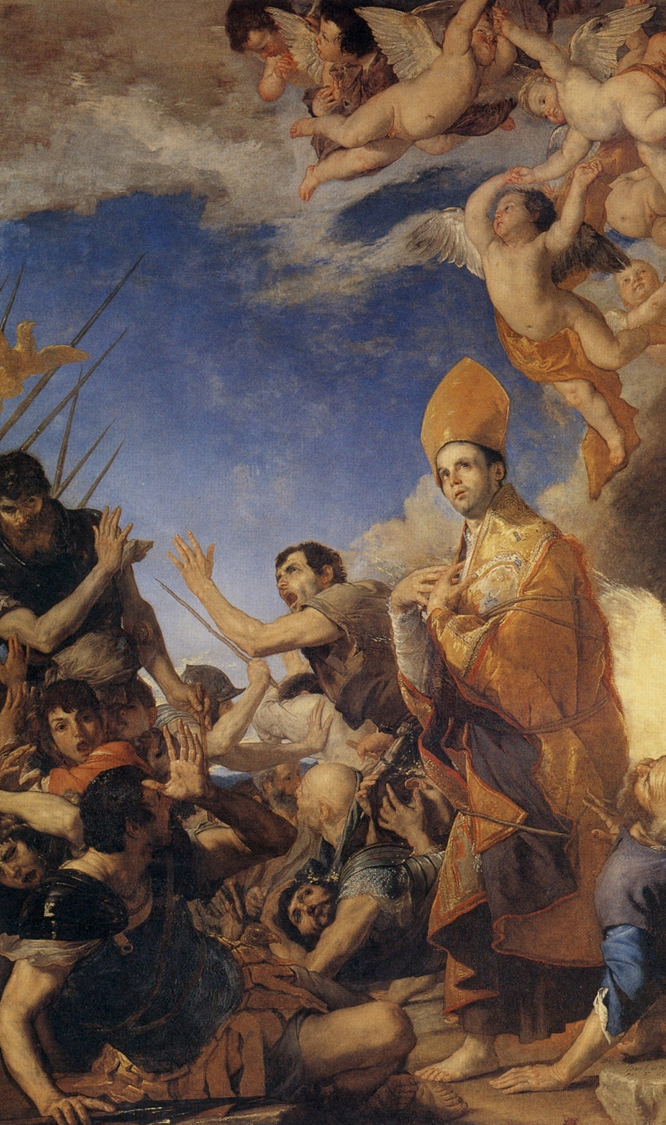
Jusepe de Ribera
1641-47
Treasury Chapel, Cathedral of San Gennaro
Part of the decoration of the Treasury Chapel (Cappella del Tesoro) of the Cathedral of San Gennaro, Naples.
Commissioned to honor Naples’ protector-saint, whose relics were housed in the chapel.
Ribera worked alongside artists like Lanfranco and Domenichino on the chapel’s fresco cycle.
Medium
Fresco
Subject and Composition
San Gennaro is shown stepping majestically and unharmed from the fiery furnace.
Flames and smoke still billow behind him, yet he appears calm and divinely protected.
Onlookers, including Roman soldiers, show astonishment, fear, and awe—dramatic gestures and gazes direct attention to the miracle.
The saint’s white robe glows, his body upright and radiantly centered, recalling Christ-like iconography.
Classical architecture and monumental scale anchor the scene, with a dramatic use of foreshortening and gestural motion.
Formal Qualities
Theatricality: The moment is staged almost like a performance, with spotlit focus, expressive figures, and spatial drama.
Naturalism: Ribera’s figures are fleshly, muscular, and realistic—one can feel the heat, the tension, the weight of stone and bodies.
Color: Warm earth tones dominate, with flashes of white, gold, and red drawing the eye to Gennaro and the fire.
Light: The firelight contrasts with divine illumination, separating the sacred from the natural.
Movement: Dynamic torsos, outstretched arms, and twisted necks emphasize both the miracle’s impact and the power of faith.
Interpretation
The scene reinforces San Gennaro’s divine protection of Naples—a city frequently plagued by disasters (plague, earthquakes, revolts).
The painting serves both a didactic and devotional purpose: it teaches the power of faith and invites awe and reverence.
Gennaro is presented not just as a historical martyr but as a living spiritual presence, able to intervene in contemporary crises.
The work demonstrates Ribera’s ability to balance realism and sacred drama, human emotion and divine narrative.
Context in Neapolitan Baroque
Naples in the 17th century was a major artistic hub, driven by Counter-Reformation piety, Spanish Habsburg rule, and local devotion to saints like Gennaro.
Ribera’s fresco aligns with the Baroque aim to engage viewers emotionally and spiritually—art as devotional spectacle.
The Treasury Chapel was both a civic and religious space—honoring San Gennaro was a public declaration of Neapolitan identity.
Comparisons
Compare to Bernini’s theatrical sacred sculpture, such as The Ecstasy of St. Teresa—both emphasize miraculous transformation through physicality and gesture.
Contrasts with Ribera’s earlier martyrdoms (e.g., St. Bartholomew), which were brutal and focused on pain—here, the focus is on survival and transcendence.
Significance
A triumphal depiction of sanctity and divine power, rooted in local veneration but expressed through universal Baroque grandeur.
One of Ribera’s few large-scale public frescoes, it showcases his range beyond intimate oils.
Reflects the unique Neapolitan blend of intense realism, emotional engagement, and civic pride.
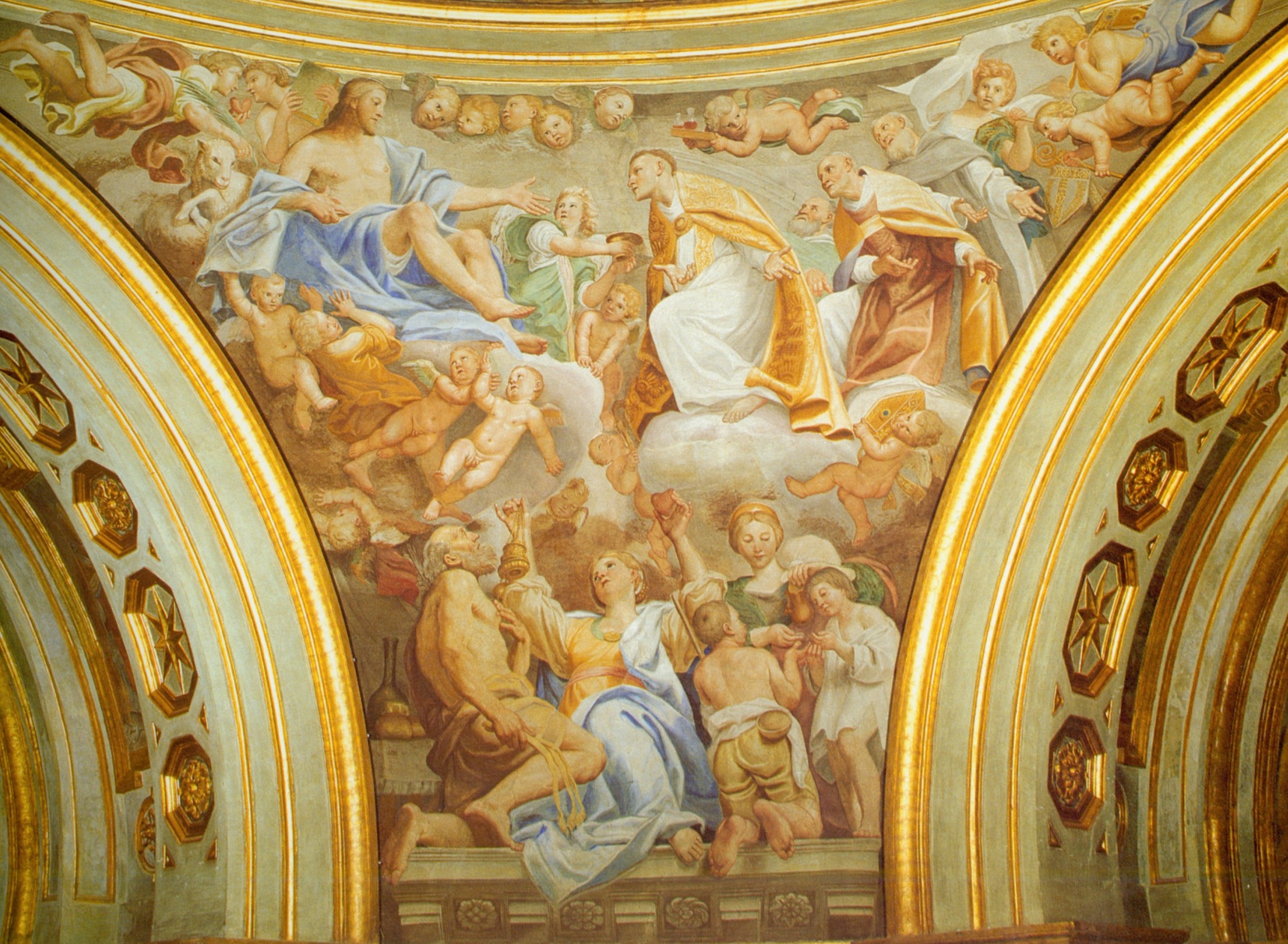
Agrippino and Agnello interceding for Naples
Domenichino
ca. 1640
Cathedral of Naples
Medium
Fresco
Subject & Composition
The three saints are shown in heavenly glory, gazing upward as they pray and plead for divine intervention.
Beneath them, a dramatic aerial view of Naples is depicted—possibly with smoke, fire, or pestilential clouds symbolizing crisis.
The saints’ expressions are serene but urgent, their hands outstretched toward the heavens or downward in intercession.
God the Father or Christ may appear in a celestial burst of light above, suggesting that the saints’ prayers are being heard.
San Gennaro, typically central and more prominent, appears with bishop’s vestments and a miter, identifying him as the city’s foremost patron.
Formal Qualities
Clarity and Order: Domenichino arranges the saints in a balanced triangular composition, echoing classical Renaissance harmony.
Idealized Beauty: The figures are graceful, cleanly modeled, and bathed in soft light—a hallmark of Domenichino’s academic training.
Color Palette: Cooler tones—blues, soft reds, golden highlights—enhance the divine aura and emotional calm.
Contrast with Naples Below: The serene, celestial space contrasts with the chaotic, troubled city below, underscoring the saints’ protective role.
Interpretation
This fresco is a theological and civic statement: the saints are not remote figures but active guardians of Naples.
It visualizes the intercessory power of saints in the Catholic Counter-Reformation worldview—humans need mediators to reach divine mercy.
A response to crisis, this work reassures the faithful that their prayers are heard, provided they remain devoted.
The three saints represent continuity in local piety—Gennaro as protector, Agrippino as early bishop, and Agnello as a miracle worker.
Context in the Treasury Chapel
Part of a unified decorative program in the Cappella del Tesoro that celebrated Naples’s spiritual identity.
Domenichino’s fresco provides a visual complement to Ribera’s San Gennaro Emerging from the Furnace and Lanfranco’s ceiling fresco of the Glory of San Gennaro.
His work is more restrained and contemplative, providing contrast to Ribera’s intense realism and Lanfranco’s dynamic ceiling illusionism.
Comparisons
Lanfranco: More dramatic and energetic in his dome fresco, while Domenichino is calm and clear, evoking Raphael.
Ribera: Shows the act of divine intervention (a miracle), whereas Domenichino shows the prayer for it.
Earlier tradition: Evokes Renaissance altarpieces where saints act as intercessors, linking heaven and earth.
Significance
Reflects the Baroque fusion of civic identity and religious devotion.
A key example of how painting functioned as visual reassurance in times of plague and uncertainty.
Demonstrates Domenichino’s graceful restraint within the expressive and emotionally charged Neapolitan Baroque.
Alongside Ribera and Lanfranco, Domenichino helped define the Baroque artistic identity of Naples through sacred, site-specific fresco cycles.
Holy Family with Sts. Anne and Catherine of Alexandria
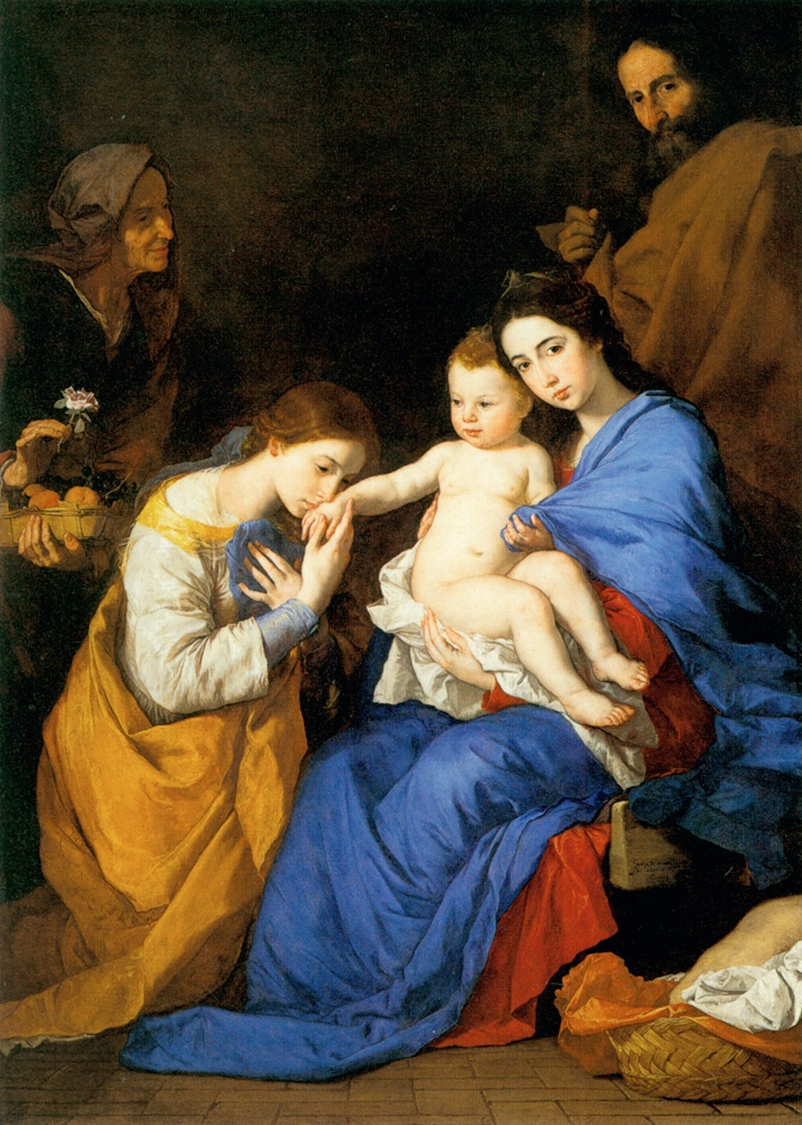
Jusepe de Ribera
1648
Medium
Oil on canvas
Composition & Subject
The Virgin Mary sits at the center, possibly with the Christ Child on her lap or in her arms.
Saint Anne is often shown close beside Mary, bridging the generational line of holy women.
Saint Catherine, identifiable by her traditional crown, martyr’s palm, and broken wheel, may kneel or stand in adoration of the Christ Child.
Joseph is included, perhaps in the background, observing the scene quietly—a traditional figure of pious humility.
The overall tone is tender and intimate, emphasizing familial affection and saintly reverence.
Formal Qualities
Softened Naturalism: Compared to his earlier, grittier style, Ribera here uses smoother modeling, warm light, and a more graceful handling of figures.
Color Palette: Earthy tones—warm reds, ochres, and browns—are illuminated by subtle highlights, bringing a gentle glow to faces and fabrics.
Expressive Realism: Ribera retains emotional immediacy, particularly in the Christ Child’s interaction with the saints and in the loving gazes exchanged.
Interpretation
The work emphasizes devotional intimacy over drama—appropriate for private worship or altarpiece use.
By including both St. Anne and St. Catherine, the composition connects maternal lineage (Anne–Mary–Jesus) with spiritual martyrdom and scholarly virtue (Catherine).
Saint Catherine’s presence may reflect the patron’s personal devotion, possibly a commission by a woman or religious community associated with her.
Stylistic Context
Reflects Ribera’s late Baroque synthesis: still grounded in realism, but tempered by classicism and tender affect.
By 1648, he’s moving closer in spirit to artists like Guido Reni or Carlo Maratta, who emphasized grace and serenity.
The naturalism is still present in flesh tones, wrinkles, and texture—but is now infused with warmth and dignity.
Comparisons
Earlier Ribera (e.g., Drunken Silenus): harsher lighting, coarser textures, dramatic action.
This Ribera: meditative, composed, emotionally resonant—closer in tone to Murillo or even Raphael.
Can be compared to other sacra conversazione works by Reni, Carracci, or van Dyck, but Ribera’s maintains a distinct earthy honesty.
Significance
A masterwork of Ribera’s late period, showing his stylistic evolution and adaptability.
Blends Spanish realism with Italian compositional harmony and devotional gentleness.
Demonstrates how Baroque artists tailored their styles for specific religious contexts—here, inviting quiet veneration rather than theatrical awe.
A beautiful example of Baroque spiritual humanism, where the holy becomes approachable through natural emotion and familiar gestures.
The Crucifixion

Francisco de Zurbaran
1627
for oratory of the sacristy, monastery of San Pablo Real, Seville
Commissioned for the oratory of the sacristy in the Monastery of San Pablo el Real in Seville—a Dominican house.
Part of a major commission of 21 paintings, many illustrating martyrdoms and scenes of devotion, reflecting the Counter-Reformation focus on piety and suffering.
Subject
A solitary Christ on the Cross, presented against a stark, dark background.
No landscape, no mourners, no narrative elements—only Christ suspended in timeless space.
Christ is shown in full body, nailed to the cross with his head bowed gently—his death has just occurred.
Formal Qualities
Tenebrism: Deep shadows envelop the figure; the background is an opaque black, pushing Christ forward in stark relief.
Realism: Christ’s anatomy is meticulously rendered—muscles taut, wounds detailed, skin pale and luminous.
Vertical Composition: The format emphasizes the height of the cross, elongating Christ’s figure and enhancing its monumentality and solemnity.
Light: A single source of light illuminates the body from the side, sculpting it with delicate yet dramatic chiaroscuro.
Simplicity: No distractions, purely focused on meditation and devotion.
Interpretation
Designed to inspire contemplation and spiritual empathy rather than tell a story.
The absence of other figures (like Mary or John) emphasizes Christ’s isolation and sacrifice, in line with monastic ideals of solitude and reflection.
The painting’s austerity is meant to evoke a personal, inward response, encouraging the viewer to confront the mystery of Christ’s death directly.
Stylistic Context
Zurbarán draws on Caravaggesque naturalism, but his tone is quieter, more ascetic.
Shares affinities with Spanish mysticism, particularly the writings of St. Teresa of Ávila and St. John of the Cross—both emphasize the soul’s solitary journey toward God.
His style here is severe, contemplative, reinforcing the spiritual ideals of the Dominican Order.
Comparisons
Compared to Velázquez’s later Christ on the Cross (1632), Zurbarán’s is more restrained and austere, less idealized.
Unlike Rubens, who often depicted the Crucifixion with crowds and emotion, Zurbarán opts for monastic stillness and verticality.
Echoes Northern Renaissance depictions of crucifixion—like Grünewald’s in its visceral power—but purified of gore.
Significance
One of the most profound expressions of Spanish devotional art in the 17th century.
Embodies the Counter-Reformation aesthetic: clear, emotionally resonant, spiritually focused.
A pinnacle of Zurbarán’s early work, demonstrating his ability to merge naturalism with mysticism.
Sets the tone for much of his later religious painting—marked by stillness, clarity, and inward depth.
St. Serapion
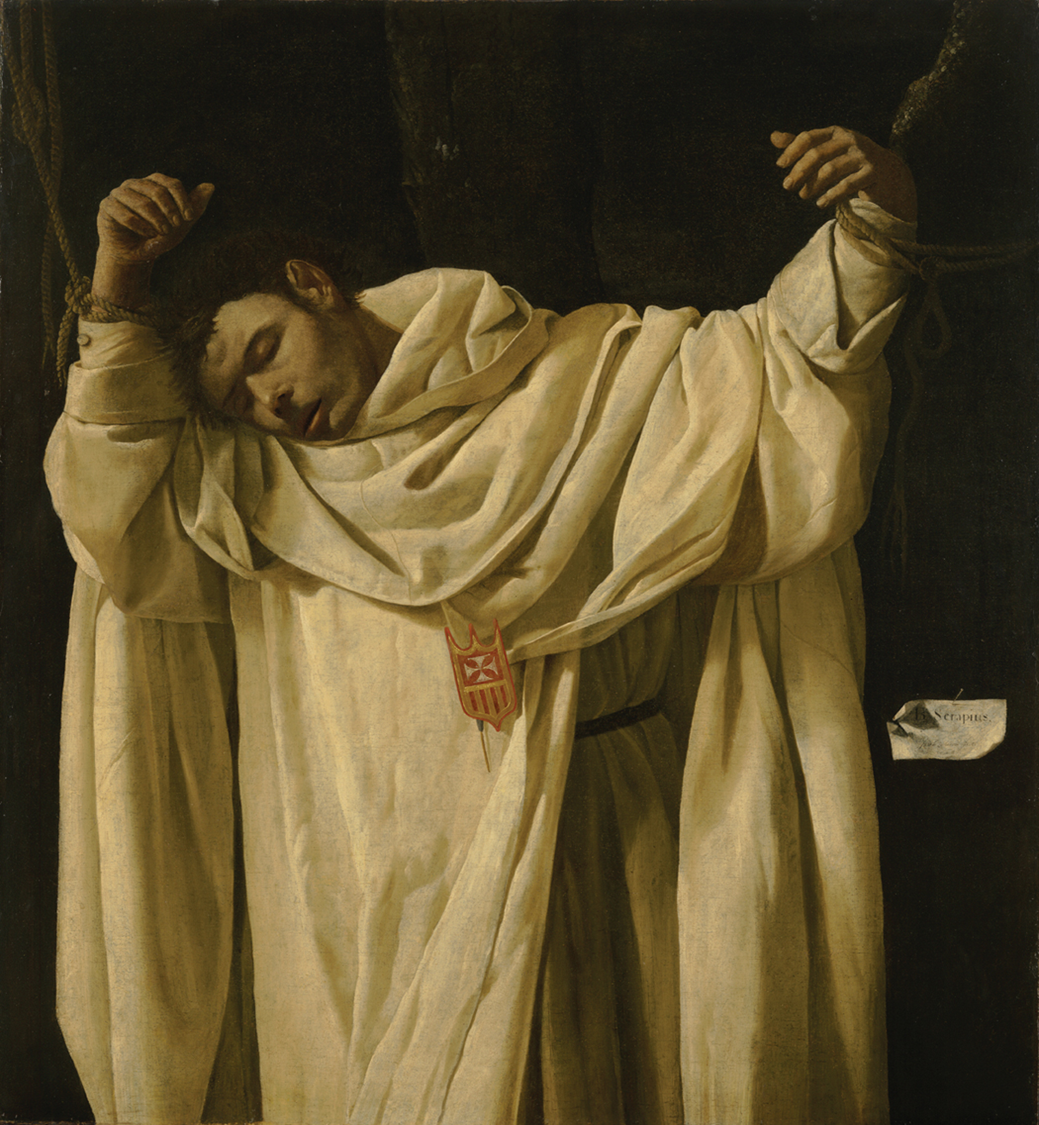
Francisco de Zurbaran
1628
Subject: St. Serapion
St. Serapion of Algiers (d. 1240), a Mercedarian monk martyred during the Order’s mission to ransom Christian captives from Muslim hands.
According to tradition, he was tortured and dismembered, though Zurbarán presents the aftermath of the violence, not the act itself.
Shown bound, lifeless, and suspended, he becomes a visual emblem of sacrifice and submission.
Commission Context
Painted in 1628 for the Monastery of the Order of Mercy (Mercedarians) in Seville, whose mission focused on redeeming captives.
The Order held St. Serapion as a patron and martyr, making this an image of particular devotional significance.
Formal Qualities
Monochromatic palette dominated by white and gray, reflecting the Mercedarian habit and adding to the sense of calm sanctity.
The figure is set against a neutral, shadowy background, emerging in solemn relief.
Exquisite rendering of fabric: The drapery is almost abstract in its folds, contributing to the sense of stillness and transcendence.
Subtle but powerful tenebrism: Light gently models the saint’s face and garments, highlighting both physical fragility and spiritual radiance.
Horizontal band across his chest—a small paper tag identifying him as “B. Serapion Martyr”—heightens the realism but also reads like a relic label.
Interpretation
Although martyred brutally, there is no blood or overt violence. Zurbarán instead focuses on Serapion’s submission and peace in death.
His pose, with outstretched arms, evokes a Crucifixion—a visual parallel between Christ’s Passion and martyrdom.
The overwhelming whiteness of his robes symbolizes purity, holiness, and heavenly reward.
The saint appears transfigured, hovering between earthly suffering and divine transcendence.
Stylistic and Spiritual Qualities
Exemplifies Zurbarán’s signature blend of naturalism and mysticism.
Emphasis on texture and stillness creates a meditative atmosphere appropriate for monastic contemplation.
The stark simplicity contributes to a silent intensity, offering the viewer a sense of timeless, sacred space.
Reflects Counter-Reformation values: clarity, didacticism, and emotional gravity.
Comparisons
Closely related to Zurbarán’s Crucifixion (1627): both depict solitary, sacrificial figures with an emphasis on quiet martyrdom.
Compared to Ribera’s martyrdoms (e.g., St. Bartholomew), Zurbarán’s approach is less visceral, more spiritualized.
In contrast to Caravaggio’s drama, Zurbarán offers stillness and submission, channeling Spanish mysticism (like that of St. John of the Cross).
Significance
One of Zurbarán’s most powerful and iconic works.
Reflects the Spanish Baroque’s embrace of the spiritual and emotional resonance of martyrdom.
A model of monastic devotional painting, designed to inspire empathy, reverence, and reflection.
Has become a key image in the study of martyrdom, fabric illusionism, and Counter-Reformation spirituality in Spanish art.
St. Peter Nolasco’s Vision of the Crucified St. Peter
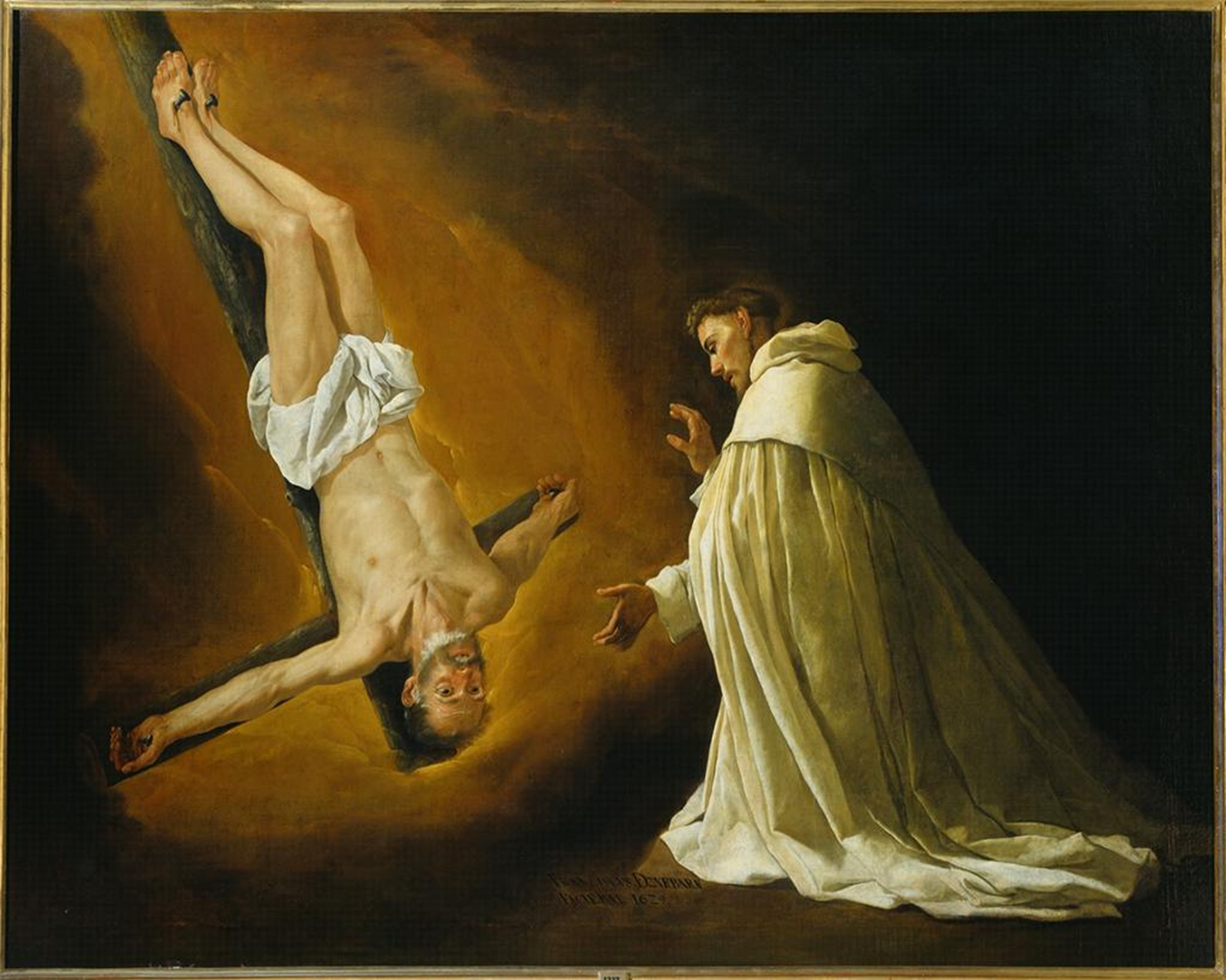
Francisco de Zurbaran
1625
Subject: St. Peter Nolasco’s Vision
The painting portrays the vision of St. Peter Nolasco, founder of the Order of the Blessed Virgin Mary of Mercy (Mercedarians), who is shown witnessing the Crucified Christ while praying.
This vision is tied to Nolasco’s mission to rescue Christian captives from Muslims during the 13th century.
The Crucified Christ appears in a supernatural, ethereal light, symbolizing divine guidance and the inspiration for his founding of the Order.
The vision signifies divine approval of Nolasco’s mission, which included both the redemption of souls and captives.
Formal Qualities
Chiaroscuro: Strong contrasts of light and dark create a dramatic intensity that enhances the spiritual experience.
Central Figure of Christ: He is shown in a highly symbolic, ethereal form, emphasizing divine illumination. The soft, otherworldly glow contrasts with the dark, somber tones of Nolasco’s figure.
Composition: Nolasco is depicted kneeling in prayer, with his gaze directed upwards toward the vision of Christ. The composition directs the viewer’s focus toward this divine revelation, which is framed by a surrounding darkness.
Atmosphere: The painting has a strong sense of spiritual transcendence, conveyed through the use of light and space.
Interpretation
The vision of Christ is a moment of divine communication, marked by light, contrast, and the contrast between the earthly and the divine.
The painting reflects the mysticism and visionary experience that characterized the religious fervor of the time.
Zurbarán captures the reverence and humility of St. Peter Nolasco, placing him in a position of submissive prayer before the sublime appearance of Christ.
Spiritual illumination and devotion are key themes, emphasizing Nolasco’s role as the founder of the Mercedarian Order, dedicated to the redemption of captives and serving as a conduit of divine mercy.
Stylistic and Spiritual Qualities
Baroque Mysticism: The use of light and shadow speaks to the spiritual intensity of Baroque religious art, in which visionary and mystical experiences are portrayed as moments of divine intervention.
Silence and Reverence: The stillness of Nolasco’s figure, and the quiet nature of the vision, is contrasted with the more dynamic, emotional scenes typical of Baroque art, suggesting contemplative devotion rather than active drama.
Attention to Fabric and Texture: As with many of Zurbarán’s works, fabrics such as Nolasco’s robes and the glowing drapery of Christ are rendered with a remarkable attention to detail, demonstrating the artist’s skill in material representation.
Comparisons
Zurbarán’s earlier works, like St. Serapion (1628), have a similar aesthetic of spiritual intensity and mystical submission to the divine. However, the vision in St. Peter Nolasco’s Vision is depicted with a greater sense of illumination, focusing on the visionary experience rather than the martyrdom or physical suffering of the subject.
In contrast to the visionary works of Caravaggio, where the physical presence of divine figures often overshadows the human experience, Zurbarán’s use of soft light and otherworldly presence emphasizes spiritual connection more than physical drama.
Significance
This work underscores Zurbarán’s unique contribution to Baroque art by combining intense emotional devotion with a quiet reverence for the divine.
It reflects the spiritual and religious climate of Spain during the Counter-Reformation, where art was used to inspire devotional awe and mystical connection.
The painting is a visual embodiment of divine inspiration—a moment in which Nolasco is spiritually and morally directed, receiving divine approval for his founding of the Mercedarians.
Virgin and Christ in the Holy House of Nazareth

Francisco de Zurbaran
ca. 1631-40
Subject: Virgin and Christ in the Holy House of Nazareth
The painting depicts the Virgin Mary and the infant Christ in a moment of serene intimacy and holiness, set within the Holy House of Nazareth, traditionally believed to be the home of the Holy Family in Nazareth.
In this work, Zurbarán presents a visionary and spiritual encounter of the Holy Family, often interpreted as emphasizing the sanctity of the domestic space and the divine presence in the humble setting of the Holy House.
The Holy House of Nazareth was believed to be miraculously transported to Loretto, Italy in the 13th century, and was a site of great pilgrimage and devotion.
Formal Qualities
Chiaroscuro: The use of light and shadow is central to the composition, emphasizing the holy figures of Mary and Christ, as well as the divine light that seems to envelop them, reinforcing their sacred nature.
Spatial Treatment: The figures are shown in a simple, unadorned interior, likely meant to evoke the humility of the Holy Family and their domestic life. The background is dim, allowing the light from the Virgin and Christ to dominate, signaling their centrality to the scene.
Composition and Gesture: The Virgin holds the Christ child in a gentle, protective manner, which enhances the motherly tenderness between the figures. This arrangement emphasizes the spiritual significance of their relationship, as well as the simplicity and holiness of their daily life.
Symbolism
The Virgin Mary and infant Christ are typically portrayed as the central focus of divine affection. The light that falls on them underscores their sacred status, signaling both their humanity and divinity.
The Holy House of Nazareth, depicted as a modest setting, represents the simplicity and purity of the Holy Family, and by extension, the Christian message of humility and sanctity.
The presence of light signifies not only the divinity of Christ but also the illumination of the world through His birth. This aligns with the Baroque focus on divine light as a metaphor for divine presence and spiritual enlightenment.
Style and Influence
Zurbarán’s use of naturalism in depicting the figures creates a sense of authenticity and closeness. His spiritual realism contrasts with the more dramatic naturalism seen in the works of Caravaggio or Rubens, where physical movement and emotional intensity play a larger role.
The calmness of Zurbarán’s figures reflects the mystical and contemplative aspect of Spanish Baroque religious art. It invites the viewer to reflect on the sacred and spiritual purity of the moment, rather than focusing on theatricality or external drama.
Comparisons with Other Baroque Works
Zurbarán’s style shares similarities with José de Ribera’s approach to religious devotion and mysticism, but Zurbarán’s figures are often more subdued, inviting a contemplative approach rather than a focus on suffering or struggle.
Unlike Peter Paul Rubens’ depiction of the Holy Family, which often features more dramatic settings and active gestures, Zurbarán’s representation in Virgin and Christ in the Holy House of Nazareth focuses more on humility, stillness, and spiritual warmth.
In contrast to Caravaggio’s naturalistic, sometimes harsh, portrayals of religious figures, Zurbarán’s figures evoke a quiet sanctity, highlighted by soft lighting and serene expressions.
Theological and Devotional Context
This work reflects the devotional climate of Spain during the Counter-Reformation, where religious art played an important role in inspiring personal devotion and mystical engagement with the divine.
The Holy House of Nazareth, as the setting for this image, symbolizes Christian sanctity and the divine presence in everyday life—themes that were central to the Baroque religious reforms.
Still Life with Lemons, Oranges and a Rose
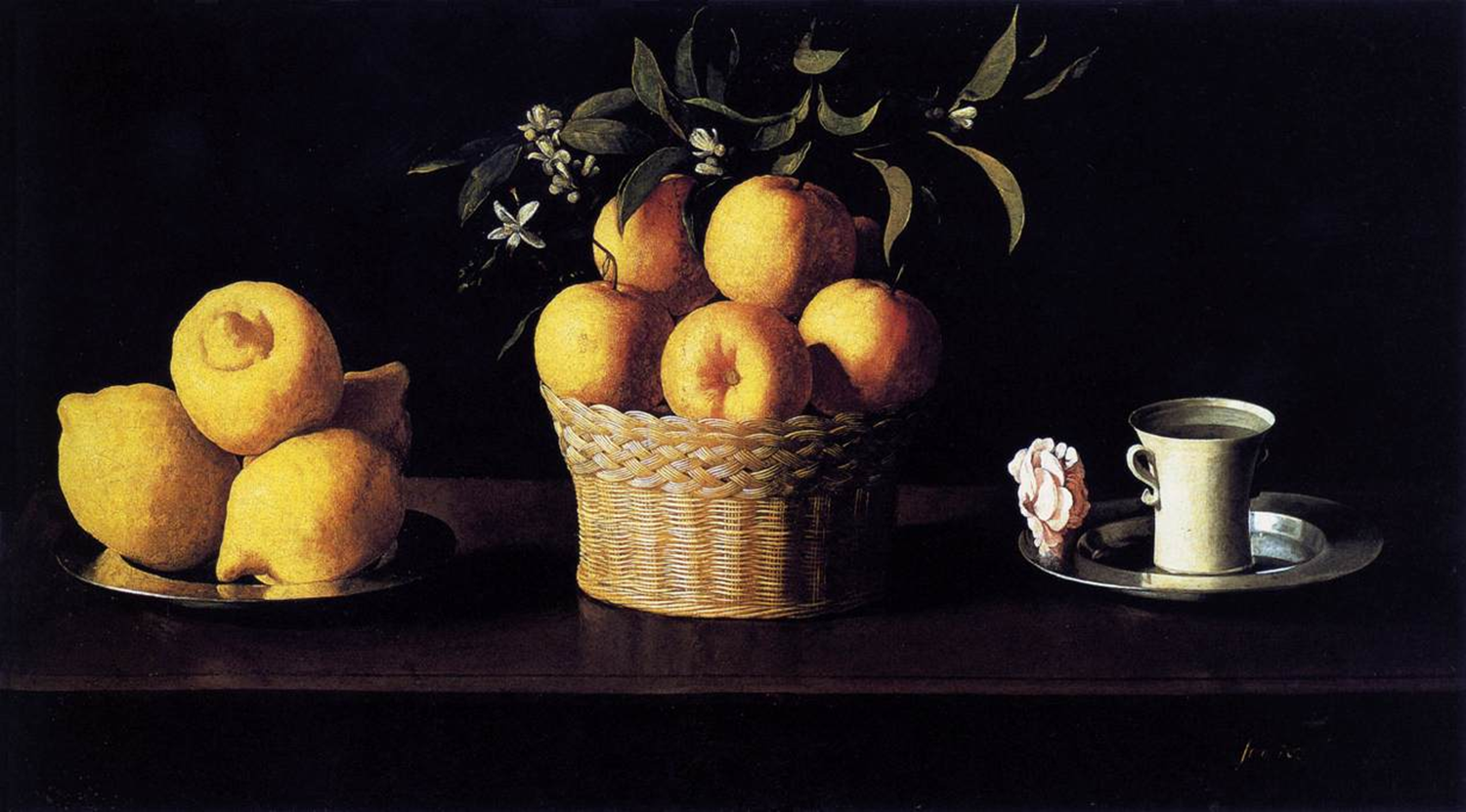
Francisco de Zurbaran
1633
Subject: Still Life with Lemons, Oranges, and a Rose
The painting is a still life that presents a calm, focused composition of lemons, oranges, and a rose, which are arranged on a simple surface.
The choice of fruits—lemons and oranges—could be symbolic of purity and renewal, often associated with Christian iconography.
The rose, a common symbol in religious art, may represent the Virgin Mary or divine love. It stands in contrast to the fruit, suggesting a link between the earthly and the spiritual.
Formal Qualities
Realism and Detail: Zurbarán's attention to detail is extraordinary in this work, with every surface of the fruit and the rose captured with tactile precision. The textures of the skin of the fruit and the delicate petals of the rose are rendered with incredible care, making them almost lifelike.
Lighting: The careful use of light creates a dramatic contrast between the bright highlights on the fruit and the deep shadows in the background, emphasizing the three-dimensionality and naturalism of the objects.
Color Palette: The muted tones of the table surface and dark background contrast with the vivid oranges and the white of the rose, allowing these elements to stand out as the focal points of the composition.
Symbolism
Lemons and Oranges: In 17th-century Spanish Baroque painting, fruit was often a symbol of fertility, growth, and divine bounty. The lemon, with its sharp flavor, might also suggest purity, while the orange could be associated with the sweetness of divine love.
The Rose: A widely used symbol in Christian art, the rose can represent the Virgin Mary (often called the Mystical Rose) or divine love and sacrifice. In this case, it provides a spiritual contrast to the otherwise earthly fruits.
Style and Influence
Naturalism: Zurbarán’s still lifes were ahead of their time, demonstrating an incredibly refined naturalism that was often focused on ordinary objects. Unlike many of his contemporaries, his approach imbued these mundane objects with a sacred aura, elevating them beyond mere still life.
Baroque Chiaroscuro: The sharp contrast of light and shadow gives the painting its Baroque sensibility. The use of light directs the viewer’s eye to the key components—the texture of the fruits and the fragility of the rose—and creates a spiritual atmosphere.
Religious Context: While the composition may initially seem to be a simple study of fruits, Zurbarán's treatment suggests that there is a deeper connection to religious themes. The care with which he presents the objects makes them seem more like offerings or symbols of devotion, rather than just items in nature.
Comparisons with Other Baroque Still Life Paintings
Unlike the flamboyant still lifes of Giovanni de’Brescia or Luis Meléndez, which often celebrate opulence and abundance, Zurbarán’s still lifes are more sparse and focused, with a spiritual depth that connects the material world to the divine.
Still Life with Lemons, Oranges, and a Rose stands out for its quiet, contemplative nature, which contrasts with the more theatrical or exuberant compositions seen in the still life works of Rubens or Snyders.
Theological and Devotional Context
Zurbarán’s work fits well within the Counter-Reformation's focus on spiritual contemplation and the sanctification of the everyday. By transforming ordinary objects into representations of the sacred, Zurbarán encourages a deeper spiritual reflection for the viewer.
The simplicity of the composition aligns with the Spanish Baroque's focus on austerity, as well as the devotional practices of the time, where mysticism and meditative contemplation were key aspects of religious life.
Adoration of the Shepherds
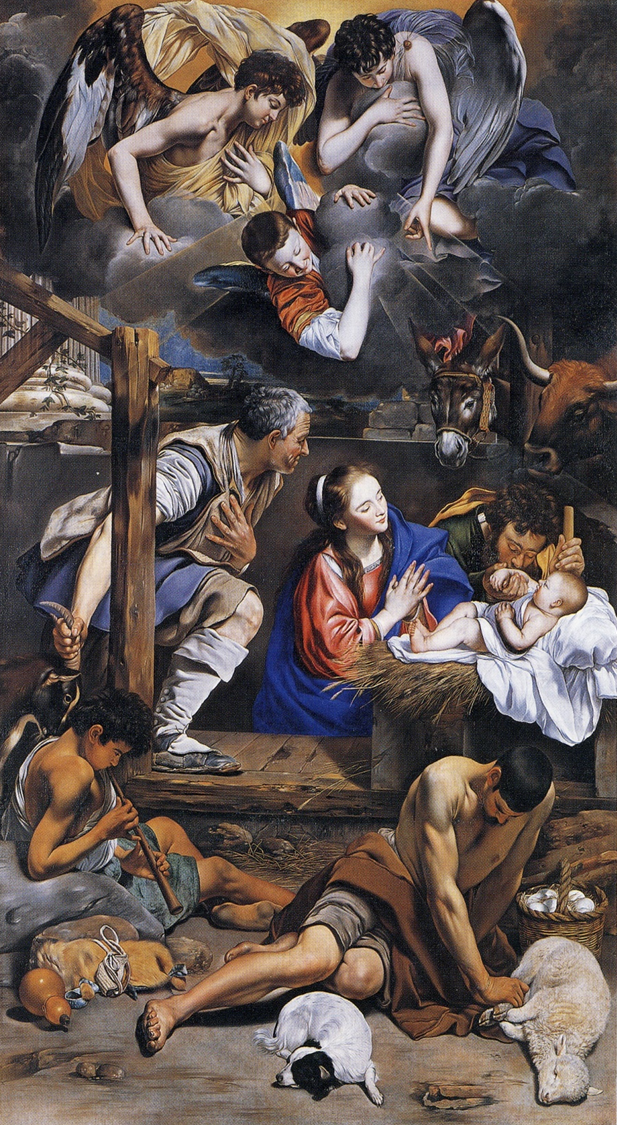
Juan Bautista Maino
1612-13
The Adoration of the Shepherds was painted shortly after Maíno returned from Italy and is part of a larger altarpiece series for the Dominican monastery of San Pedro Mártir in Toledo. This work is a key example of the early Spanish Baroque, blending naturalism, classical balance, and tenebrism.
Composition and Style
The composition centers on the infant Christ, bathed in an ethereal light that acts as the focal point for the viewer and the surrounding figures.
Mary and Joseph are rendered with serene dignity, reflecting classical ideals, while the shepherds, dressed in rustic garments, bring a sense of realism and humility.
A strong diagonal arrangement leads the eye through the figures toward the Christ child, creating a dynamic yet harmonious structure.
Maíno's use of chiaroscuro shows the influence of Caravaggio, particularly in how light emphasizes the divine presence and emotional gravity of the scene.
Color and Detail
Rich, saturated hues—deep reds, warm browns, and glowing whites—are carefully balanced, showing an influence from Venetian painters like Titian.
The fabrics are meticulously rendered, highlighting Maíno’s interest in texture and materiality, likely influenced by both Italian painting and Spanish textile traditions.
The faces of the shepherds convey genuine wonder and humility, contrasting with the composed serenity of the Holy Family, enhancing the emotional range of the scene.
Symbolism and Spirituality
The infant Christ radiates divine light, an artistic device common in Baroque nativity scenes, symbolizing salvation entering the world.
The presence of humble shepherds reinforces the idea of Christ’s accessibility to the lowly and pure of heart—central tenets of Counter-Reformation spirituality.
The muted background allows the focus to remain on the human figures and the theological significance of the moment.
Influences
Italian Influence: Having studied in Rome, Maíno was deeply influenced by Caravaggio, Carracci, and Raphael. His integration of classical idealism and dramatic naturalism can be traced to this exposure.
Spanish Counter-Reformation: The devotional intensity and emotional sincerity of the painting reflect the spiritual aims of Spanish religious art in the early Baroque period.
Significance
Adoration of the Shepherds is one of Maíno’s most important surviving works and reflects his role in transforming Spanish painting through Italian Baroque influences.
The painting helped pave the way for later artists like Francisco de Zurbarán, Jusepe de Ribera, and ultimately Diego Velázquez, all of whom would further develop the emotionally resonant, naturalistic style introduced by Maíno.
Old Woman Cooking Eggs
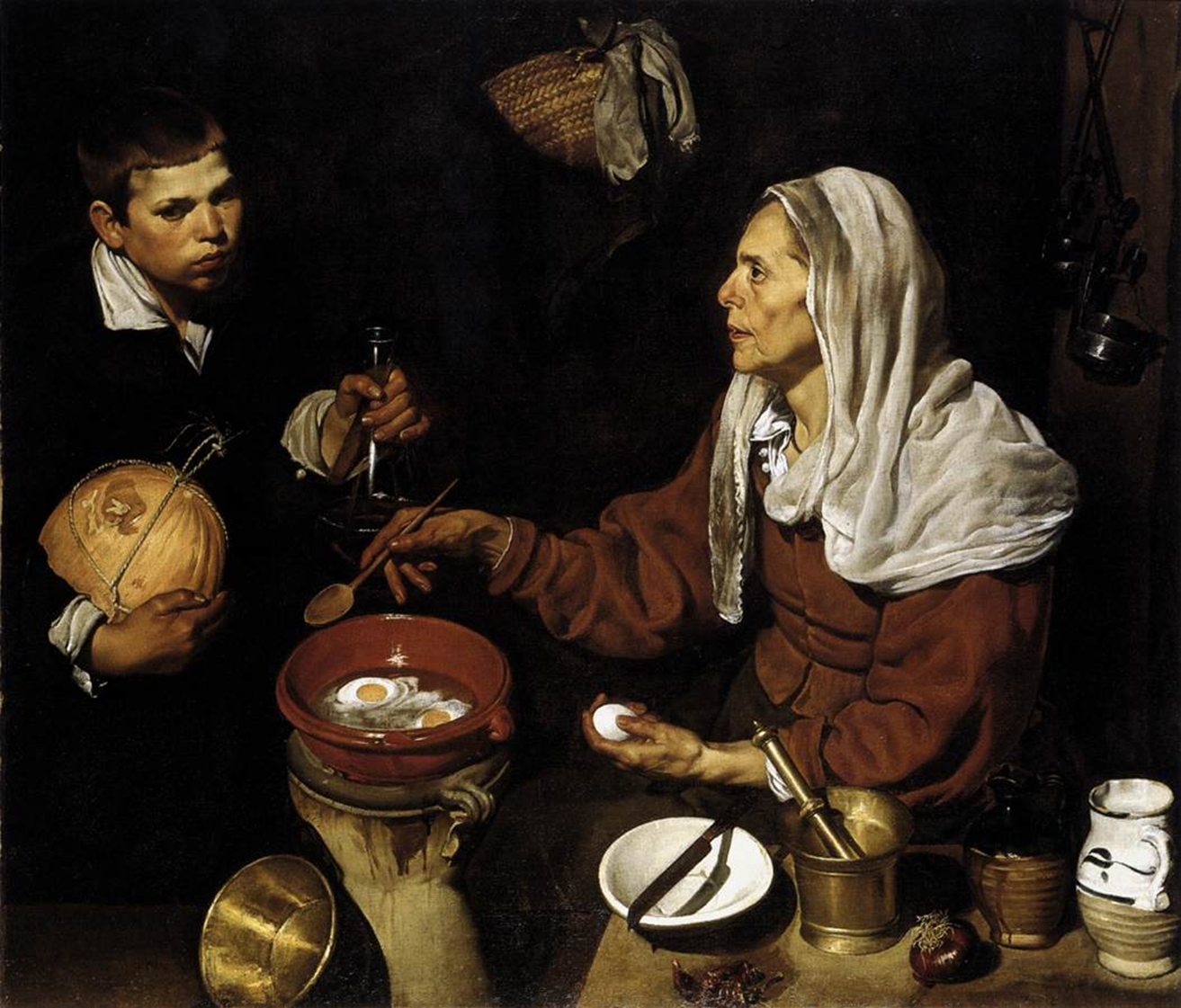
Diego Velazquez
1618
Composition & Style
The scene is tightly composed around a simple kitchen interior, with a strong emphasis on everyday objects and the interaction between two figures: an elderly woman cooking eggs and a young boy, likely a kitchen assistant or apprentice.
The figures are life-sized, creating an immersive immediacy. The boy's profile and the woman’s downward gaze form a subtle diagonal, guiding the viewer’s eye through the scene.
Velázquez’s handling of natural light is masterful—cool light streams in from the left, illuminating the figures and casting detailed shadows that enhance the volumetric modeling of the faces and objects.
Technical Mastery
The most celebrated aspect of the painting is Velázquez’s extraordinary attention to surface textures and light effects:
The eggs in the bubbling pot are semi-translucent in the oil.
The ceramic vessels, brass pot, glass jugs, and wicker basket are rendered with almost photographic clarity.
The skin of the old woman shows age and wear, contrasted with the smooth youthfulness of the boy.
This level of optical precision reflects Velázquez’s close study of Caravaggio’s tenebrism, though with a quieter, more contemplative tone.
Themes and Interpretation
Dignity in Labor: Rather than presenting the woman as a caricature or symbol, Velázquez portrays her with stoic presence and human complexity—a hallmark of his early work.
Everyday Sacredness: While the scene is secular, the care with which each item and gesture is rendered gives it a sense of sacramental solemnity. This spiritual elevation of the mundane was in line with Counter-Reformation ideals that called for clarity, humility, and emotional accessibility in art.
Didactic undertones: The scene may subtly explore generational transmission—the older woman teaching the younger boy through work, passing down skills and discipline.
Context
Painted in Seville, where Velázquez trained under Francisco Pacheco (his father-in-law), the painting reflects the artist’s early ambition to transform everyday genre scenes into serious works of art.
Velázquez was likely familiar with Caravaggio’s works through prints or reports from Spanish artists who had studied in Italy. The influence is clear in the dramatic contrasts and psychological realism, but Velázquez brings a quieter, more meditative mood to the scene.
Significance
Old Woman Cooking Eggs is considered one of Velázquez’s most accomplished early works, establishing the bodegón as a uniquely Spanish contribution to European art.
The painting anticipates his later court portraits in its psychological depth, formal clarity, and mastery of light and texture.
It remains a foundational piece in understanding Velázquez’s evolution into one of the greatest painters of the Spanish Golden Age.
bodegones
A Spanish genre of painting in the 17th century that depicts scenes of everyday life with food and drink.
The Water Seller of Seville
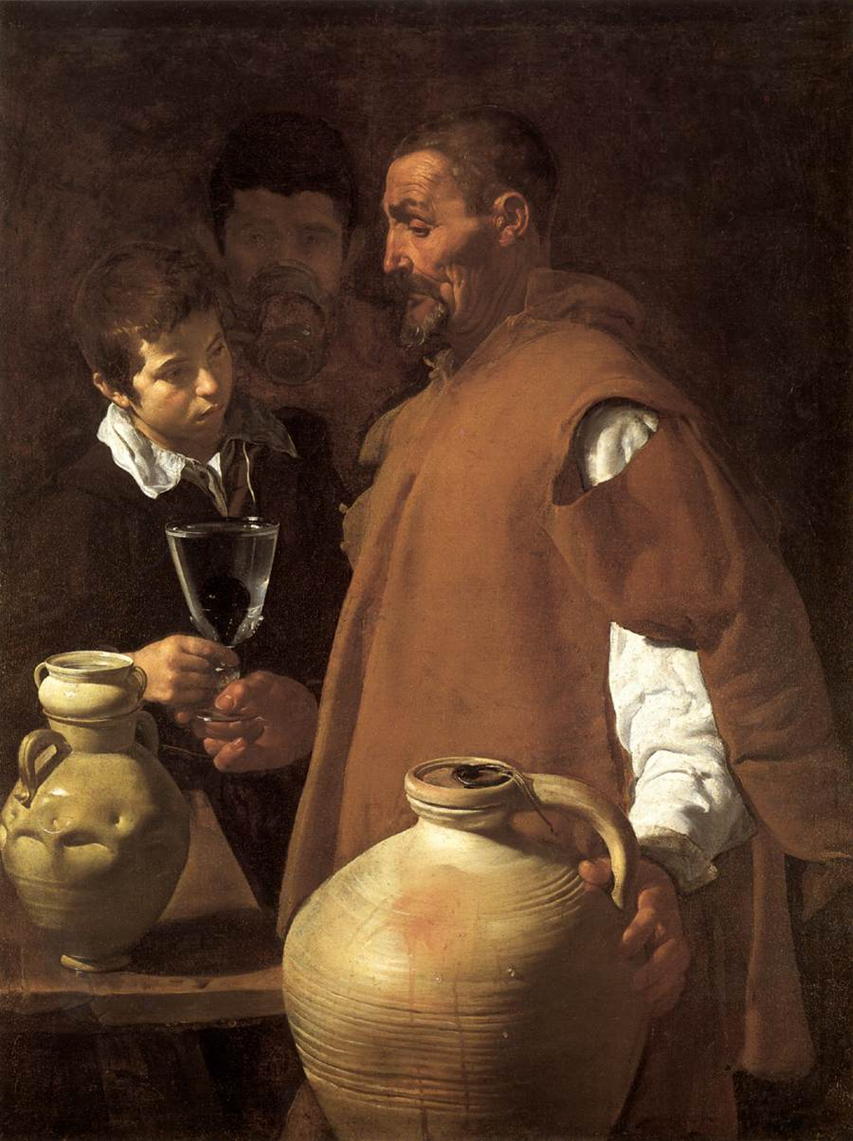
Diego Velazquez
1623
Composition & Figures
The scene focuses on a water seller, a wrinkled older man with a serious, contemplative expression, handing a glass of water to a young boy. In the background, a third figure—barely visible—receives a jug from the seller.
The space is shallow and the figures are close to the picture plane, creating an intimate, almost confrontational experience with the viewer.
Light falls dramatically from the left, spotlighting the textures of clay jugs, water droplets, and facial expressions.
Naturalism & Symbolism
The still-life elements (the massive clay jugs, the translucent glass, the droplets of water) are rendered with almost hyper-real clarity, demonstrating Velázquez’s obsession with optical truth.
The contrast between youth and age—a clean-faced boy and a weathered man—has prompted allegorical interpretations (e.g., life’s passage, knowledge transferred through humility and labor).
Despite the mundane setting, the interaction is imbued with quiet solemnity—the simple act of giving water becomes a gesture of charity, care, and human connection.
Caravaggisti Influence
Velázquez’s use of tenebrism—dark background, sharp light on forms—shows clear influence from Caravaggio, though again, his approach is more restrained and psychological than theatrical.
He likely absorbed these ideas indirectly through the Caravaggisti in Naples and Rome, or through Pacheco's literary and artistic circles in Seville.
Cultural Context
In early 17th-century Seville, water sellers were a common sight, particularly given the city’s hot climate and water quality issues.
This painting presents the working class not as genre caricature, but with profound dignity and realism—a reflection of Counter-Reformation values that elevated everyday piety, humility, and charity.
Versions & Differences
There are three known versions of this subject by Velázquez:
Apsley House, London (most famous) – Considered the best and most refined version.
Uffizi, Florence – Smaller and possibly earlier; differences in the arrangement of the jugs and figures.
Private collection – Less well-known, considered a workshop piece or copy.
Significance
Often seen as Velázquez’s Sevillian masterpiece, The Water Seller illustrates his early ability to merge genre, portraiture, and still life into a unified, emotionally resonant whole.
It prefigures the psychological depth and material precision that would define his court portraits in Madrid, especially his portrayals of court dwarfs, philosophers, and marginalized figures.
Immaculate Conception
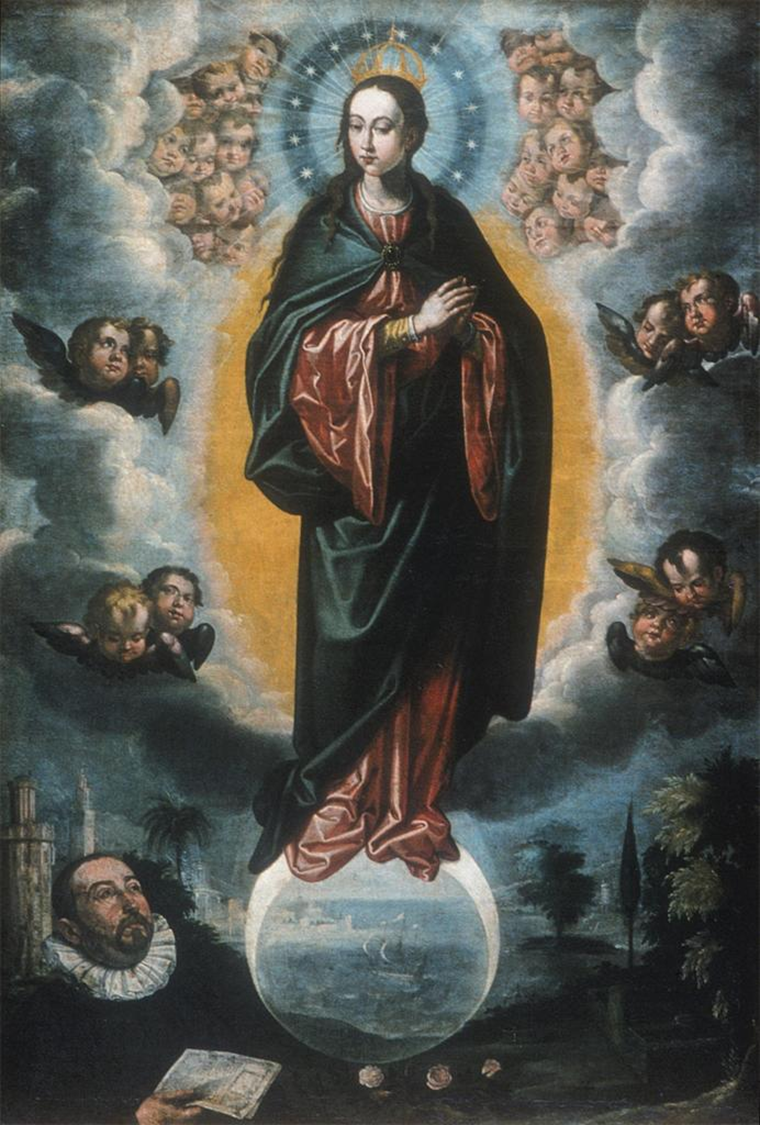
Francisco Pacheco
1616-17
Subject & Iconography
The Immaculate Conception refers to the belief that Mary was conceived without original sin, a doctrine passionately defended in Spain before it became dogma in 1854.
Pacheco’s Virgin follows the standardized iconography he championed in his treatise Arte de la pintura (1649):
A young, beautiful, and modest Virgin, around 12 or 13 years old.
Dressed in a white tunic and blue mantle, with flowing hair.
Surrounded by symbols from the Song of Songs and the Litany of Loreto, including:
Mirror, tower of David, gates of heaven, fountain, palm, cypress, roses, lilies, and sun and moon.
She is crowned with stars and often shown with the moon under her feet, echoing the Apocalyptic Woman from Revelation 12:1.
Angels often hover below her, supporting or surrounding her.
Style & Composition
The composition is vertical and symmetrical, exalting the Virgin in heavenly space, isolated from earthly elements.
The color palette is relatively cool and soft, dominated by the whites and blues that would become synonymous with Marian purity.
The naturalism is tempered by a desire for idealization and modesty; Pacheco avoids sensuality or dramatic flourish.
Theological Precision
Pacheco was deeply invested in the correct depiction of sacred subjects, especially the Virgin. He was appointed official censor of religious imagery in Seville by the Inquisition.
His formula for the Immaculate Conception became foundational for future artists, including Murillo, who adapted the model into his own more emotional and tender renditions in the later 17th century.
Legacy & Influence
Pacheco’s treatise on painting would have a long afterlife, especially influencing Sevillian and Spanish Marian iconography.
His depiction of the young, celestial Virgin shaped the standard across Spain and Spanish America.
Though not known for technical brilliance, Pacheco’s strength lay in his clarity of purpose, religious orthodoxy, and role as a theorist and mentor—qualities that helped form the visual identity of Spanish Catholicism.
Immaculate Conception
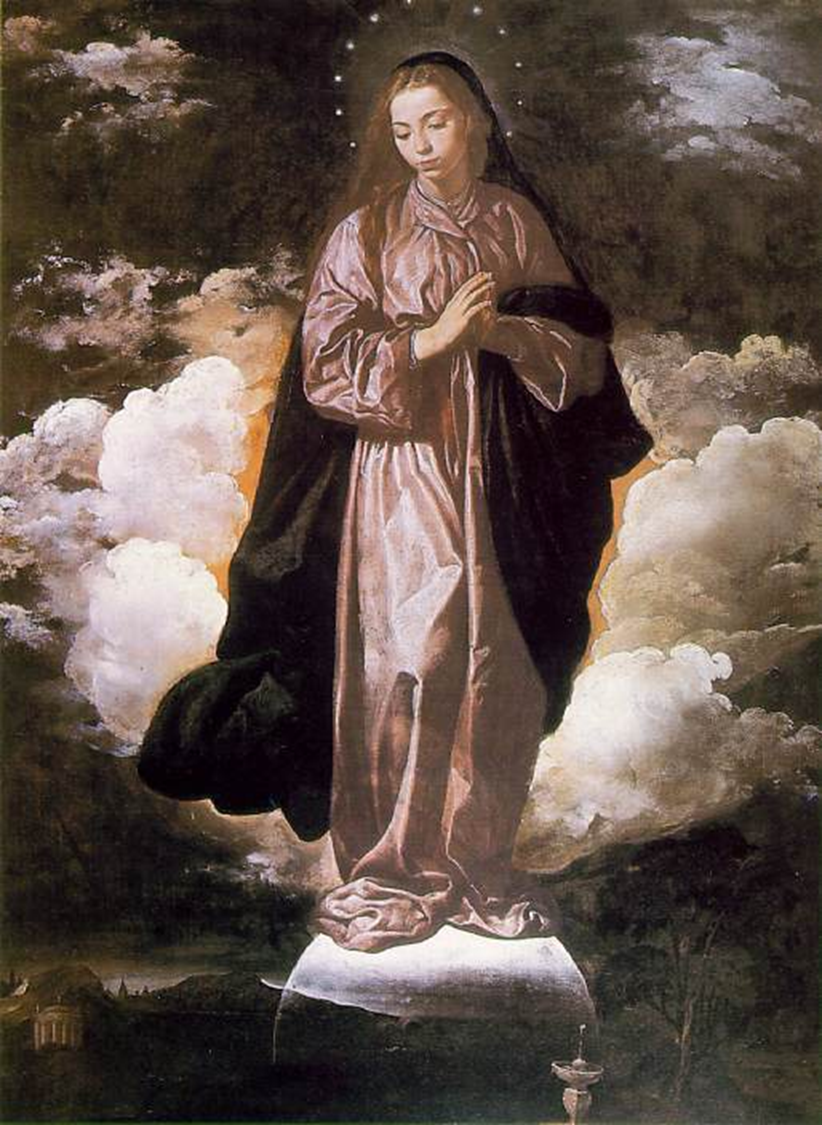
Diego Velazquez
1618
Subject & Iconography
The painting depicts the Virgin Mary at the moment of her Immaculate Conception, a belief central to Spanish Catholicism and fervently championed by the Franciscans and Pacheco’s intellectual circle.
Standard iconographic elements include:
The young Virgin, depicted as a modest adolescent, as prescribed by Pacheco.
Dressed in the white tunic and blue mantle of purity and heavenly grace.
Crowned with stars, with the crescent moon under her feet, referencing the Apocalyptic Woman from Revelation 12:1.
Surrounded by cherubs, floral and symbolic elements, including roses, lilies, and a mirror, alluding to Marian litanies.
While Pacheco’s theoretical guidance is evident, Velázquez interprets the theme with a personal, intense naturalism.
Style & Technique
Velázquez uses dramatic chiaroscuro, placing the luminous figure of Mary against a dark background, evoking a Caravaggesque spirituality.
The composition is more intimate and grounded than Pacheco’s didactic formulations—less ethereal, more emotionally immediate.
The Virgin's expression is serene but human, with naturalistic features that suggest Velázquez may have used a live model.
The cherubs and symbolic elements are rendered with tactile realism, showing off his early mastery of texture, light, and form.
Comparison with Pacheco
Pacheco’s versions are more idealized, hieratic, and symmetrical, reflecting his theological concern with orthodoxy.
Velázquez, while respecting the doctrinal program, focuses on psychological realism and pictorial presence.
This version subtly shifts the Immaculate Conception from a purely doctrinal image to one that is also meditative and emotive.
Legacy
Velázquez would soon abandon such explicitly religious subjects in favor of portraiture and historical scenes, especially after moving to Madrid.
However, this painting reflects how young Velázquez was capable of elevating even formulaic religious themes through the sheer force of his painterly insight and realism.
It is an early sign of his genius, showing how even within the constraints of Counter-Reformation art, he could forge a distinctive voice.
Infante Don Carlos
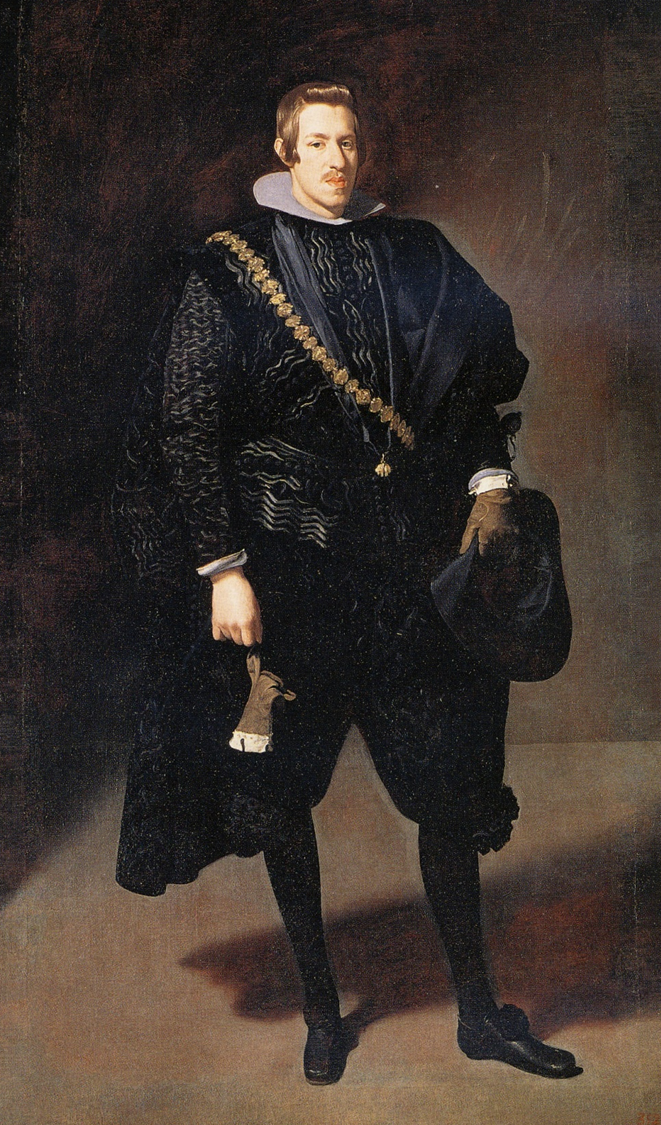
Diego Velazquez
1629
Context
Painted in 1629, this full-length portrait of Infante Don Carlos, the younger brother of King Philip IV of Spain, represents a key moment in Velázquez’s early royal career. By this time, Velázquez had secured a position as court painter in Madrid and was becoming a favored portraitist of the Habsburg elite.
Subject
Don Carlos (1607–1632) was the second son of Philip III and Margaret of Austria. Though he never held significant political power, his noble stature and connection to the Spanish monarchy necessitated a portrait in the grand style of court imagery. His early death in 1632 adds a sense of poignancy to this commanding representation.
Composition & Style
Format: Full-length, life-sized, standing three-quarter view — a format reserved for high-ranking royals and nobility.
Attire: Don Carlos is dressed in formal court dress: rich black garments embroidered with silver, a stiff white ruff, and the red sash of the Order of the Golden Fleece, denoting high noble status and dynastic honor.
Pose: He stands rigidly with a baton in one hand, a symbol of military command or princely authority, and his other hand resting on a table.
Backdrop: A dark, neutral background and subdued interior setting emphasize the sitter’s figure and regal bearing without unnecessary distraction.
Velázquez’s Signature Style
Naturalism within decorum: Velázquez manages to humanize his royal subject subtly, showing a young man who is both delicate and dignified, rather than an idealized symbol of majesty.
Mastery of black: Spanish court portraiture emphasized black attire to signify nobility, modesty, and power. Velázquez’s ability to paint tonal variations in black – using fine highlights and textures – is masterful and would later become a hallmark of his work.
Psychological insight: Despite the formality, Don Carlos’s expression is slightly reserved, almost fragile, conveying the prince’s youth and perhaps his uncertain future within the court hierarchy.
Comparison with Other Court Portraits
This portrait sits within the tradition of Titian and Rubens, who influenced Spanish royal portraiture.
Compared to Velázquez’s later portraits of Philip IV or Prince Baltasar Carlos, this image is slightly more reserved and formal, reflecting Don Carlos’s more peripheral role at court.
The influence of his first Italian trip (1629–30) is just beginning to emerge, seen in the subtleties of modeling and increased sophistication of pose.
Significance
An early triumph in Velázquez’s royal portraiture, this work helped cement his place in the Madrid court.
Demonstrates Velázquez’s emerging ability to combine hierarchical imagery with nuanced realism.
Though not as widely known as his later portraits, this work marks a crucial step in the evolution of court portraiture, paving the way for his more psychologically complex depictions in the 1630s–50s.
pintor del rey
Painter to the king or king’s painter.
The Drinkers (Los Borrachos)
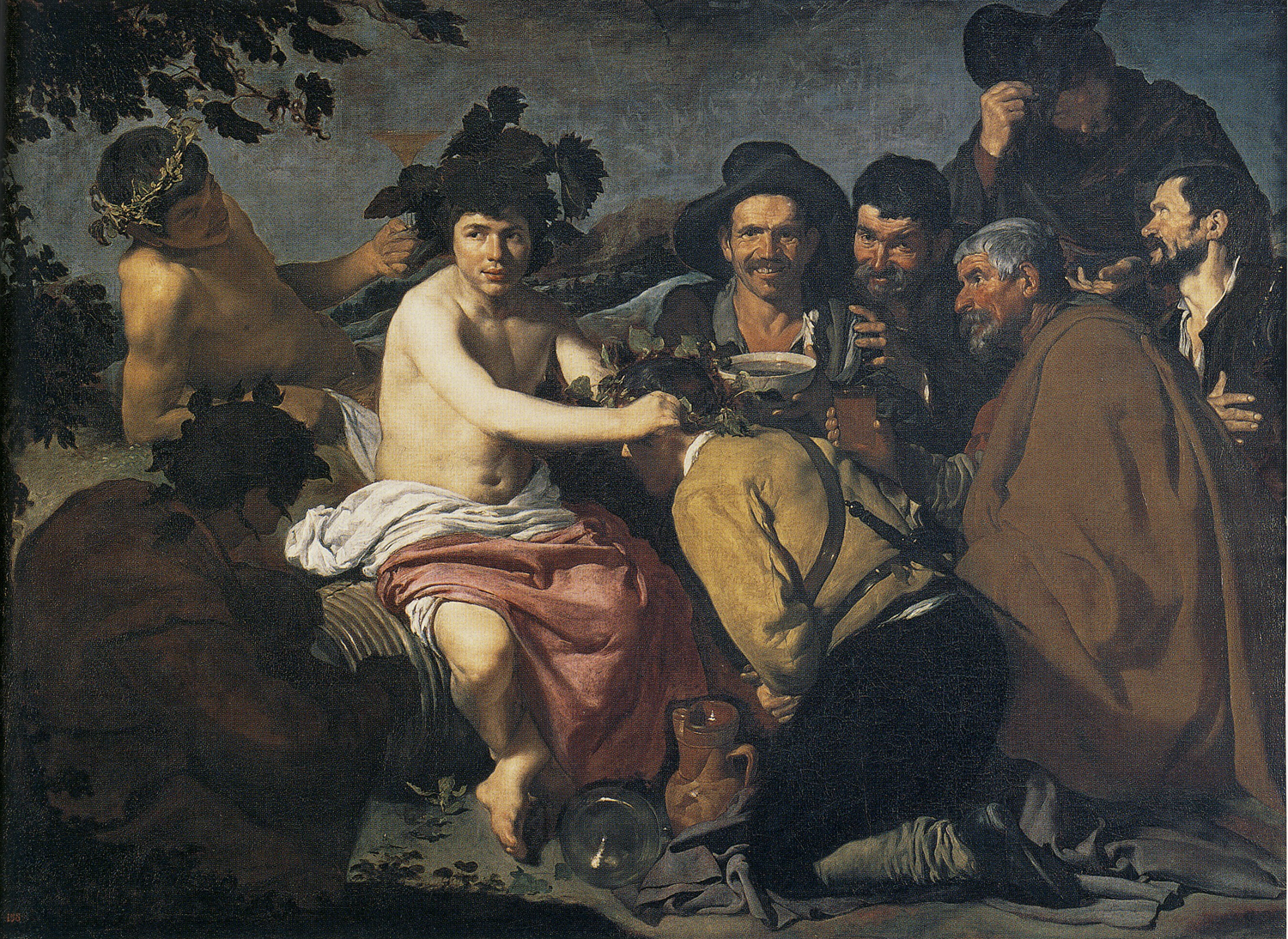
Diego Velazquez
ca. 1628
Context
Painted shortly after Velázquez’s arrival at the Spanish court, The Drinkers is one of his earliest large-scale mythological paintings. Created around 1628, just before his first trip to Italy, this work showcases a hybrid approach that combines mythology with everyday realism—a signature Velázquez move. It was likely commissioned for Philip IV, who appreciated both classical themes and earthy humor.
Subject & Narrative
This painting presents a bizarre and humorous fusion of the classical god Bacchus with Spanish peasant drinkers. The title Los Borrachos (“The Drunks”) emphasizes the earthly tone, while the official title, The Triumph of Bacchus, hints at classical aspirations.
Center: Bacchus (Dionysus), nude to the waist and crowned with ivy, sits atop a wine barrel, offering a crown of vine leaves to a kneeling drunkard.
Surrounding figures: A group of ordinary, somewhat scruffy Spanish peasants revels in his presence. One man grins directly at the viewer, breaking the fourth wall with a knowing look.
The group appears to be caught mid-celebration, wine cups in hand, showing signs of intoxication and joy.
Interpretation
Velázquez merges mythological allegory with genre painting, transforming the triumph of Bacchus into a celebration of earthly pleasure and camaraderie. The god of wine is no longer ethereal; he’s down-to-earth and approachable, granting temporary relief from daily hardship.
The peasant figures are carefully individualized, possibly based on real models, reflecting Velázquez’s Sevillian roots and affinity for tenebrism and naturalism.
The crown Bacchus offers may symbolize the momentary ‘divine’ ecstasy wine provides to the working class—pleasure as a brief escape.
Stylistic Elements
Chiaroscuro/Tenebrism: Influenced by Caravaggio, Velázquez uses dramatic light to highlight the central figures while the background dissolves into darkness.
Naturalism: Each figure is painted with realistic textures, gestures, and expressions—no idealization, only brutal honesty and wit.
Color palette: Earthy and subdued, with subtle highlights on skin and cloth, reinforcing the sense of reality and grounding the mythical theme.
Significance
Marks Velázquez’s first foray into mythological painting, a theme he would revisit later (e.g., Apollo at the Forge of Vulcan, The Spinners).
Demonstrates his ability to blend genres, elevating the everyday with classical resonance.
Seen as a playful critique of idealized mythology, suggesting that divine pleasure is not reserved for gods or heroes, but shared in the taverns of Madrid.
Connections
Compare to Caravaggio’s Bacchus (1596-97) – both show a grounded, earthy interpretation of the wine god.
Foreshadows Velázquez’s later exploration of illusion, satire, and human psychology, especially in Las Meninas and The Spinners.
Could be read as an early form of social commentary—a painter at court reflecting on the lives of those outside of it.
The Surrender of Breda
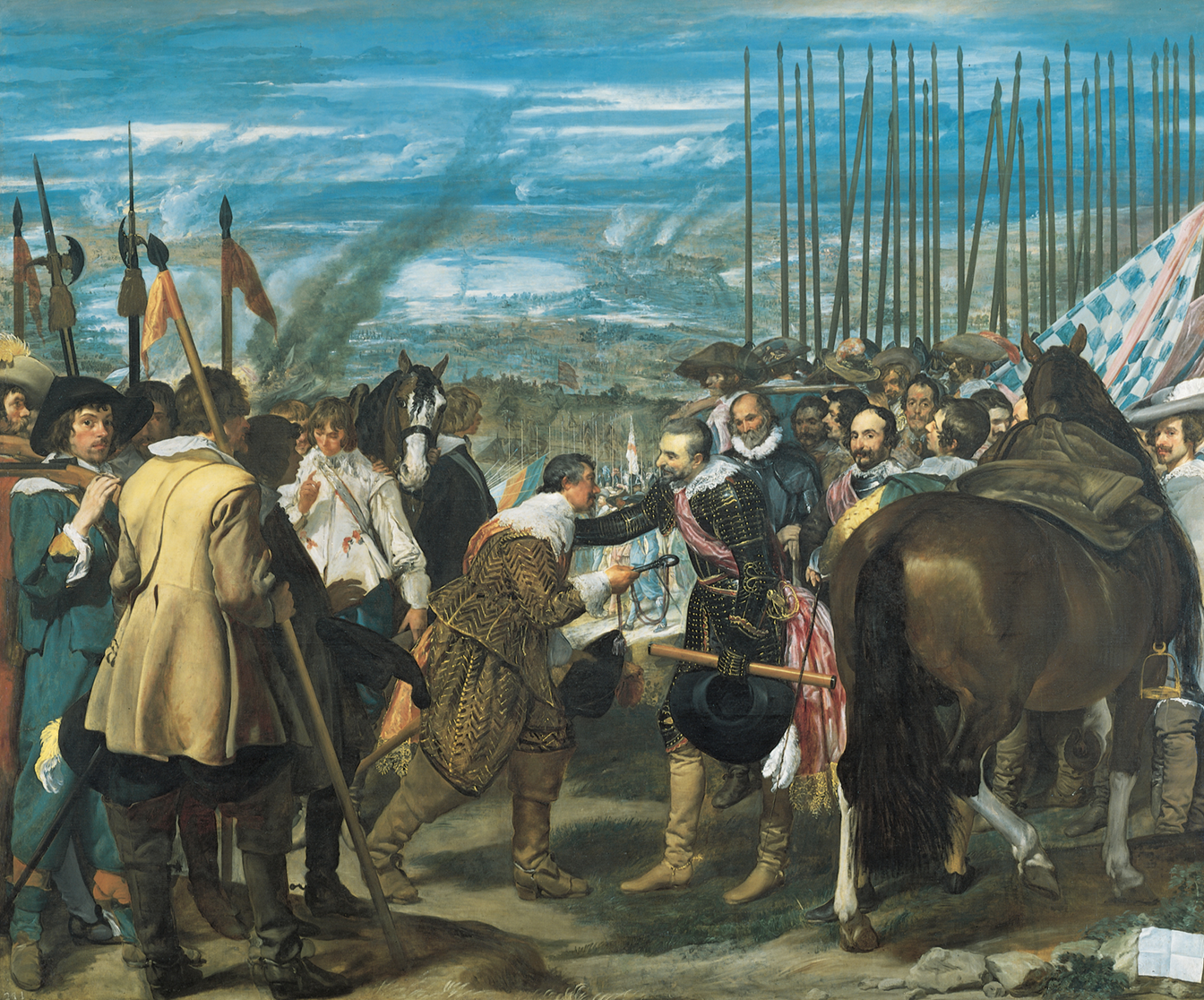
Diego Velazquez
1634-35
Context
Commissioned for the Hall of Realms in the Buen Retiro Palace in Madrid, The Surrender of Breda is one of Velázquez’s most celebrated history paintings. Created between 1634–35, it was part of a series glorifying the military achievements of Philip IV’s reign—but Velázquez approaches the subject with unusual restraint and humanism, setting it apart from typical Baroque triumphalism.
Historical Event
The painting commemorates the Spanish victory over the Dutch at Breda in 1625 during the Eighty Years’ War. The city’s surrender was led by the Dutch commander Justinus of Nassau, who handed over the keys to the Spanish general Ambrogio Spinola.
Velázquez didn't witness the event himself. His portrayal is based on accounts and perhaps on input from Spinola, with whom he was friendly.
Rather than glorifying battle, Velázquez focuses on the moment of reconciliation and respect between opposing leaders.
Composition & Description
The painting is divided into two main groups: the Spanish soldiers (right) with upright lances forming a forest of verticals, and the defeated Dutch (left), with relaxed postures and fewer weapons.
At the center, Spinola gently stops Justinus of Nassau from kneeling, accepting the keys with grace rather than arrogance.
The background shows a smoldering city and distant cavalry, but no graphic battle—Velázquez shifts attention from violence to diplomacy.
Themes & Interpretation
Magnanimity in victory: Spinola’s noble gesture reflects chivalric values rather than conquest.
Human dignity: Velázquez paints both sides with dignity and detail. Even the defeated Dutch are individualized, avoiding caricature or humiliation.
Spanish ideal of honor: Spinola embodies the kind of humane, honorable victory Philip IV would want associated with his rule.
A subtle political message: Rather than a straightforward celebration of Spanish supremacy, Velázquez presents an idealized vision of war as civilized and restrained—a powerful myth of benevolent empire.
Stylistic Features
Naturalistic figures, individualized faces, and masterful handling of light and texture make it painterly yet vivid.
Balanced composition: Despite the asymmetry of the two groups, the image feels stable and harmonious.
Color palette: Earthy and subdued, with accents of red and silver enhancing the uniforms and highlighting Spinola’s figure.
Significance
One of the few major military scenes painted by Velázquez.
Demonstrates his ability to elevate narrative history into psychological drama and moral reflection.
A visual essay on honor, respect, and human character—qualities that outshine even martial victory.
Held up as a masterpiece of political painting—subtle, eloquent, and timeless.
Connections
Compare with Rubens’s more theatrical depictions of war (The Consequences of War), or Jacques-Louis David’s Napoleon Crossing the Alps—Velázquez's restraint is striking.
Related to Baroque ideals of honor and state propaganda, but done with rare nuance and empathy.
Velázquez revisits some of these themes in his later portraits of Philip IV and court figures, where dignity and humanity again take center stage.
Justin of Nassau, Ambrogio Spinola
Justin of Nassau, Breda's governor, surrendered with honors in June. Only 3,500 Dutch soldiers had survived the brutal siege. In capturing Breda, Spinola felt he had avenged his humiliation at Bergen op Zoom. The successful capture of Breda served as the climax of Spinola's career.
Calderon , El Sittio de Breda, 1625
“Justin, I receive them in full awareness of your valor; for the valor of the defeat confers fame upon the victor.”
Equestrian Portrait of Conde-Duque de Olivares

Diego Velazquez
1638
Context
Painted in 1638, this work depicts Gaspar de Guzmán, Count-Duke of Olivares, the all-powerful minister and favorite (valido) of King Philip IV of Spain. As the de facto ruler of Spain during the Thirty Years’ War, Olivares sought to revitalize the monarchy and restore Spanish dominance in Europe. Velázquez’s grand equestrian portrait was part of the political image-making necessary to bolster Olivares’s authority and prestige.
Historical Significance
At the time, Spain was involved in numerous military conflicts, including campaigns in Flanders, France, and Portugal.
Equestrian portraits were traditionally reserved for monarchs and military heroes. By placing Olivares in this form, Velázquez helped elevate his status to near-royal—an image Olivares himself encouraged.
Though the Count-Duke was not a general, the portrait implies martial prowess, leadership, and political might.
Visual Analysis Pose & Composition
Olivares sits confidently atop a rearing baroque Spanish horse, turning dynamically to his left in three-quarter view.
He wears a plumed hat, polished armor, and a commanding red sash, symbols of power and command.
His right hand holds a baton of command, asserting his role as military leader.
The background suggests a battlefield, with cannons and smoke—a fictionalized heroic setting.
Stylistic Features
Velázquez masterfully renders textures: the glint of armor, the sheen of horsehide, the feathers’ softness.
Use of diagonal movement and foreshortening emphasizes dynamism and physical control.
The horse’s rearing pose is modeled after equestrian works like Titian’s Charles V at Mühlberg or Rubens’s own horsemen.
Unlike Rubens, however, Velázquez’s color palette is more restrained, emphasizing a cool, realistic dignity rather than flamboyance.
Themes & Interpretation
Power & Image-making: The painting is as much about ideology as it is about portraiture—projecting an image of control, leadership, and martial authority.
Propaganda: Meant to counteract criticism of Olivares's failed policies and military losses by presenting a heroic, commanding façade.
Idealized realism: Velázquez doesn’t completely flatter—Olivares’s heavyset body and stern face remain—but the compositional grandeur overpowers personal detail.
Connections
Compare with Velázquez’s equestrian portraits of Philip IV and Prince Baltasar Carlos—part of a larger program to decorate the Hall of Realms at the Buen Retiro Palace.
Also contrasts interestingly with Rubens’s Henry IV series, where kings and queens were glorified through allegory—Velázquez opts for more controlled realism and subtle psychological insight.
Echoes traditions of Roman imperial equestrian statues, appropriated here for early modern Spain.
Legacy
A landmark in Spanish Baroque portraiture: monumental, theatrical, and psychologically rich.
Reflects the precariousness of power—a bold public image crafted as Olivares’s influence was waning.
Shows Velázquez’s ability to navigate court politics through paint, crafting state-sponsored idealism with layered nuance.
Venus with a Mirror (Rokeby Venus)
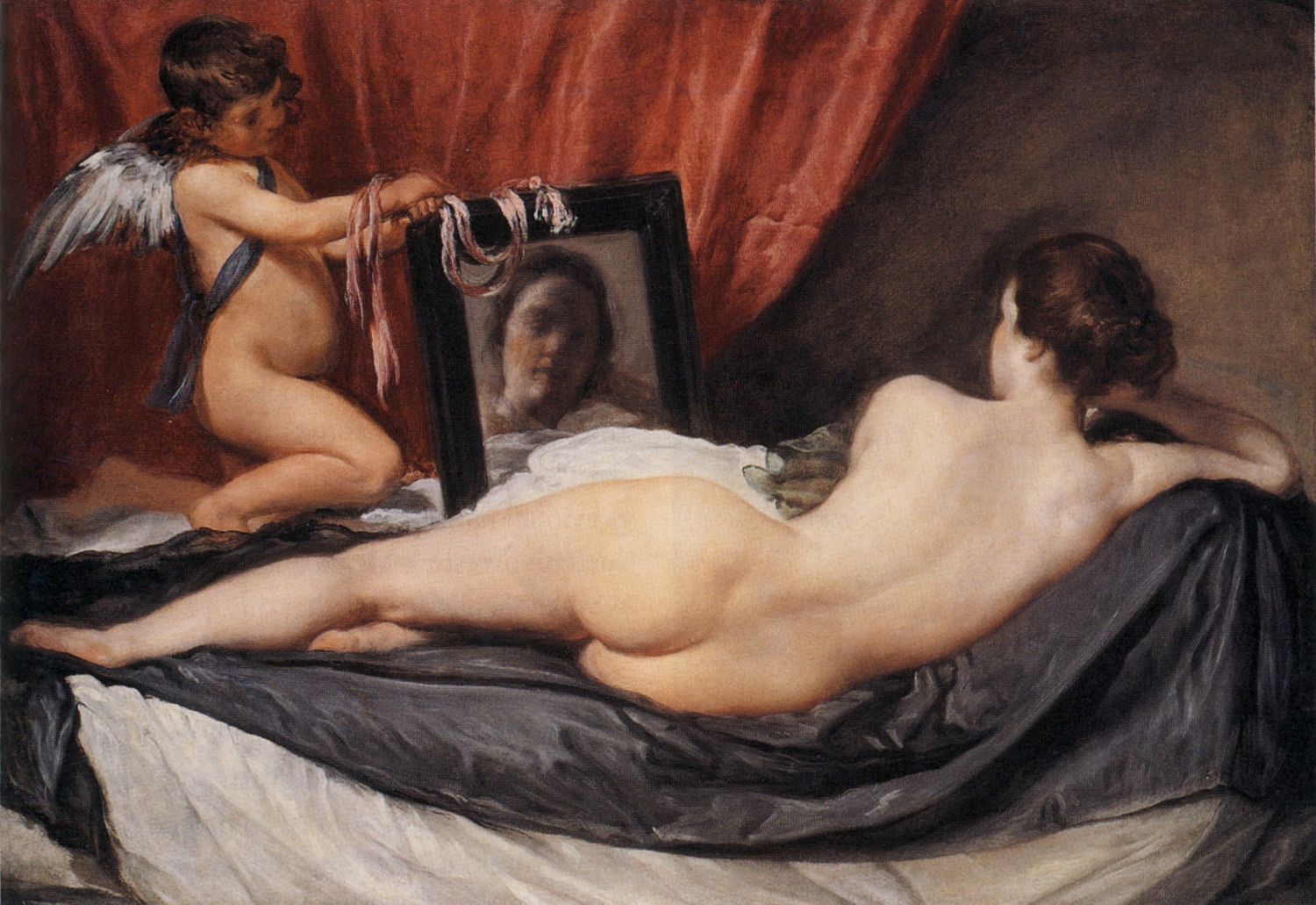
Diego Velazquez
ca. 1648
Context
In 17th-century Spain, nude painting was rare and controversial, tightly regulated by the Inquisition.
Velázquez would have seen Titian’s reclining Venuses (e.g., the Venus of Urbino) in Italy, as well as Rubens’s fleshy goddesses.
The painting was likely created for a private collector, not for public display.
Its nickname, the Rokeby Venus, comes from its time in the Rokeby Park estate in England.
Subject Matter
Venus, the goddess of love, lies on her stomach on a bed, her back and buttocks exposed, a mirror held up by her son Cupid reflects her face.
Unlike traditional portrayals, her face is blurred and indistinct, creating a sense of mystery and anonymity.
Visual Analysis Composition & Pose
The diagonal arrangement of Venus’s body leads the viewer's gaze from her curves to the mirror.
She is seen from behind, yet she engages the viewer indirectly through her reflection.
Cupid, usually a mischievous figure, is unusually subdued, gently holding the mirror—a symbol of love and vanity.
Stylistic Features
The muted color palette—soft grays, warm flesh tones, and rich reds—enhances sensuality while retaining a sense of restraint.
Velázquez employs loose brushwork and subtle tonal modeling to evoke the softness of flesh and the plush texture of fabrics.
The mirror is rendered with a deliberate vagueness, raising questions about identity, beauty, and perception.
Themes & Interpretations
Eroticism vs. Idealism: Venus is sensual but not overtly seductive. Her nudity is softened by her introspective pose and the contemplative gaze in the mirror.
The Gaze: Her reflection raises complex questions—is she looking at herself, or at us? The mirror becomes a tool of both narcissism and voyeurism.
Mythological disguise: Like Titian, Velázquez uses the myth of Venus to cloak the nude in acceptability, allowing viewers to engage with ideal beauty under the guise of classical art.
Painterly self-awareness: The mirror may allude to the artist’s role—creating illusions, reflecting beauty, and shaping perception.
Controversy & Legacy
The painting became a feminist icon after it was famously slashed in 1914 by suffragette Mary Richardson as a protest against the objectification of women.
It is now recognized as one of the great masterpieces of Western art, a rare and subtle depiction of the nude that balances desire, dignity, and ambiguity.
In contrast to Rubens’s opulent goddesses, Velázquez’s Venus is cooler, more modern, and psychologically complex.
Comparisons
Titian’s Venus of Urbino: Both lie in sensual poses, but Velázquez’s Venus is more withdrawn and less decorative.
Rubens’s Venus Frigida: Rubens emphasizes voluptuousness and divine theatricality; Velázquez offers a more introspective, humanized goddess.
Manet’s Olympia: A modern, confrontational reinterpretation of this tradition
Marquis of Eliche
The Marquis of Eliche was a title held by several figures in Spanish nobility, particularly within the House of Olivares. It was also linked to the title of Marquis of Carpio, with figures like Gaspar de Haro y Guzmán holding both titles. The Marquisate of Eliche was a territory and title within the Spanish kingdom, and its holders often played prominent roles in Spanish politics and court life.
Las Meninas (The Maids of Honor)
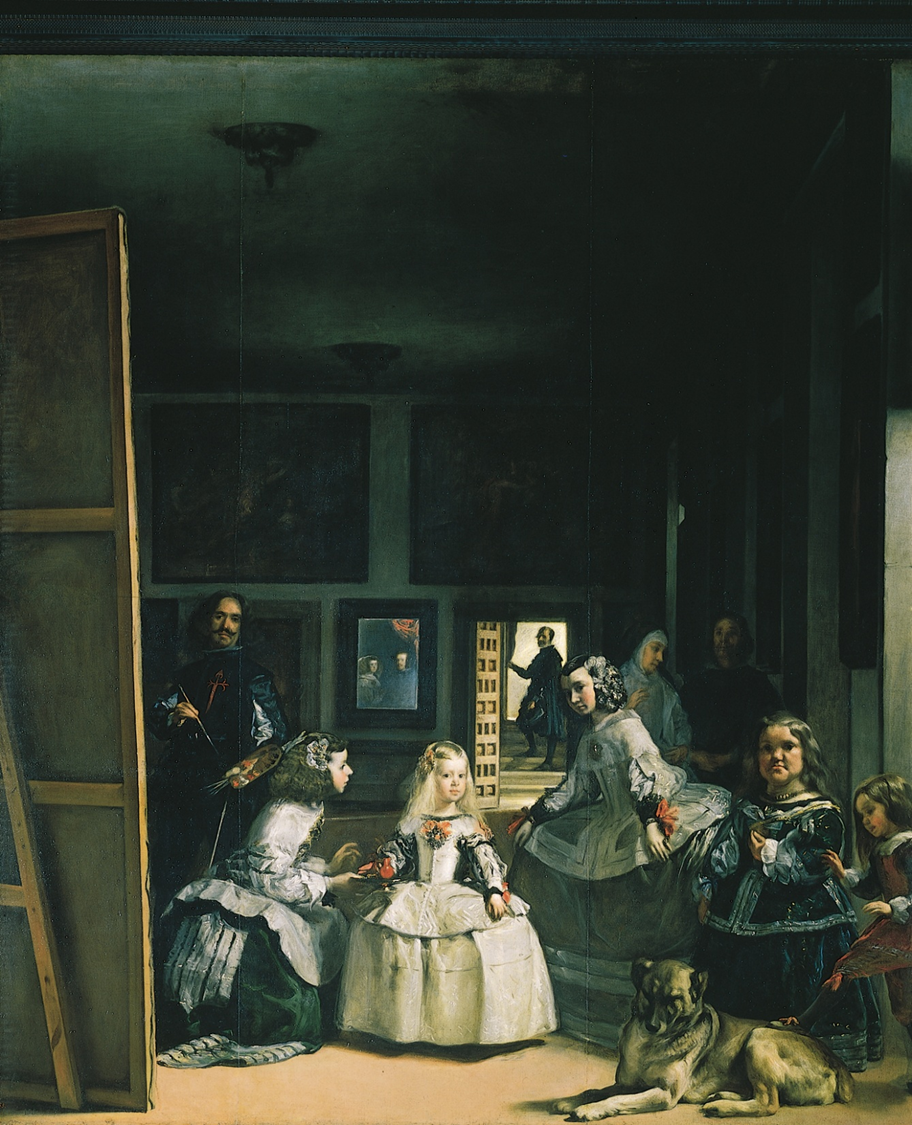
Diego Velazquez
1656
Context
Painted in 1656, it was created for the Spanish court of King Philip IV.
The painting depicts the royal family, specifically Infanta Margarita Teresa surrounded by her attendants, but it is also a self-portrait of Velázquez, who can be seen in the act of painting.
The composition is considered groundbreaking due to its use of reflection, perspective, and the inclusion of the artist within the scene.
Las Meninas is Velázquez's commentary on the nature of portraiture, authority, and the viewer's role in interpreting the scene.
Subject Matter
The central figure is Infanta Margarita Teresa, the young daughter of King Philip IV, surrounded by her attendants, or meninas (maids of honor), a dwarf, and a dog.
Velázquez himself is visible in the background, painting a portrait of the king and queen, whose reflection can be seen in a mirror on the back wall.
The king and queen are not physically present in the room but are implied through their reflection, suggesting the presence of royalty in a subtle, indirect way.
The position of the viewer is crucial—by including the royal family in the act of painting, Velázquez invites us to question whether we are part of the scene, becoming potential observers or even subjects.
Visual Analysis Composition
The composition is dynamic, creating a sense of depth and movement. The space is organized around the center where Margarita stands, with other figures and objects receding towards the background.
Velázquez's inclusion of himself at work as part of the composition is a bold statement about his identity and role as a court artist.
The mirror, which reflects the image of the king and queen, draws the viewer’s attention toward the relationship between the painted world and reality. The viewer’s gaze is aligned with the royal figures, emphasizing their importance while also democratizing the act of observation.
Light and Shadow
Light plays a central role in creating an almost theatrical atmosphere. The light highlights the figures at the front of the room, while the background is shrouded in shadow, creating a sense of intimacy and secrecy.
The precise modeling of the faces enhances the three-dimensionality of the figures and their interaction with the light.
Perspective
Velázquez employs an innovative use of perspective, not just to draw the viewer into the space, but to blur the lines between the real world and the painted world.
The positioning of the viewer’s eye level creates a sense that we are part of the scene, as though we, too, are being observed by the subjects.
Themes & Interpretations The Role of the Artist
Velázquez’s self-portrait is a powerful commentary on the status of the artist in royal courts and in society. By placing himself at the center of the composition, Velázquez suggests that he is not just a passive observer but an active participant in the world of the court.
His position as a courtier is emphasized by the order of the Order of Santiago, worn on his chest—this was an honor granted to him by King Philip IV, marking his high social rank.
Reality and Representation
The painting raises complex questions about the nature of reality, representation, and the power of the gaze. The mirror reflects the king and queen, implying that they are part of the scene, but we never directly see them, blurring the distinction between the real and the painted.
The reflected gaze of the royal figures might even suggest the viewer’s role as both an observer and a subject in the world of the painting.
Court Life and Authority
The scene in the studio also reflects the hierarchy and relationships within the Spanish court. The royal family stands in contrast to the attendants and dwarfs, emphasizing both the distance and connection between the rulers and their servants.
The painting subtly critiques the art of portraiture by acknowledging the role of the artist in constructing the image of power.
Legacy and Impact
Las Meninas has been the subject of countless interpretations and analyses, influencing both artists and philosophers. Figures like Michel Foucault and Ludwig Wittgenstein have engaged with the painting to explore ideas of perception, subjectivity, and representation.
The painting is considered a masterpiece of Baroque art and a culmination of Velázquez’s exploration of perspective, realism, and the complex nature of seeing and being seen.
Artists such as Picasso and Manet have drawn from Las Meninas for their own works, underscoring its enduring impact on the visual arts.
Comparison to Other Works
Velázquez’s earlier works, such as The Waterseller of Seville and The Surrender of Breda, focus more on realism and the portrayal of everyday subjects, but Las Meninas moves into a more philosophical realm, questioning art, identity, and power.
Goya’s later court portraits also engage with the royal subject but do so in a much more critical and sometimes dark manner, which can be seen as a response to the philosophical depth Velázquez achieved in his portrayal of the court.
Infanta margarita
(Her apparent) Margarita
Order of Santiago
Was a medieval Christian military order founded in the 12th century in Spain. It was established to protect pilgrims on the Way of St. James (Camino de Santiago) and to defend Christendom, particularly against Muslim rule in the Iberian Peninsula during the Reconquista. The order's name comes from Saint James the Greater, the patron saint of Spain.
The Fable of Arachne (Las Hilanderas)
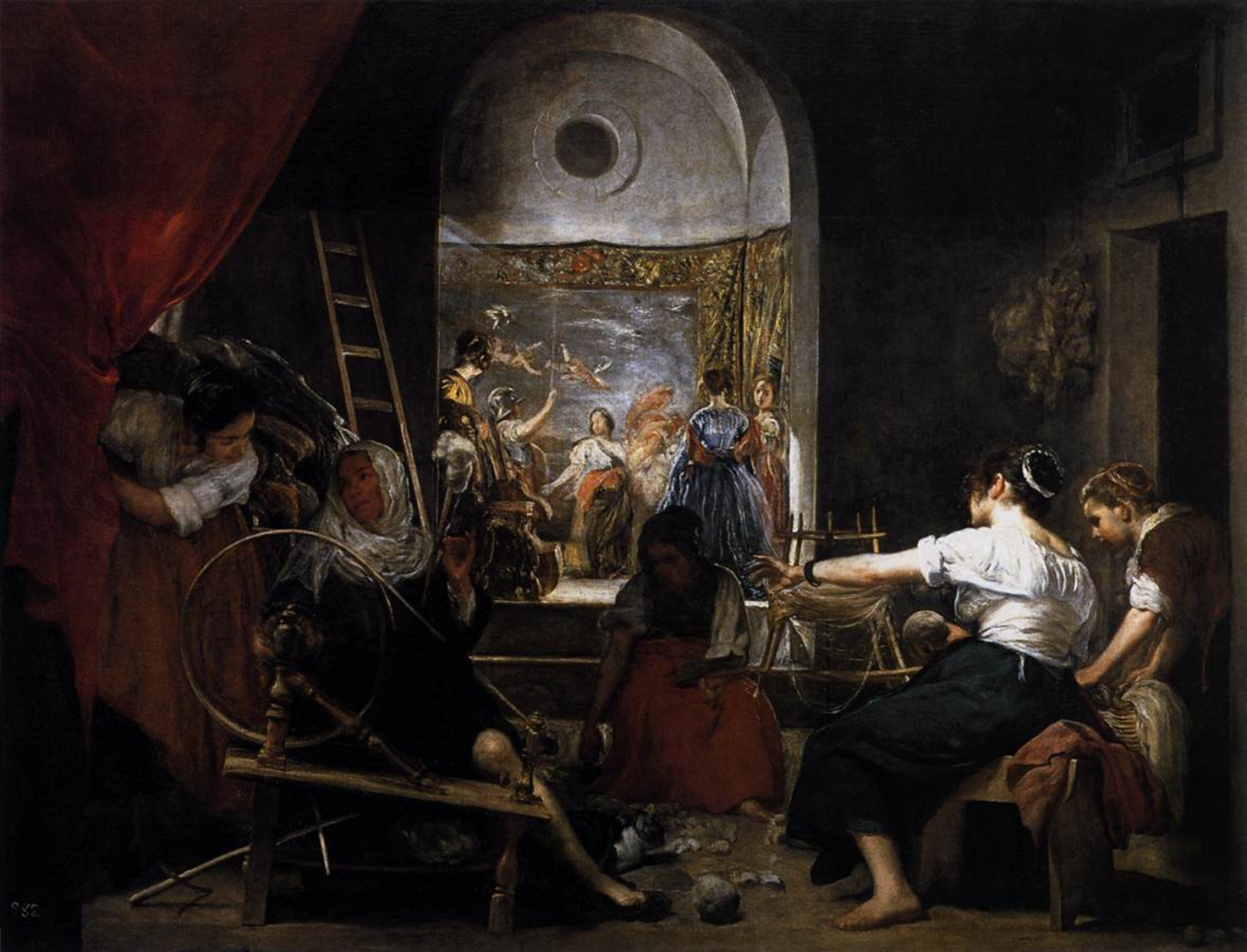
Diego Velazquez
ca. 1657
Context
Velázquez painted Las Hilanderas near the end of his career, just before he painted Las Meninas, and the two works share thematic and technical affinities.
This painting tells the myth of Arachne, a skilled weaver from ancient Greek mythology who challenged the goddess Athena to a weaving contest. After Arachne produced a tapestry that mocked the gods, Athena transformed her into a spider.
Velázquez’s interpretation of the myth goes beyond a simple narrative. It becomes an exploration of the relationship between art and myth, craftsmanship, and the role of the artist in society.
Subject Matter
The scene depicts the weaving contest between Arachne and Athena. Arachne stands at the loom in the foreground, working on a tapestry, while an attendant helps her. The mythological contest is shown indirectly: in the background, a depiction of Athena’s punishment of Arachne—her transformation into a spider—unfolds.
In the foreground, Velázquez presents a meticulous depiction of the act of weaving, highlighting the skill and labor involved in the craft. The act of weaving itself is symbolic of the act of creating art and is often interpreted as a metaphor for Velázquez’s own work as a painter.
In the background, a figure resembling Athena can be seen, representing the goddess’s punishment of Arachne, reinforcing the idea of the tension between human skill and divine judgment.
Visual Analysis Composition
The painting is notable for its detailed rendering of the interior space—Velázquez uses a spacious room, filled with light, to create a sense of depth. The artist’s mastery of perspective is evident as the figures are arranged in a manner that suggests an intimate interaction between the viewer and the subjects.
Arachne is placed in the foreground, absorbed in her task, while the mythological scene unfolds in the background. This dual narrative structure invites the viewer to engage with both the present moment (the act of weaving) and the mythological past (the punishment of Arachne).
Color and Light
The use of light and shadow creates a naturalistic effect, highlighting the texture of the fabrics and the intricacies of the weavings, drawing attention to the craft itself as well as the figures.
Velázquez’s famous “chiaroscuro” technique (the treatment of light and dark) is present here, with the sharp contrasts between light and shadow adding depth to the scene and focusing attention on the figures’ actions.
Use of Space
The space is divided into foreground and background, creating a sense of perspective that adds to the narrative complexity of the painting. In the foreground, Arachne is shown weaving with intense concentration, while in the background, the mythological scene subtly unfolds.
Velázquez’s use of space in this work emphasizes the connection between the real world of craftsmanship and the mythological world of the gods, suggesting the idea that all art, whether it is woven on a loom or painted on a canvas, holds equal significance.
Themes & Interpretations Art, Craftsmanship, and Creation
Las Hilanderas can be interpreted as a commentary on the relationship between art and craftsmanship. The act of weaving is depicted in such painstaking detail, it can be seen as a metaphor for the act of painting itself. Just as the weavers create their intricate tapestries, Velázquez suggests that the artist too must weave together his composition, colors, and narrative to create something of beauty and meaning.
The attention to detail in the depiction of the weaving process points to the artist's reverence for the craft of painting and the skills required to execute it. This could also be seen as a humble acknowledgment of the artist’s role in the world of court society, where craftsmanship is often overlooked in favor of grandiosity.
The Power of Myth and the Artist
In depicting Arachne’s weaving contest with Athena, Velázquez connects the world of mythology with the world of the artist, highlighting that mythology, in its representation of the gods and the divine, is deeply entwined with the creative process of the artist.
The painting might also be seen as a reflection of Velázquez’s own struggles with his identity and status as an artist at the Spanish court. The mythological tale of Arachne can be interpreted as a cautionary story about the dangers of artistic pride, as Arachne’s challenge of the gods leads to her transformation into a spider.
The Relationship Between Artist and Patron
Just as Arachne’s tapestry reflects the goddess’s challenge, Velázquez’s work can be seen as an attempt to present an artistic contest to his patrons in the royal court. The painting blurs the lines between divine art (mythology) and earthly craftsmanship (weaving), subtly suggesting that all art, whether in tapestry or painting, carries divine significance.
The inclusion of mythological references in a highly realistic genre such as still-life and genre painting elevates the act of creating art, making a statement on the role of artistic skill and creativity in shaping human and divine stories.
Legacy and Impact
Las Hilanderas is a profound and innovative work that contributed to Velázquez’s reputation as one of the greatest masters of painting. Its focus on the craft of weaving and its interweaving of mythology with a contemporary setting would influence many later artists, particularly in terms of how the physical process of creating art could be used as a subject of interest in itself.
The painting is also a major influence on later interpretations of the artist’s role, particularly as it raises the question of whether artists should challenge or submit to the expectations of their patrons or the public.
Dutchy of Burgundy
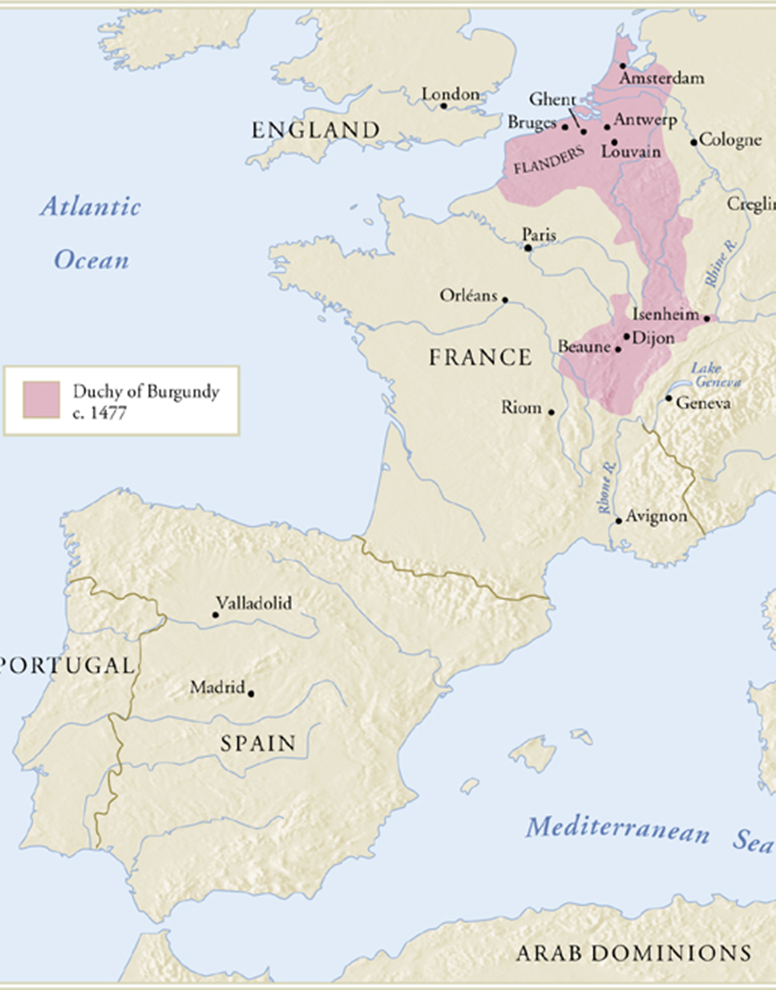
15th century Europe
Francis I
Francis I is primarily known as a Renaissance patron, a humanist, and a knight-king who played a key role in the French Renaissance. He supported artists like Leonardo da Vinci and encouraged humanist learning, solidifying his reputation as a "Father of Letters". Additionally, he was a military leader, engaging in campaigns in Italy and wars with the Holy Roman Empire.
Fontainebleau Chateau, France
Renowned for the large and scenic Forest of Fontainebleau, a favourite weekend getaway for Parisians, as well as for the historic Château de Fontainebleau, which once belonged to the kings of France.
Henry IV
Henry IV of France is known for many things. He is mostly known for improving the lives of protestants by promulgating the Edict of Nantes, which gave protestants more rights, and ending the French Wars of Religion.
View of the Point Neuf

Jacques Callot
1629
etching
Historical Context
The Pont Neuf (“New Bridge”) is ironically the oldest standing bridge across the Seine in Paris, completed in 1607 under King Henry IV. By the 1620s, it had become a vibrant center of public life, teeming with vendors, entertainers, soldiers, beggars, and aristocrats.
Callot, originally from Lorraine, traveled widely and spent time in Florence before returning to France. His time in cosmopolitan centers allowed him to refine a style that merged topographical precision with social commentary.
Visual Analysis Composition
The etching is panoramic, showing the full span of the Pont Neuf with its distinctive open sidewalks, which were a novelty at the time.
Callot’s attention to architectural accuracy is clear in the precise rendering of the bridge’s balustrades, niches, and adjoining structures, including the equestrian statue of Henry IV in the background.
The bustling foreground and midground are densely populated with figures, often arranged in miniature narrative scenes: merchants selling wares, street performers, beggars, soldiers, children, and fashionable ladies and gentlemen.
Detail and Technique
Callot employed an etching needle with extraordinary control, producing fine, clean lines that delineate both architectural structures and complex human forms.
He was a pioneer in the use of the échoppe, a tool that allowed for more varied line weights in etching, helping achieve the kind of painterly effect seen in this work.
His figures are animated, often humorous or expressive, contributing to the sense that this is not just a view, but a slice of life captured in motion.
Themes and Interpretation Urban Spectacle and Everyday Life
Callot’s etching is not simply a topographical image; it’s an urban genre scene. The Pont Neuf becomes a stage for the performance of everyday life, reflecting the variety of Parisian society.
By capturing this broad social cross-section, Callot reflects the changing character of the city, where different classes, professions, and personas come into close contact.
Observation and Social Commentary
As in many of his works, Callot observes with a keen, slightly satirical eye, placing particular attention on the peculiarities of human behavior.
While the tone is generally lively and celebratory, some of the figures on the margins—beggars, disabled veterans, and marginalized individuals—hint at the social inequalities beneath the urban surface.
Monumental Architecture as Social Stage
The bridge itself, a symbol of royal power and modern civic planning, becomes a backdrop for the democratic bustle of urban life.
This duality—monument and movement, order and chaos—is central to the etching’s impact. It contrasts imperial permanence with the fleeting moments of daily existence.
Legacy and Significance
Callot’s View of Pont Neuf exemplifies the rise of city views (vedute) that became increasingly popular in the 17th century and later flourished in the 18th with artists like Canaletto.
The work demonstrates the power of etching as a medium for documentary realism as well as narrative engagement.
His blend of technical virtuosity, observation, and subtle social critique would influence not only later printmakers like Hogarth and Goya, but also the broader tradition of urban representation in European art.
The Marriage of Louis XIII and Anne of Austria
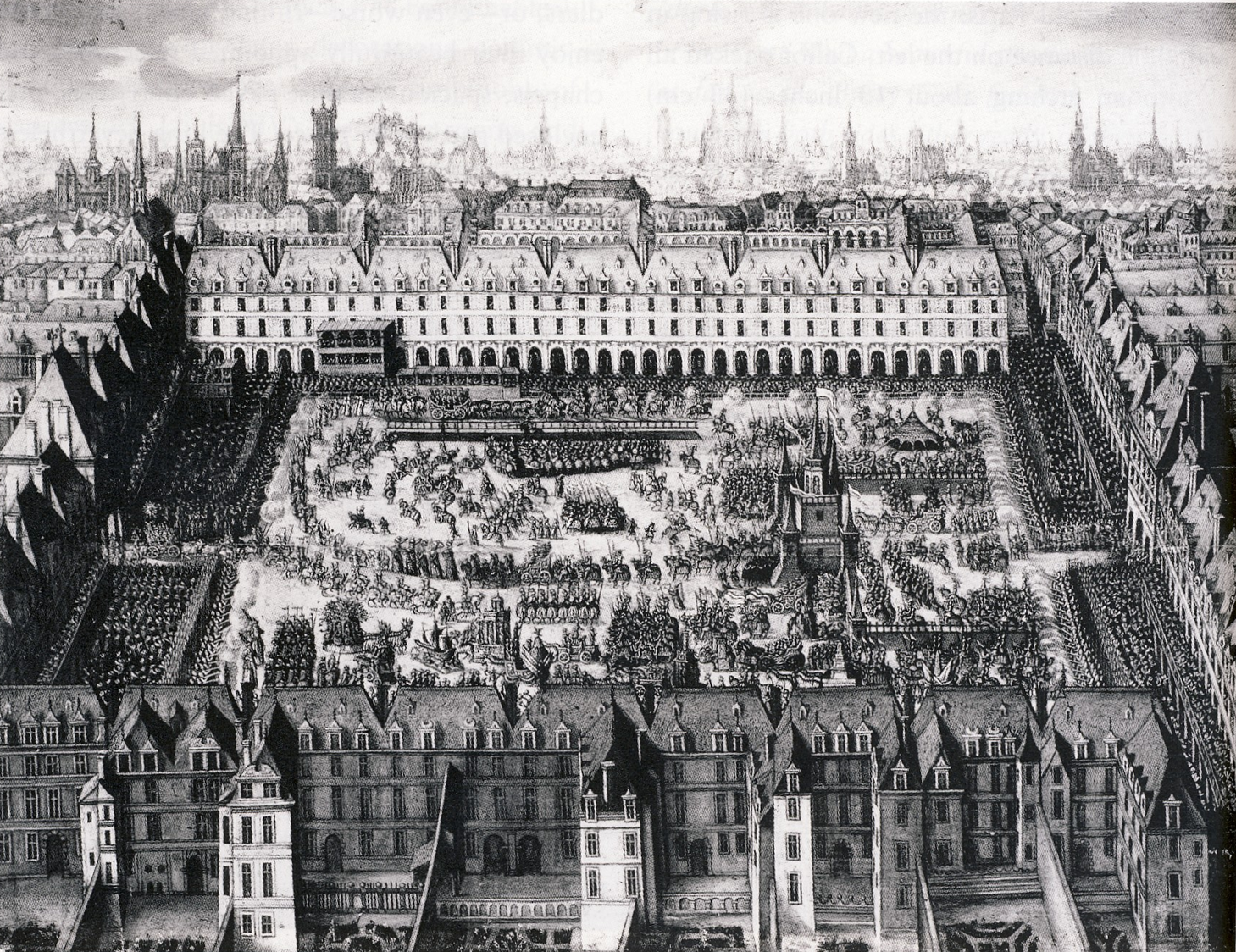
Anonymous
7 April 1612
Place des Vosges, Place Royale Paris
engraving
Historical Context
Louis XIII, son of Henry IV and Marie de’ Medici, was only 10 years old at the time of this celebration.
Anne of Austria, daughter of Philip III of Spain, was also a child. The union was arranged as part of a double marriage alliance between France and Spain to ensure peace between the two powers.
The Place Royale, completed in 1612 under the direction of Henry IV (who had died two years earlier), was the first planned square in Paris, and it served as a fittingly modern and regal stage for the event.
Visual and Symbolic Analysis Composition
The engraving presents a bird’s-eye view of the Place Royale, revealing its symmetrical layout, flanked by elegant arcaded façades and structured around a central space—ideal for public spectacles.
The central square is crowded with spectators, and temporary structures or theatrical stages occupy the plaza, including mythological or allegorical pavilions, perhaps referencing peace, virtue, or the union of nations.
Pageantry and Symbolism
The visual emphasis is on the public nature of royal ceremony, highlighting the performative role of monarchy.
Figures in procession, costumed performers, and decorative banners can be seen—likely representing various virtues or classical figures in keeping with the Renaissance tradition of political allegory.
The engraving reflects the tradition of festival books and prints which documented and disseminated the memory of ephemeral courtly spectacles across Europe.
Themes and Interpretation Dynastic Alliance and Monarchical Legitimacy
The event was intended to project Bourbon authority and reinforce the notion of divinely sanctioned kingship. The alliance with the Habsburgs, France’s traditional rival, was politically expedient, and this public spectacle served to soften opposition by framing it as a harmonious union blessed by Providence.
Urban Space as Theater
The Place Royale becomes a theatricalized space, a key Baroque strategy. The regularity and symmetry of the square create a visual metaphor for order and centralized power, themes deeply connected to monarchical ideology.
This also marks the emergence of modern civic space in Paris—a precursor to later urban transformations under Louis XIV and Haussmann in the 19th century.
The Role of Print in Political Messaging
Engravings like this one were crucial in circulating the image of the monarchy. They were collected, reprinted, and sometimes included in festival books.
The anonymous printmaker’s rendering becomes part of a visual propaganda network, serving both archival and celebratory functions.
Louvre, east facade
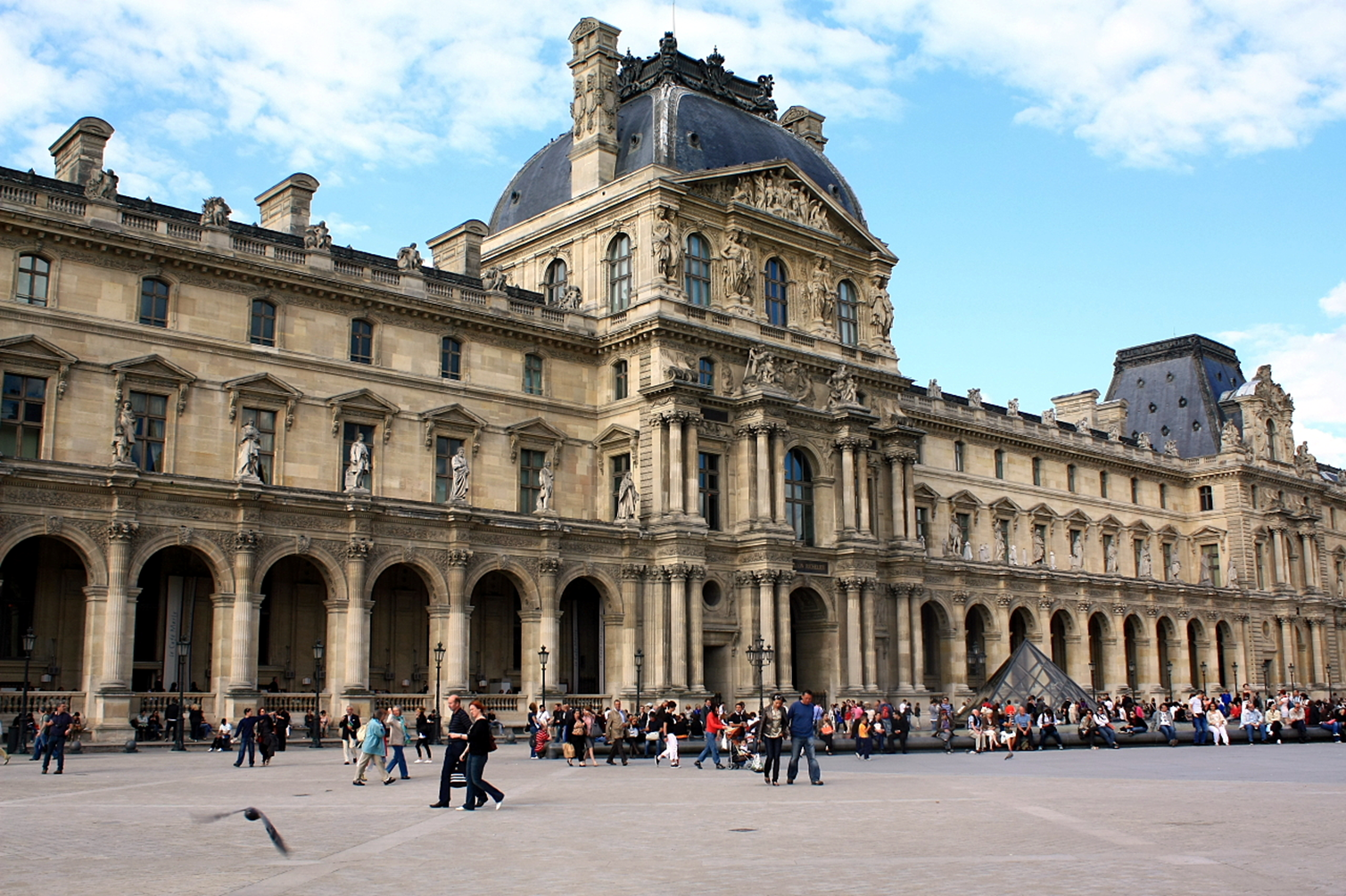
Louis Le Lau with Claude Perrault and Charles Le Brum
Paris
1667-70
French Classical Baroque Classicism
Overview
The east façade of the Louvre, also known as the Colonnade, is one of the most significant architectural statements of French Baroque Classicism, blending classical restraint with royal grandeur. Executed under the reign of Louis XIV, this portion of the palace was designed by a committee led by Louis Le Vau (royal architect), Claude Perrault (a physician and theorist turned architect), and Charles Le Brun (the king’s chief decorator and painter).
The design of the east façade stands as a monument to the centralized power of the Sun King and his preference for classical order, rational geometry, and symmetry, in contrast to the more dynamic, theatrical Italian Baroque.
Historical and Political Context
Louis XIV sought to transform the Louvre from a medieval fortress into a grand royal palace that would embody the glory of the French monarchy.
The east façade project was part of an overall renovation that was eventually abandoned in favor of building Versailles, but this façade became iconic for its monumental, orderly design.
The project represented an architectural dialogue between French and Italian traditions. Though Bernini was invited to propose a design, his vision was rejected in favor of a more restrained French classicism, marking a turning point in defining French national style.
Design and Architectural Features The Colonnade
The façade is marked by a central projecting colonnade of paired Corinthian columns, set on a raised basement and supporting a continuous entablature and balustrade.
It stretches over more than 150 meters, combining grandeur of scale with geometric rigor.
The colonnade evokes classical antiquity, specifically referencing Roman temple fronts and the Pantheon. Yet, its flatness and controlled rhythm contrast with the dynamic sculptural Baroque of Italy.
Symmetry and Proportion
The structure is highly symmetrical, with a central pedimented pavilion flanked by two recessed wings and then smaller end pavilions.
Perrault, influenced by Vitruvius, applied a mathematical approach to proportions, aligning the design with the ideals of rational humanism and scientific order.
The Collaboration
Louis Le Vau began the project as part of his role as First Architect to the King.
Claude Perrault, though not a professional architect, brought theoretical and classical knowledge, likely contributing significantly to the façade’s final classical form. He was also the brother of Charles Perrault, the writer and member of the Académie Française.
Charles Le Brun contributed to the decorative program and overall coordination of visual elements to ensure harmony with the royal aesthetic.
Themes and Interpretation French Baroque Classicism
Unlike the Italian Baroque, which favored dynamism and movement, French Classicism prioritized order, clarity, balance, and grandeur—still theatrical, but contained and cerebral.
The façade reflects absolutist ideology, with the building acting as a metaphor for Louis XIV’s centralized, rational control over both the realm and the arts.
Architecture as Royal Image
The colonnade acts as a public face of the monarchy—massive, authoritative, eternal—broadcasting the majesty of the French state to both Parisians and the wider world.
It reaffirms Paris as the political and cultural center of Europe, rivaling Rome.
Legacy
The east façade of the Louvre became a model for neoclassical architecture in Europe and America (e.g., U.S. Capitol, British Museum).
Claude Perrault's contributions, particularly his translation of Vitruvius and architectural writings, helped theorize French classicism and shaped future generations of architects.
Giant order
An order whose columns or pilasters span two (or more) storeys. At the same time, smaller orders may feature in arcades or window and door framings within the storeys that are embraced by the giant order.
Louis XIV
Often called the "Sun King", is primarily known for his long and impactful reign as King of France, his construction of the Palace of Versailles, and for establishing the concept of absolute monarchy. He also presided over a period of French cultural and artistic flourishing.
Palaces of Versailles

Louis Le Vau and Jules Hardouin-Mansart
1669-85
French Baroque/ Classical Baroque
Overview
The Palace of Versailles is perhaps the most iconic symbol of absolute monarchy in France, representing the transformation of a modest hunting lodge into a grand palace and seat of power for Louis XIV, the “Sun King.” Designed and expanded by Louis Le Vau and later Jules Hardouin-Mansart, Versailles became an architectural embodiment of the king’s political control, aesthetic vision, and divine right to rule.
More than a building, Versailles is a total work of art (Gesamtkunstwerk)—a synthesis of architecture, painting, sculpture, and landscape design, all serving the ideological and theatrical agenda of the monarchy.
Historical Context
Louis XIV moved the French court and government to Versailles in 1682, centralizing power and controlling the nobility by removing them from Paris.
The palace project began under Louis Le Vau, with the envelope (a sheath of new, classical façades surrounding the original hunting lodge) and the garden-facing wings.
Jules Hardouin-Mansart took over in the 1670s and oversaw the construction of the Hall of Mirrors, the north and south wings, and the Royal Chapel.
Versailles reflected Louis XIV’s absolutist philosophy: “L’État, c’est moi” (“I am the state”).
Architectural Features Exterior
The palace façade exemplifies French Baroque Classicism, favoring horizontality, rhythm, and symmetry over the vertical dynamism of the Italian Baroque.
The garden façade features a long, repetitive arcade structure, emphasizing the infinite reach of royal power.
Rich sculptural decorations—royal emblems, classical gods, allegorical figures—reinforce the king’s divine authority.
Hall of Mirrors (Galerie des Glaces)
Designed by Hardouin-Mansart and decorated by Charles Le Brun.
Mirrors opposite large windows reflect light and the gardens, amplifying grandeur and theatricality.
The ceiling paintings glorify Louis XIV’s military victories and divine sanction.
This was the ceremonial heart of Versailles, used for court functions, receptions, and royal entries.
Royal Chapel
Constructed 1689–1710 (completed after Le Vau’s death).
A grand two-story space with Corinthian columns, vaulted ceilings, and rich gilded decoration.
Meant to convey the union of monarchy and Church, reinforcing Louis XIV’s role as God’s anointed ruler.
Interiors and Decoration
Charles Le Brun, first painter to the king, orchestrated an iconographic program glorifying Louis XIV as a new Apollo, king of both arts and arms.
Sumptuous materials—gold, marble, tapestries, mirrors, and painted ceilings—create an overwhelming sensory experience.
Private apartments reflect ceremonial hierarchy, with the King’s Bedchamber at the symbolic center of the palace and court life.
Gardens and Landscaping
Designed by André Le Nôtre, the formal French gardens were as important as the building itself.
The gardens extend the axis of power through geometric parterres, fountains, and sculptures, symbolizing man’s domination of nature.
The Grand Canal, the Orangerie, and smaller pleasure palaces (like the Grand Trianon) formed part of an elaborate network of leisure and spectacle.
Function and Symbolism Versailles as a Theater of Power
Every element of Versailles choreographed ritual and hierarchy.
The court’s daily routine—lever, coucher, receptions—was performed as theater, with the king as the central actor.
Versailles became a political tool, forcing nobles to seek favor and visibility at court, reducing their regional autonomy.
Architectural Propaganda
Versailles is not just a residence; it is architecture as ideology.
Through its scale, planning, and iconography, the palace made manifest the absolutist state and its centralization around the monarch.
Legacy
Versailles set a precedent for court architecture across Europe, influencing palaces from Schönbrunn in Vienna to Peterhof in Russia.
The palace stood as the paragon of Baroque monarchy until the Revolution.
Today, it serves as a monument to French cultural power and a UNESCO World Heritage Site.
Galerie des Glaces (Hall of Mirrors)
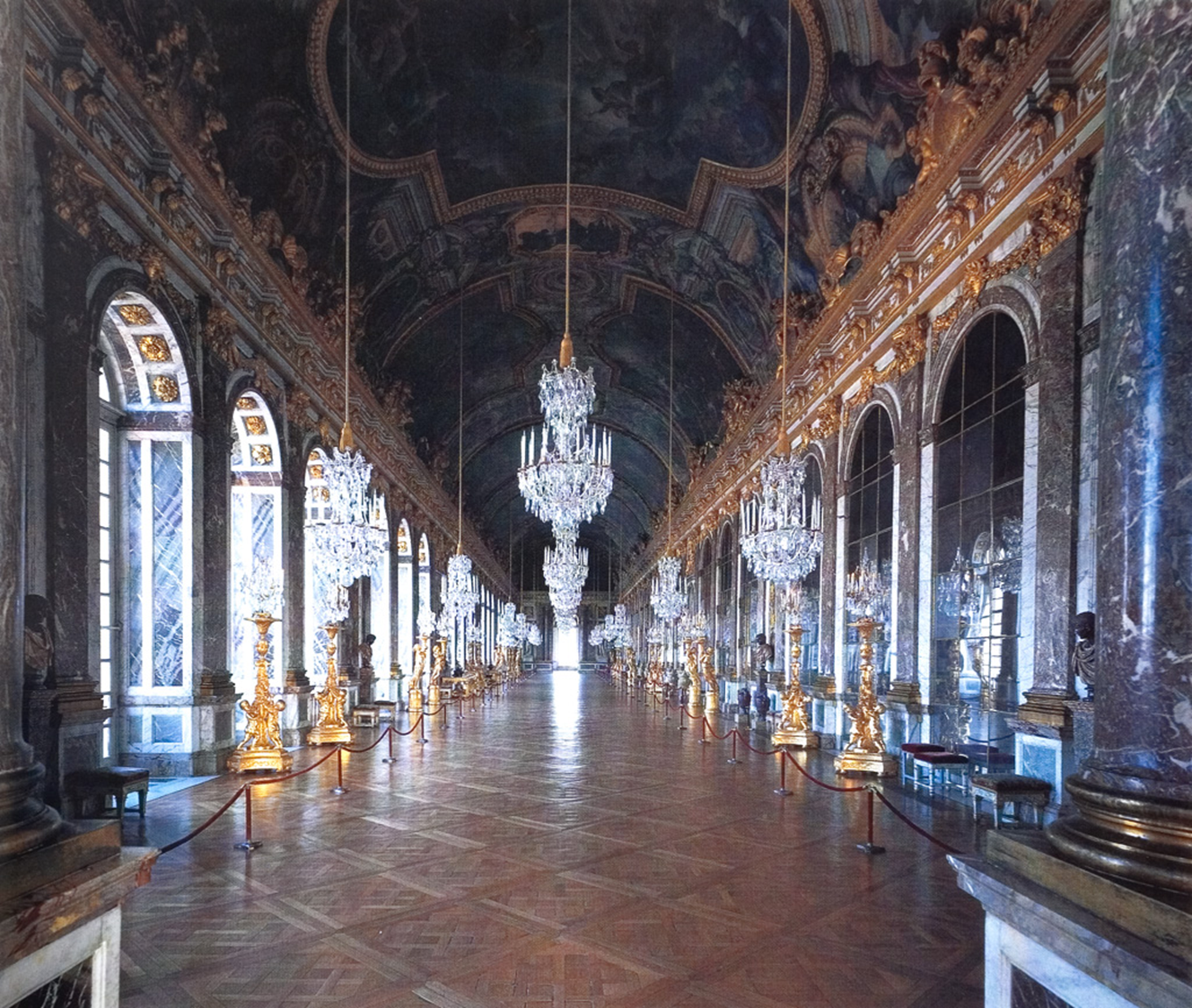
Jules Hardouin-Mansart and Charles Le Brun
Versailles
begun 1678
Overview
The Galerie des Glaces (Hall of Mirrors) is the most iconic and opulent space in the Palace of Versailles, serving as both a throne room and grand ceremonial gallery. It was constructed beginning in 1678 under Jules Hardouin-Mansart and decorated by Charles Le Brun, court painter to Louis XIV. The gallery symbolizes the height of French Baroque splendor, designed to glorify the Sun King and the power of absolute monarchy.
Function and Symbolism
The Hall of Mirrors functioned as a ceremonial passageway, linking the King’s Apartments to the Queen’s Apartments, and was used for daily court rituals, diplomatic receptions, and festivals.
It is a theatrical space, where Louis XIV staged his majesty and power in front of the court.
Mirrors were a luxury good in 17th-century Europe—Venetian glassmakers dominated the market. The presence of 357 Venetian-style mirrors reflects not just light, but also France’s economic and cultural dominance.
The mirrors amplify natural light from the 17 large windows facing the gardens and reflect the architectural grandeur and ceiling paintings, creating an immersive, dazzling environment.
Architectural Features
Length: 73 meters (~240 feet)
Vaulted ceiling: Painted by Charles Le Brun, depicting the military and political triumphs of Louis XIV, particularly after the Treaty of Nijmegen (1678).
Seventeen arched windows are mirrored directly across by seventeen mirror-clad arches—a rhythmic, symmetrical composition that emphasizes spatial infinity and royal omnipresence.
The floor and walls are adorned with gilded pilasters, marble panels, and bronze sculptures, blending architecture, painting, and sculpture into a Gesamtkunstwerk (total work of art).
Ceiling paintings follow a quadratura illusionistic style, where painted architecture extends and dissolves into mythological and allegorical narrative.
Le Brun’s Iconography
The ceiling is a visual manifesto of Louis XIV’s reign, rendered in narrative panels.
It celebrates:
The Peace of Nijmegen
The restructuring of the French state
The defeat of Spain and Holland
Louis XIV as Apollo, god of the sun and patron of the arts
Allegorical figures (Victory, Fame, Hercules) and Roman deities (Jupiter, Mars) underscore the divine nature of Louis's kingship.
Cultural and Political Impact
The Hall of Mirrors became a model of court architecture across Europe.
Its theatricality and reflective surfaces reinforced Louis XIV's status as the center of court life and political authority.
In 1871, it ironically hosted the proclamation of the German Empire after the Franco-Prussian War.
In 1919, it was the site of the Treaty of Versailles, ending World War I—further cementing its historical importance.
Apollo Attended By Nymphs

Francois Girardon
Grotto of Thetis, Versailles
c. 1666-72
Overview
This sculptural group by François Girardon, with contributions by Thomas Regnaudin, was created for the Grotto of Thetis at the Palace of Versailles, and is one of the most poetic visual allegories of Louis XIV’s divine kingship. The ensemble depicts Apollo, god of the sun, reclining after his daily journey across the sky, being attended by sea nymphs and the goddesses of the hours—a mythological scene reimagined as a political metaphor.
Context and Function
The Grotto of Thetis was an artificial cave-like structure built beneath the terraces of the palace, completed by 1676, intended as a mythological retreat and symbolic resting place for Apollo.
It served as a theatrical and allegorical space in the gardens of Versailles, where art, mythology, nature, and royal ideology merged.
The grotto was part of the larger iconographic program at Versailles, which consistently portrayed Louis XIV as Apollo, the bringer of light, harmony, and order.
Iconography and Symbolism
Apollo is shown semi-reclining, nude, with a lyre, emblematic of his roles as god of music, poetry, and the sun.
He is surrounded by nymphs, one of whom bathes his feet—suggesting care and reverence.
The composition represents the resting moment after his solar journey, a divine pause amidst cosmic duty.
The narrative underscores tranquility, divine power, and the care of attendants, mirroring the ceremonial life of Louis XIV, who also staged his day as a performance of cosmic importance.
It evokes ideas of order, harmony, and classical serenity, grounding Baroque theatricality in idealized Classicism.
Artistic Style and Execution
Girardon’s work here is a prime example of French Baroque sculpture, tempered by the restraint and clarity of Classical antiquity.
The figures are elegantly composed, with flowing lines, serene expressions, and polished marble surfaces, evoking the idealized forms of Greek sculpture.
The group shows influence from ancient Roman sarcophagi and High Renaissance sculpture (especially Michelangelo’s Medici Chapel), but is recontextualized in the service of royal propaganda.
Political and Symbolic Resonance
The ensemble visualizes divine kingship: just as Apollo governs the heavens, so too does Louis XIV govern France—restoring peace, culture, and cosmic balance.
The ritualized care of Apollo echoes the daily ceremonies of Versailles, where courtiers attended to the king as a kind of sacred duty.
The grotto, an artificial space of myth and marvel, aligns with Versailles’ theatricality, creating an immersive, controlled world that reflects the absolutist vision of its ruler.
Legacy
Though the original grotto was later demolished, the sculptures were preserved and relocated to the Bosquet des Bains d'Apollon (Apollo’s Bath Grove) in the Versailles gardens, where they remain today.
The group represents the fusion of sculpture, landscape, and royal myth, and was instrumental in shaping the visual language of divine rulership across European courts.
Cardinal Richelieu
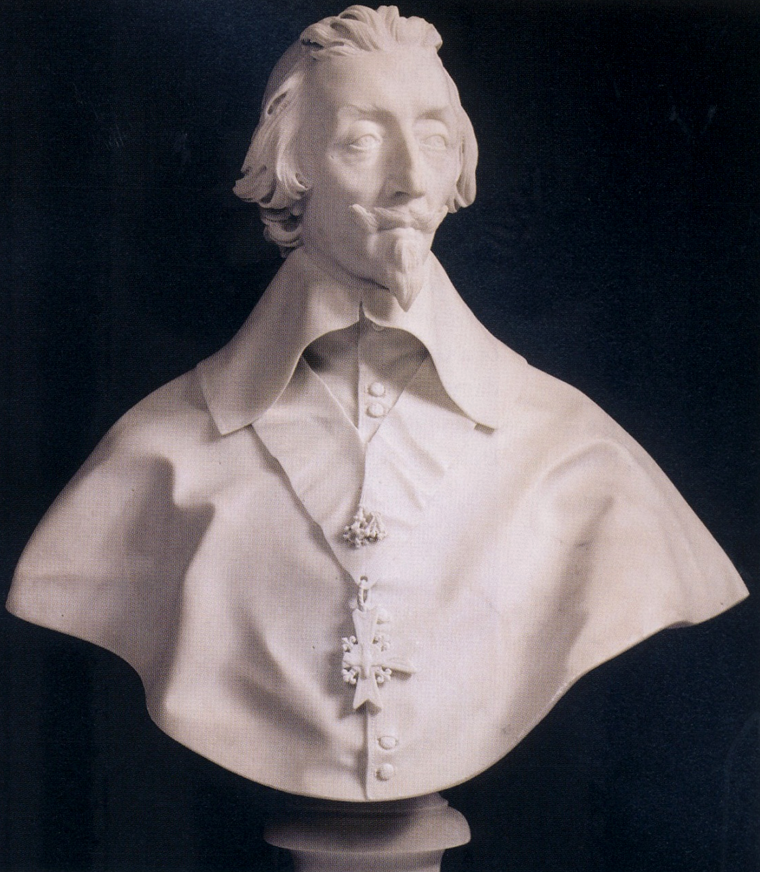
Jean Warin
1641-3
Overview
Jean Warin’s bronze bust of Cardinal Armand-Jean du Plessis de Richelieu, created in the early 1640s, is a powerful example of Baroque state portraiture. Richelieu, chief minister to Louis XIII and architect of France’s emerging absolute monarchy, is shown with dignity, intelligence, and gravitas. The work serves as a sculptural embodiment of political authority and personal legacy.
Artist and Patron
Jean Warin (1604–1672) was a prominent medalist, sculptor, and engraver. He served as Engraver-General of France, responsible for official royal medals and portraiture.
Warin specialized in bronze portraiture and was heavily involved in court art and propaganda.
Cardinal Richelieu, always conscious of his image and power, likely commissioned the bust in his final years as a means of cementing his legacy.
Visual Analysis
The bust presents Richelieu with a calm, composed expression, gazing slightly upward—a typical pose for evoking both spiritual contemplation and political foresight.
He wears his ecclesiastical robes, including the mozzetta and lace-trimmed rochet, as well as the order of the Holy Spirit, symbolizing his dual role as a churchman and statesman.
Warin achieves a remarkable degree of realism in texture and detail, especially in the soft modeling of the face, the textile folds, and the careful polishing of the bronze surface.
There is a stoic timelessness to the portrait, reflecting Richelieu’s lasting impact on French politics, culture, and absolutism.
Political and Symbolic Meaning
The bust functions as visual propaganda, reinforcing Richelieu’s status as the intellectual and spiritual architect of the French monarchy.
His calm demeanor and authoritative bearing signal control, reason, and unshakable resolve, qualities closely tied to his real-life persona as the power behind the throne.
It aligns with the broader goals of Baroque portraiture to convey more than likeness—to express power, presence, and legacy.
Legacy
Warin’s bust is among the most iconic images of Richelieu, rivaling even the painted portraits by Philippe de Champaigne.
It helped establish the format and expectations for official French bust portraiture in the 17th century, influencing later sculptors like Coysevox and Girardon.
The work speaks to the fusion of art and politics in early modern France—how sculpture could immortalize the persona of a figure as complex and consequential as Richelieu.
Town Hall, doorway
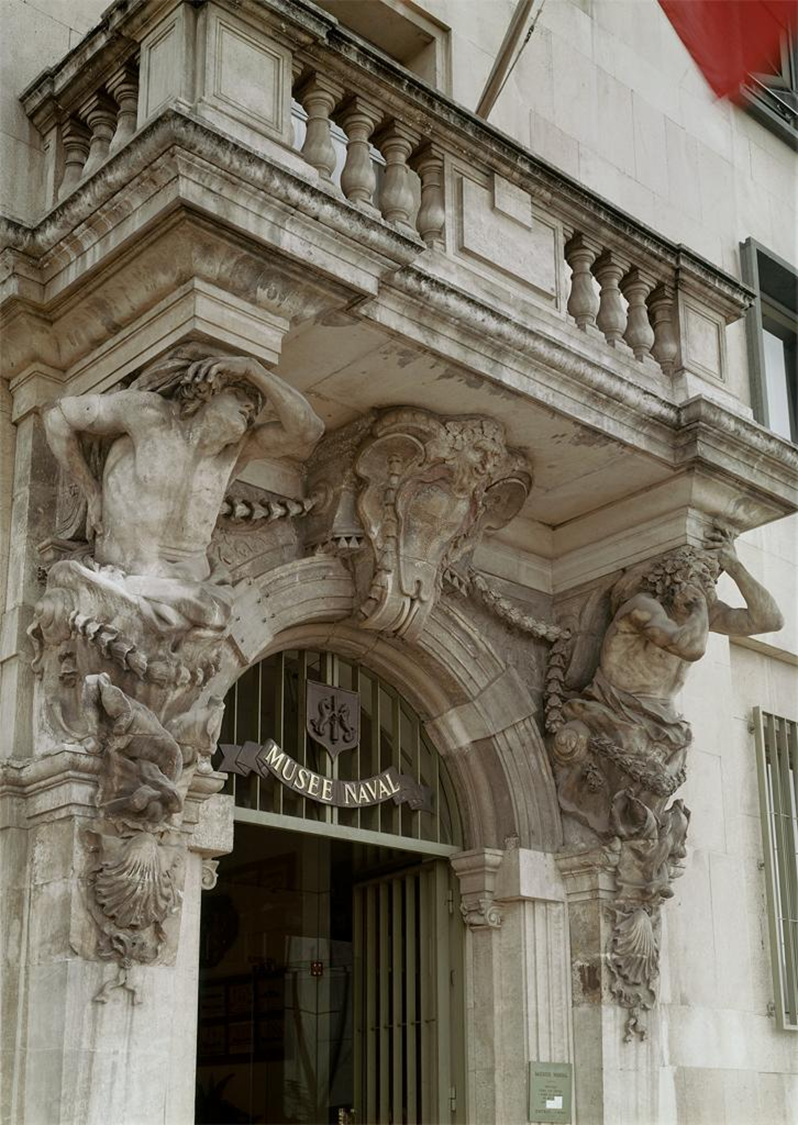
Pierre Puget
Toulon
1656-57
Overview
The doorway of the Town Hall in Toulon, designed and sculpted by Pierre Puget, is a dynamic example of Baroque architectural sculpture in France. It represents the fusion of sculpture and architecture, transforming a civic building into a stage for dramatic allegory and virtuoso carving.
Artist Background
Pierre Puget (1620–1694) was a painter, sculptor, and architect, often regarded as the most Italianate of French Baroque artists.
He trained in Italy, absorbing the dramatic expressiveness of Bernini and other Roman Baroque artists.
Puget often worked in the south of France and brought a vivid theatricality to his sculptural commissions, even in civic contexts like this.
Visual Analysis
The doorway acts as a monumental portal, but also as a sculptural composition in its own right.
Flanking the entrance are two large, deeply carved telamones (also called atlantes)—muscular male figures that serve as architectural supports.
These figures strain under the apparent weight of the entablature, echoing classical themes of burden and civic responsibility.
Their exaggerated musculature and torqued poses are reminiscent of Michelangelo’s ignudi or Bernini’s dynamic figures, projecting both tension and motion.
Above them is an elaborate broken pediment with flowing scrollwork and an inscription, reinforcing the Baroque taste for movement and complexity.
Function and Symbolism
Though part of a town hall, the doorway acts almost like a stage set, transforming a mundane municipal building into a symbol of civic pride and strength.
The use of heroic nudity and expressive physicality aligns with ideals of power, virtue, and labor—qualities associated with public service and governance.
The telamones, literally carrying the weight of the state, might be read allegorically as citizens or officials bearing the responsibilities of the city.
Context and Innovation
Puget’s design demonstrates how Baroque aesthetics could be applied to secular architecture, not just churches or palaces.
He breaks away from the restraint of earlier French classical architecture, embracing a Roman Baroque sensibility—more emotive, more sculptural, more theatrical.
This doorway was influential in southern France and represents a turning point in French civic architecture, moving toward expressive monumentalism.
herms
a squared stone pillar with a carved head on top (typically of Hermes), used in ancient Greece as a boundary marker or a signpost.
Milo of Crotona
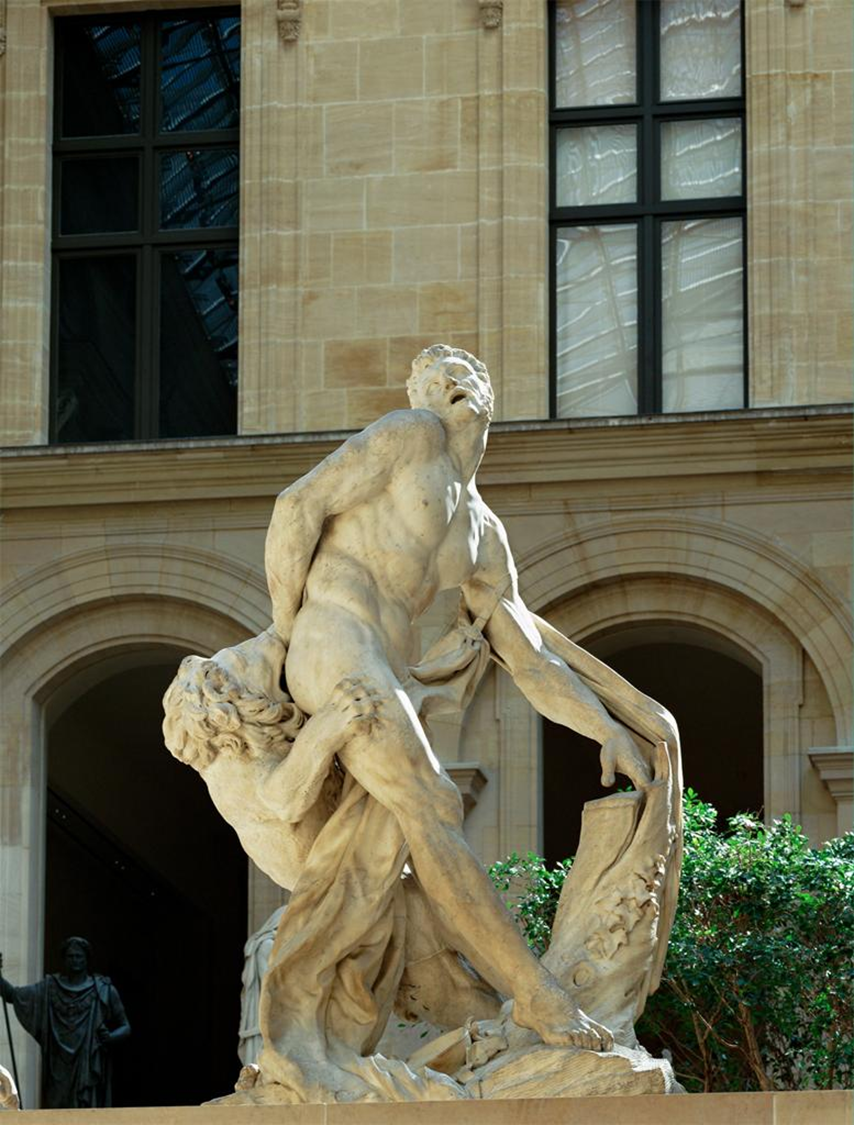
Pierre Puget
1670-82
Overview
Pierre Puget’s Milo of Crotona is a striking example of French Baroque sculpture, showcasing Puget’s deep engagement with the expressive drama of the human body. This large-scale marble work was commissioned by Louis XIV for the gardens of Versailles, and it reveals both physical intensity and psychological tension, hallmarks of Puget's sculptural style.
Subject Matter
Milo of Crotona was a legendary Greek athlete known for his extraordinary strength.
According to ancient sources (notably from Ovid’s Metamorphoses), Milo attempted to split a tree with his bare hands. When the tree closed on his hands, he became trapped and was devoured by wild animals—usually depicted as a lion or wolves.
Puget captures the precise moment of struggle and terror as Milo realizes his fate.
Visual Analysis
Milo’s torso twists dramatically, his muscles tensed in a contorted pose that expresses both agony and resistance.
His face is contorted in pain and fear, a rare instance of psychological expression in French sculpture of the time.
The lion sinks its claws into his thigh, emphasizing the violent climax of the myth and drawing attention to the fragility of the human form, even that of a famed strongman.
The marble surface is richly worked: veins, taut sinews, straining muscles, and the lion’s claws are all meticulously rendered, enhancing the visceral impact of the sculpture.
Baroque Characteristics
The sculpture exemplifies Baroque dynamism: spiraling motion, intense emotion, and the use of the viewer's space to heighten drama.
Puget abandons classical serenity in favor of pathos and physical extremity, aligning with the Italian Baroque tradition, especially Bernini.
Unlike earlier French sculpture, which often favored idealized calm, Puget focuses on emotional realism, making him something of an outlier in French art of the period.
Political and Artistic Context
Though commissioned by Louis XIV, Milo of Crotona was not placed at Versailles due to its intense emotional tone, which may have clashed with the king’s preference for regal control and classical harmony.
The sculpture was later housed in the Louvre, where it continues to be seen as one of Puget’s masterpieces and a unique contribution to 17th-century French art.
It reflects broader Baroque themes: the limits of human power, divine or natural justice, and the tragic vulnerability of man.
Tomb of Cardinal Richelieu
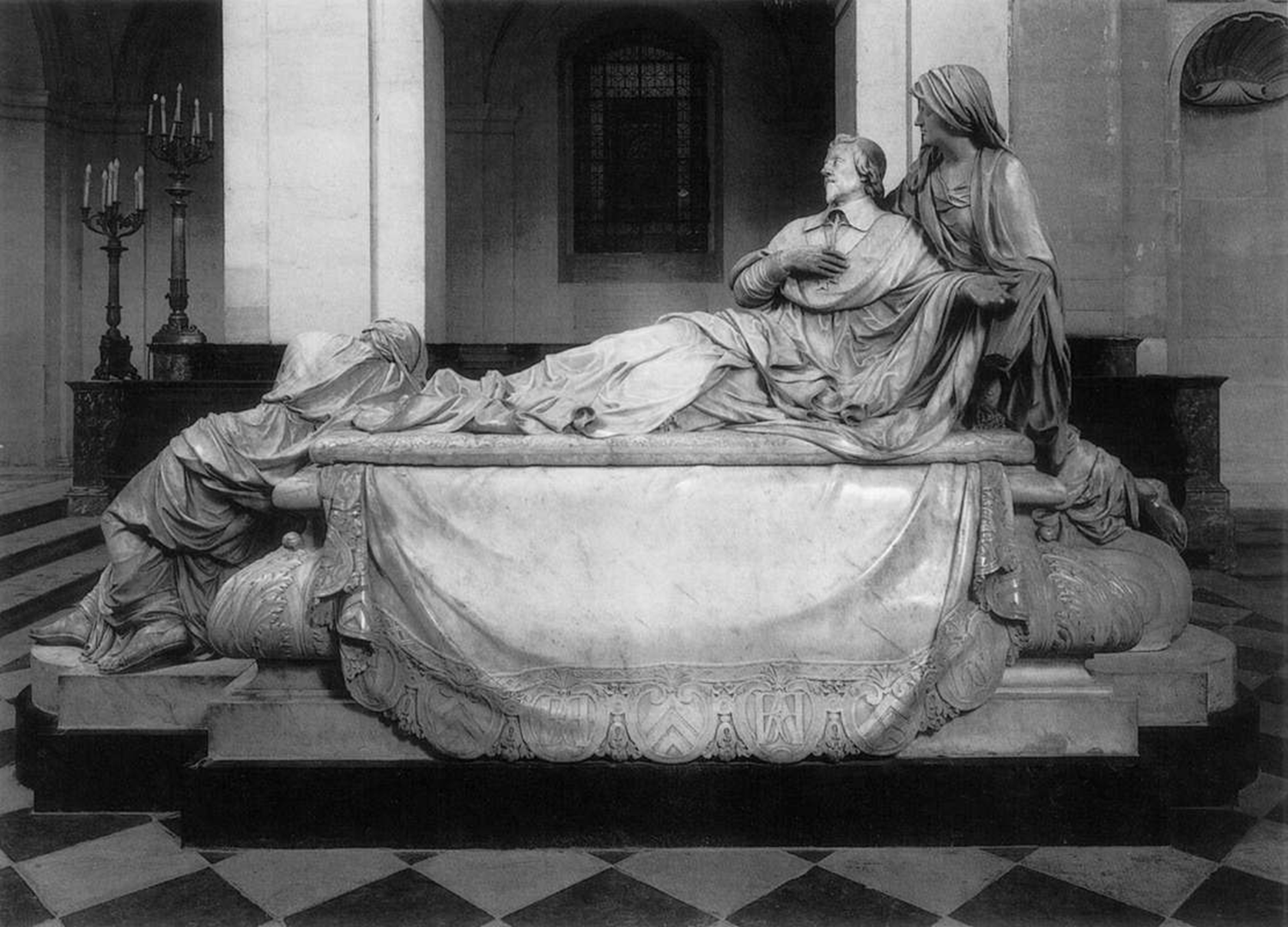
Francois Girardon (after drawings b Le Brun)
1694
Church of the Sorbonne, Paris
Overview
The Tomb of Cardinal Richelieu is a monumental funerary sculpture that commemorates Armand Jean du Plessis, Cardinal Richelieu (1585–1642), a towering political figure of the early 17th century and chief minister to Louis XIII. Executed by François Girardon—the leading French sculptor of Louis XIV’s court—based on designs by Charles Le Brun, the tomb exemplifies the fusion of Baroque grandeur and classical restraint typical of official art under the French monarchy.
Iconography and Composition
The central figure is Richelieu, depicted in repose atop a sarcophagus, dressed in full ecclesiastical robes. His pose is serene and idealized, reflecting both dignity in death and the enduring legacy of his political and religious authority.
He is flanked by two allegorical female figures:
Religion, veiled and sorrowful, mourning his loss.
Doctrine (or Science/Knowledge), holding a book, representing his intellectual contributions and patronage of education (Richelieu was a major founder of the French Academy and the Sorbonne).
The figures are life-size and arranged in a triangular composition, a classically inspired form that balances emotional intensity with formal stability.
Stylistic Analysis
Girardon’s style in this work is restrained yet eloquent. He avoids the intense dynamism of Italian Baroque (like Bernini), favoring calm grandeur and graceful symmetry.
The drapery and figures are sculpted with refined detail, particularly in the textures of the cardinal’s robes and the flowing garments of the allegorical figures.
Le Brun’s influence ensures the work’s iconographic clarity and its alignment with the royal propaganda of the Bourbon monarchy, emphasizing piety, intellect, and national service.
Context and Meaning
Commissioned decades after Richelieu’s death, the tomb was a state-sponsored tribute under Louis XIV, who sought to align his own image with that of strong, centralized leadership as modeled by Richelieu.
Located in the Church of the Sorbonne, which Richelieu helped restore and where he is buried, the tomb is both a personal memorial and a political monument.
The imagery of the tomb reinforces absolutist ideology: Richelieu is not just a churchman, but an embodiment of the king’s guiding principles—religion, order, and intellectual authority.
Legacy
The tomb stands as one of the finest examples of French Baroque funerary art, perfectly balancing grandeur and sobriety.
It reflects the Académie Royale’s ideals of classical clarity, allegorical meaning, and idealized naturalism.
Girardon’s work here solidifies his reputation as a master of monumentality and courtly sculpture, and the tomb itself serves as a visual testament to Richelieu’s enduring influence in French political and cultural life.
Tomb of Cardinal Mazarin

Antoine Coysevox
1689-93
Institut de France, Paris
Overview
The Tomb of Cardinal Mazarin is a monumental funerary sculpture located in the Institut de France in Paris. Created by Antoine Coysevox, one of the leading French sculptors under Louis XIV, the tomb commemorates Jules Mazarin, the chief minister to Louis XIV who succeeded Cardinal Richelieu and played a crucial role in the early years of Louis XIV's reign. The tomb is a significant example of Baroque funerary art, designed to reflect the grandeur and lasting influence of Mazarin, a figure closely tied to the consolidation of royal power in France.
Iconography and Composition
The central figure of the tomb is Mazarin, depicted in a reclining position, symbolizing eternal rest. He is dressed in regal robes, further emphasizing his importance as a statesman and a symbol of the monarchy.
Above him, an allegorical figure of Fame is shown holding a trumpet, proclaiming Mazarin’s legacy. This figure serves to highlight Mazarin’s role in consolidating royal power and his influence on French politics during his lifetime.
The composition is balanced, with symmetrical elements that emphasize the order and stability associated with the reign of Louis XIV.
On either side of the tomb, two figures of angels (often depicted as weeping or mourning) surround the sarcophagus, symbolizing the transition from worldly power to the afterlife. These figures reinforce the Baroque emphasis on the divine and eternal glory.
Stylistic Analysis
Coysevox’s work reflects the French Baroque style, characterized by grandeur, elegance, and idealized forms. The drapery of the robes, the flowing lines, and the expressive poses of the figures all display the sculptor's technical mastery and his ability to convey a sense of movement and emotion.
The iconography of the tomb aligns with Baroque ideals, where allegorical figures convey moral and political messages. The trumpeting Fame and the grieving angels are powerful symbols of posthumous glory and divine approval, reinforcing the royal message of divine right that Louis XIV strongly embraced.
The realism in the depiction of Mazarin’s face and figure contrasts with the idealization of other figures, which reflects both the Baroque emphasis on the individual and the royal preference for classical antiquity-inspired forms.
Context and Meaning
Jules Mazarin (1602-1661) served as chief minister to Louis XIV following the death of Cardinal Richelieu. Mazarin was instrumental in securing French victories during the Franco-Spanish War and overseeing the final consolidation of royal power. The tomb commemorates his legacy as a statesman who guided France through a crucial period.
The tomb's location in the Institut de France, an institution founded by Louis XIV, is symbolic of Mazarin’s role in the founding of French intellectual and artistic institutions, as he was a patron of the arts and played a key role in the creation of the Académie des Sciences and the Académie Française.
The tomb represents Mazarin’s significance in the era of absolutism, reinforcing his association with the French monarchy’s centralization of power.
Legacy
The Tomb of Cardinal Mazarin serves as an example of French Baroque tomb sculpture, reflecting the monarchy’s desire to create a visual representation of royal authority and the divine right of kings. The use of allegorical figures, idealized forms, and symbolism links Mazarin's legacy with the grandeur of Louis XIV’s reign.
Antoine Coysevox, through this monument, secured his reputation as one of the leading sculptors of the Baroque period in France. His work on this tomb is admired for its elegance, technical skill, and emotional expressiveness, which were hallmarks of his career.
Self-Portrait

Simon Vouet
1618-19
Overview
Simon Vouet’s Self-Portrait, painted during his time in Rome, is a striking example of his early style, before he returned to France and became court painter to Louis XIII. This self-portrait is not only a visual record of the artist in his late twenties but also a declaration of artistic identity and ambition, executed in a dramatic and vivid Caravaggesque manner.
Stylistic Characteristics
The painting is rendered with strong chiaroscuro, a hallmark of Caravaggio’s influence that Vouet absorbed while working in Italy. His face and hand emerge from a dark background with a sharp light source, giving the portrait an almost theatrical intensity.
Vouet presents himself as a confident and stylish artist, wearing rich clothing and holding a brush or palette (in some versions or interpretations), which emphasizes his profession and self-awareness.
His direct gaze engages the viewer assertively, suggesting both pride in his craft and the rising status of the artist in the 17th century.
Context
Simon Vouet (1590–1649) was a leading figure in bringing Italian Baroque style to France. By the time he painted this self-portrait, he was well-established in Rome, part of the cosmopolitan circle of artists influenced by Caravaggio, Guido Reni, and Domenichino.
This self-portrait was likely painted to serve as a calling card or professional statement, aligning Vouet with the Caravaggesque movement and asserting his place among Europe's leading painters.
Upon returning to France in 1627, Vouet was appointed Premier peintre du Roi and played a pivotal role in shaping the development of French Baroque art, mentoring figures like Charles Le Brun.
Interpretation and Significance
The self-portrait exemplifies individualism and professional pride. It reflects the emerging idea of the artist as intellectual and creator, not just a craftsman.
Vouet’s stylish appearance and confident pose convey social mobility and personal success, aligned with the Baroque period’s emphasis on drama, display, and self-fashioning.
The chiaroscuro technique and naturalism link him directly to the Caravaggisti, while the controlled elegance hints at the more refined French Baroque aesthetic he would later help develop.
Legacy
This portrait serves as a visual marker of Vouet’s artistic evolution and his important role as a transmitter of Italian Baroque styles to France.
It remains a compelling example of early 17th-century self-portraiture, where the artist not only reveals his likeness but also constructs an identity of authority, skill, and refinement.
Principe
Translates to prince in English. It's a noun that refers to a male member of a royal family, especially the son of a king or queen, or the ruler of a smaller territory like a principality.
Caravaggisti/Caravaggismo
The Caravaggisti were stylistic followers of the late 16th-century Italian Baroque painter Caravaggio
The Fortune Teller
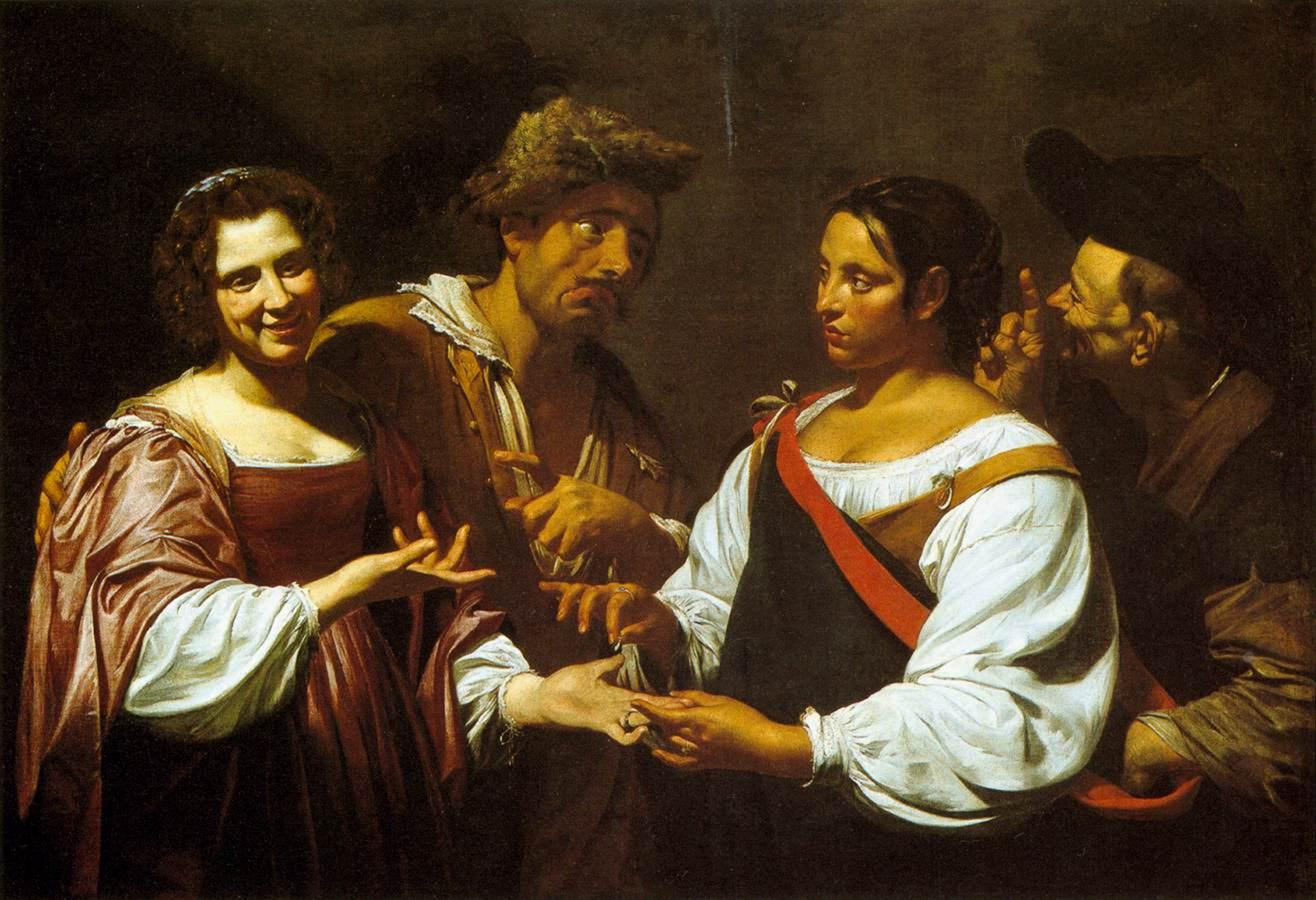
Simon Vouet
ca. 1620
Overview
Simon Vouet’s The Fortune Teller reflects his immersion in Caravaggesque realism and genre painting during his Roman period. The painting features a dramatic and somewhat theatrical interaction between figures, with a young man having his palm read by a seductive fortune teller, while an accomplice quietly robs him—a popular narrative in 17th-century genre scenes.
Stylistic Characteristics
Chiaroscuro: Like many of his contemporaries in Rome, Vouet employs strong light-dark contrasts, inspired by Caravaggio, to emphasize the physicality of the figures and enhance the drama.
Realism and Theatricality: The figures are rendered with vivid detail, including textures of fabric and expressions. The scene is highly staged, suggesting an awareness of the viewer and theatrical engagement.
Color and Composition: Warm earthy tones dominate, and the triangular arrangement of figures creates a sense of balance amidst the narrative tension.
Psychological Insight: The central youth is naively focused on the fortune teller, while the second woman’s furtive glance and sneaky hand evoke the duplicitous nature of the scene.
Context
Vouet painted The Fortune Teller during his Italian period (1613–1627), when he was absorbing the styles of Caravaggio and his followers like Bartolomeo Manfredi and Valentin de Boulogne.
Genre scenes featuring deception, particularly those involving gypsy women or fortune tellers, were popular across Europe at this time, often carrying moralistic undertones warning against vice and folly.
The painting is also a commentary on illusion and perception, a key theme in Baroque art that Vouet explores through both visual trickery and narrative deceit.
Interpretation and Significance
The work can be read as a moral allegory, warning of the dangers of seduction and gullibility. The young man’s distraction mirrors a broader Baroque concern with appearances versus reality.
It also plays with the viewer’s own complicity, inviting us to observe the deception without intervening—typical of the Baroque’s theatrical and immersive approach.
The painting stands at the crossroads of genre and history painting, blending everyday subject matter with elevated visual techniques and psychological depth.
Legacy
The Fortune Teller is a key example of how Vouet merged Italian Caravaggism with French tastes, setting the stage for the refined French Baroque he would later champion.
It demonstrates Vouet’s versatility—not only in grand religious and allegorical works but also in scenes of daily life imbued with dramatic and moral resonance.
Last Supper

Simon Vouet
1615-20
Overview
Simon Vouet’s Last Supper was painted during his formative years in Italy and reveals his assimilation of Caravaggesque naturalism and dramatic religious storytelling. The scene captures the pivotal moment of Christ announcing the betrayal, heightening the tension through expression, gesture, and lighting.
Stylistic Characteristics
Chiaroscuro: Strong contrasts of light and shadow dramatize the scene, with Christ subtly illuminated at the center. Vouet channels the legacy of Caravaggio while softening its severity with more lyrical modeling.
Emotional Expression: Each apostle responds with varied gestures and expressions of disbelief, anxiety, or shock, lending psychological depth to the narrative.
Composition: Christ is centrally located, anchoring the composition. The apostles form a semi-circular arc, creating both unity and movement within the pictorial space.
Realism and Detail: Naturalistic renderings of hands, faces, and textiles emphasize immediacy and physicality, bringing the viewer into the sacred drama.
Use of Color: Warm earth tones dominate the palette, enhancing the intimate and solemn mood of the scene.
Context
Painted in Rome or Naples during Vouet’s Italian period, this work reflects his engagement with the Caravaggesque tradition—not just in lighting, but in the focus on human experience and narrative clarity.
The Last Supper was a popular subject in Counter-Reformation art, offering an opportunity to express both Eucharistic theology and moral introspection.
Vouet would have known similar works by artists like Caravaggio (e.g., Supper at Emmaus), Giovanni Lanfranco, and Valentin de Boulogne, all of whom used close figural groupings to heighten intimacy and drama.
Interpretation and Significance
Christ's calm amidst the apostles’ turmoil highlights his divinity, a key message in Catholic reformist imagery meant to inspire devotion and humility.
The focus on betrayal and human weakness underscores the need for grace and spiritual vigilance, themes central to the Baroque religious ethos.
Vouet's version is notable for its psychological subtlety—rather than theatrical gestures, he favors measured drama, signaling the emerging French Baroque refinement that would mark his later work.
Legacy
This painting showcases Vouet’s early ability to blend Italian intensity with French elegance, a synthesis that would shape the trajectory of 17th-century French art.
It stands as a bridge between Caravaggesque tenebrism and the classicizing decorum of Vouet’s later career, marking him as a pivotal figure in Baroque paintin
Crucifixion

Simon Vouet
1622
Medium: Oil on canvas
Date: 1622
Location: Church of the Gesù, Genoa (original commission)
Style: Italian Baroque with Caravaggesque influence
Overview
Simon Vouet’s Crucifixion (1622) marks a significant point in his Italian period, merging theatrical Baroque emotion with Caravaggesque naturalism. Created during his stay in Genoa, this altarpiece was likely commissioned by the Jesuits, aligning with their emphasis on devotional intensity and emotional engagement in sacred art.
Stylistic Features
Dramatic Chiaroscuro: Strong, directional lighting emphasizes Christ’s body on the cross, casting shadows that heighten the emotional and spiritual intensity. The scene unfolds in a darkened atmosphere pierced by divine illumination.
Emotional Realism: Vouet’s Christ is rendered with poignant naturalism—his contorted body and anguished expression reflect the physical and spiritual agony of the moment.
Dynamic Composition: The figures of the Virgin Mary, St. John the Evangelist, and Mary Magdalene are arranged diagonally, leading the viewer’s eye upward to the crucified Christ. Their gestures and poses communicate profound pathos without descending into melodrama.
Color and Texture: Deep reds, ochres, and cool blues are layered into richly textured draperies, enhancing the sensory realism and symbolic resonance (e.g., red for martyrdom, blue for the Virgin's purity).
Architectonic Setting: The Golgotha backdrop is minimized; the focus remains tightly on the figures, enhancing intimacy and immediacy.
Context
Created during Vouet’s stay in Italy (1613–1627), this work demonstrates his immersion in Italian Baroque traditions, especially the influence of Caravaggio, Guido Reni, and Lanfranco.
Jesuit patronage often required works that could emotionally move the faithful—this Crucifixion aligns with the Counter-Reformation aim of visual persuasion through suffering and redemption.
This altarpiece would have functioned both liturgically and didactically, reinforcing the central mysteries of the faith through vivid, accessible imagery.
Interpretation and Theological Messaging
Christ’s placement high on the canvas, illuminated and serene amid suffering, emphasizes his divine transcendence even in death.
The emotional responses of the surrounding figures serve as models for contemplative devotion—encouraging viewers to engage personally with the Passion.
The absence of extraneous narrative detail centers attention on the crucifixion event itself, echoing Jesuit ideals of meditative focus.
Art Historical Significance
This work helped establish Vouet as a rising star in Italian sacred art, capable of blending theatrical flair with devotional power.
It also foreshadows his later French religious works, where he would retain this emotional clarity while adopting a more classical refinement.
A rare French artist to gain prominence in Italy at this time, Vouet became an important conduit of Baroque visual language back into France.
Presentation of the Virgin in the Temple
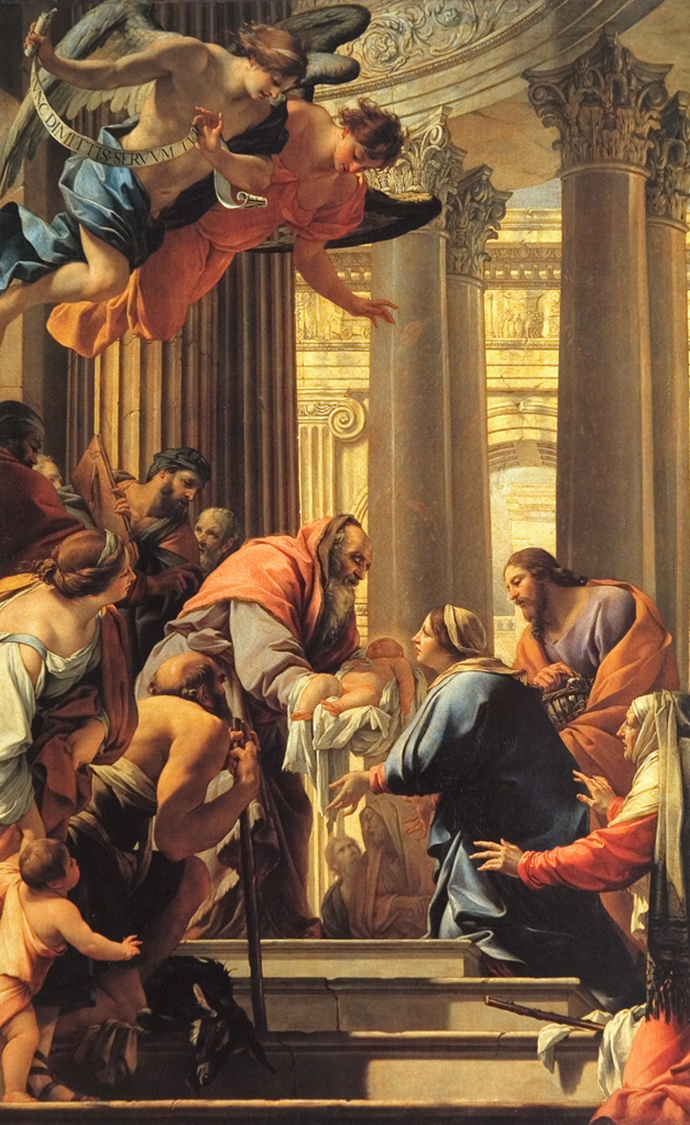
Simon Vouet
1641
Medium: Oil on canvas
Location: Originally for the Jesuit Church of Saint-Paul-Saint-Louis, Paris
Style: French Baroque, infused with Italian classicism and theatricality
Overview
Simon Vouet’s Presentation of the Virgin in the Temple reflects his mature French Baroque style, characterized by graceful figures, monumental architecture, and a harmonious synthesis of Italian influences with a distinctly French refinement. Commissioned for a prominent Jesuit church, this grand altarpiece presents the young Virgin Mary ascending the steps of the temple, a pivotal event in her early life celebrated in Catholic tradition.
Stylistic Features
Monumental Classicism: The temple is rendered with majestic architectural forms, resembling Renaissance and Roman Baroque structures. The architecture does not just frame the scene but enhances the sacred drama, drawing from artists like Raphael and Annibale Carracci.
Stage-like Composition: Figures are arranged with a sense of theatrical choreography, typical of Vouet’s Jesuit commissions. The central stairway functions almost like a stage, drawing the viewer's gaze upward toward the small yet radiant figure of Mary.
Color and Light: Vouet employs a warm, luminous palette, using rose, gold, blue, and ivory tones to highlight divine figures and accentuate their spiritual purity. The soft modeling of light gives the figures a sculptural presence.
Elegant Figures: The Virgin Mary is portrayed as an idealized child, serene and dignified. Her modest gaze and delicate step emphasize her predestined holiness. The surrounding figures—priests, parents, temple attendants—are animated yet restrained, each contributing to the ceremonial rhythm.
Gesture and Expression: Every figure’s gesture serves a communicative purpose—pointing, guiding, or reacting with reverence—creating a narrative flow across the canvas.
Context
This work reflects Vouet’s role as Premier peintre du Roi (First Painter to the King) and his leadership in establishing a French visual language of grandeur, combining Italian drama with French clarity.
Created for a Jesuit context, the painting emphasizes Marian devotion, linking Mary's early consecration to her future role as the Theotokos (Mother of God).
Its didactic clarity and compositional elegance align with Counter-Reformation ideals, where art served to instruct and inspire the faithful.
Theological and Symbolic Messaging
The upward movement of the Virgin symbolizes spiritual ascent and readiness to serve God.
The temple steps metaphorically link Old Testament tradition with the New, bridging Mary’s personal story with salvation history.
The divine light falling on Mary sets her apart visually and theologically—she is illuminated by grace from the beginning.
Significance and Legacy
The painting represents Vouet at the height of his power, fully integrating his Italian training with the decorative and narrative needs of the French ecclesiastical elite.
It became a model for many French religious painters who sought to balance decorative elegance, narrative clarity, and spiritual gravity.
In its clarity, grace, and monumental rhythm, it exemplifies the Jesuit visual aesthetic: persuasive, engaging, and doctrinally rich.
Conquered by Amor, Venus, and Hope

Simon Vouet
1645-46
Medium: Oil on canvas
Location: Musée des Beaux-Arts, Rennes
Commissioned for: Hôtel Séguier, Paris
Style: French Baroque allegory, blending myth, allegory, and courtly elegance
Overview
This late allegorical painting by Simon Vouet is a masterful synthesis of mythological symbolism and Baroque theatricality, composed for a private Parisian hôtel (urban palace). It presents a richly layered scene in which Saturn (Chronos)—god of time and devourer of his children—is overpowered by Amor (Love), Venus (Beauty), and Spes (Hope). The image functions as both an allegory of love’s triumph over time and despair, and a political and moral metaphor likely aimed at flattering a patron or expressing ideals of the French court.
Composition and Style
Triangular Composition: The figures are arranged in a dynamic triangular structure, with Saturn’s heavy, twisting body below and the graceful trio of Venus, Amor, and Hope ascending diagonally.
Baroque Dynamism: The painting brims with movement—clashing diagonals, twisting bodies, fluttering drapery—all contributing to the drama and tension of Saturn’s symbolic defeat.
Color and Light: Vouet uses a vivid palette of luminous flesh tones, flowing red and blue drapery, and radiant gold to distinguish the celestial from the terrestrial. The use of chiaroscuro heightens the dramatic effect, spotlighting the divine figures and plunging Saturn partly into shadow.
Idealized Beauty: True to Vouet’s mature style, the figures are elegant, elongated, and classically beautiful, reminiscent of both Raphael and Guido Reni, but imbued with a distinctly French softness and decorum.
Iconography and Allegory
Saturn/Chronos: Symbolizes Time, Age, and inevitable decay—he’s presented as old, defeated, and weighed down, a contrast to the vitality of the youthful gods.
Amor (Cupid): Represents Love’s power—armed with a bow, Amor’s intervention halts Saturn’s destructive tendency, symbolizing love’s ability to conquer time and violence.
Venus: As the goddess of beauty and mother of Amor, she embodies grace, sensuality, and harmony—her presence tempers Saturn’s harshness.
Hope (Spes): A rare but crucial allegorical figure, shown with her anchor, she conveys the idea that even in a world ruled by time and entropy, hope endures and brings renewal.
Context and Patronage
Commissioned during Vouet’s final years, likely for Pierre Séguier, chancellor to Louis XIII and XIV—a man of power and learning. The painting would have hung in a space that demanded intellectual sophistication and courtly refinement.
The subject is infused with neo-Stoic and Neoplatonic ideals, fashionable among elite circles: the soul’s ability to rise above time-bound suffering through love, beauty, and divine hope.
It also echoes the French court’s political propaganda, particularly the idea that the monarch’s virtue and love (embodied by figures like Venus and Amor) could stabilize and transcend time’s destruction—a fitting ideal under Louis XIII and the regency of Anne of Austria.
Significance and Legacy
This painting is an exemplar of French allegorical Baroque, standing at the crossroads of Italianate elegance and French courtly symbolism.
It demonstrates Vouet’s unique ability to translate classical myth into refined courtly spectacle, prefiguring the allegorical grandeur of Charles Le Brun and the symbolic pageantry of Versailles.
The triumph of abstract virtues over time also served as a moralizing message, part of a broader Counter-Reformation and absolutist aesthetic that sought to promote order, beauty, and spiritual transcendence.
Martyrdom of St Processus and St Martinian
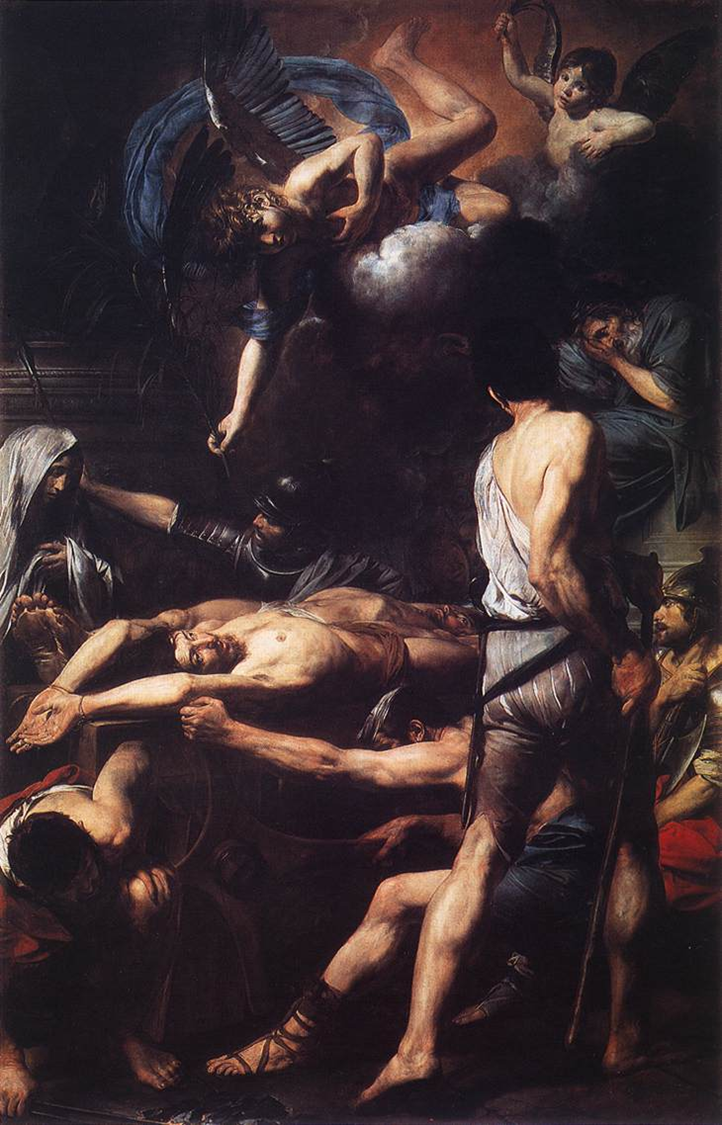
Valentin de Boulogne
1629
Medium: Oil on canvas
Location: Vatican Museums, Rome (originally painted for the Basilica of St. Peter)
Patronage: Commissioned by Pope Urban VIII
Style: Caravaggesque Naturalism with French classicizing elements
Overview
Valentin de Boulogne’s Martyrdom of St. Processus and St. Martinian is a vivid and emotionally intense depiction of early Christian martyrdom, commissioned by Pope Urban VIII for St. Peter’s Basilica. A key figure among the Caravaggisti—followers of Caravaggio—Valentin infused the master’s tenebrism and realism with his own emotive restraint and French sense of order, creating a work that balances brutality and spirituality.
Subject Matter
St. Processus and St. Martinian were Roman soldiers and jailers of Peter and Paul who converted to Christianity and were subsequently martyred under Emperor Nero. Their relics were venerated in the catacombs and later moved to St. Peter’s, making them especially significant to the papal church.
The painting captures the moment of their martyrdom, with an executioner raising a sword and another figure restraining one of the saints. A celestial light beams down on the victims, suggesting divine presence and their imminent sanctification.
Formal Analysis
Chiaroscuro: Strong contrasts of light and dark (Caravaggesque tenebrism) dramatize the scene, isolating figures in a spotlight-like illumination that suggests divine judgment and grace.
Composition: The space is compressed and the action tightly focused in the foreground. Figures are tightly clustered, almost pushing into the viewer’s space—a hallmark of Baroque immediacy.
Naturalism: The physicality of the executioners—bulging muscles, weathered skin, and intense expressions—contrasts with the saints’ idealized, serene faces, underscoring their spiritual transcendence amid violence.
Gesture and Emotion: Unlike Caravaggio’s raw brutality, Valentin tempers his violence with a sense of tragic solemnity. The saints exhibit calm resignation, reinforcing their role as spiritual victors, not just martyrs.
Classical Allusions: Despite the gritty realism, Valentin imbues the saints with a classical dignity, reflecting his French training and perhaps responding to papal tastes for restrained nobility in sacred imagery.
Context and Function
Painted as part of Urban VIII’s massive redecoration of St. Peter’s, the work reflects Counter-Reformation goals: emphasizing the heroism of martyrdom, the truth of relics, and the intercessionary power of saints.
Valentin was one of the few foreign painters (French, in this case) invited to contribute to the decoration of the new St. Peter’s, marking his prestige in Rome during the 1620s.
The painting was meant to inspire devotion and underscore papal authority, reinforcing the Church's apostolic foundation through local martyr-saints connected to Peter and Paul.
Comparison and Influence
Compared to Caravaggio’s Martyrdom of St. Matthew, Valentin’s version is more restrained and less chaotic, preferring moral clarity over psychological ambiguity.
His style lies somewhere between Caravaggio’s visceral immediacy and Poussin’s classical clarity, making him an important transitional figure in the evolution of Baroque painting in Rome.
The Four Ages of Man

Valentin de Boulogne
ca. 1620
Medium: Oil on canvas
Current Location: Galleria Nazionale d'Arte Antica (Palazzo Barberini), Rome
Style: Caravaggesque genre painting with allegorical content
Overview
In The Four Ages of Man, Valentin de Boulogne tackles a moralizing allegory through the lens of Caravaggesque realism. The painting stages a seemingly ordinary tavern or domestic scene that unfolds into a visual meditation on the passage of time, the stages of human life, and, implicitly, the vanity of earthly pleasures.
Subject Matter
The painting depicts four male figures, each representing a different stage of life:
Childhood: A young boy, often shown learning or observing.
Youth: A lute player, symbolizing vitality and pleasure.
Adulthood: A man with a wine glass, enjoying sensual pleasures.
Old Age: An older man, often shown with a somber or contemplative expression, confronting mortality.
The four are gathered around a table in a dimly lit room, interacting quietly, suggesting introspection rather than drama. The figures mirror each other in gesture and posture, creating a circular, almost ritualistic rhythm.
Formal Analysis
Lighting: Tenebrism dominates, with strong, localized light illuminating the figures against a shadowy background, drawing attention to faces, hands, and objects of symbolic value (lute, glass, books).
Realism and Genre Detail: Valentin’s figures are based on real people, depicted with naturalistic textures—wrinkled skin, stubble, flushed cheeks—and located in a familiar tavern-like interior, characteristic of low-life genre scenes.
Stillness and Reflection: Unlike other Caravaggesque scenes of raucous drinking or gambling, this one is subdued, imbued with a melancholic quiet that heightens its allegorical meaning.
Symbolism:
The musical instrument (lute) may evoke transience, like the fleeting sound of music.
The wine glass becomes a symbol of indulgence or distraction.
The old man may be seen reading, indicating wisdom or reflection at the end of life.
Context and Interpretation
This painting likely reflects Baroque concerns with time, morality, and vanitas themes, popular in both Catholic and Protestant contexts.
The theme of The Four Ages of Man is ancient, going back to classical antiquity and medieval philosophy, but Valentin presents it in an earthy, contemporary mode.
While Caravaggio often depicted violent or ecstatic moments, Valentin leans toward quiet contemplation, presenting the human condition as cyclical and inevitably tragic—a more stoic vision of life’s passage.
Comparison and Influence
Compared to Caravaggio’s genre works like The Cardsharps or The Musicians, Valentin’s painting is more philosophical than theatrical.
The piece echoes northern vanitas paintings in theme, though executed in a southern Roman realist style.
Valentin’s approach influenced later artists like Le Nain brothers in France, who similarly used genre scenes to explore moral and allegorical ideas.
Peintre Ordinaire du Roi
"regular painter of the king" or "king's ordinary painter" in English. It was a title given to artists who worked regularly for the French monarch, often holding a position within the court's administration of the Bâtiments du Roi. This title meant the artist was officially employed by the king and often had specific privileges or responsibilities, like being allowed a studio in the Louvre or being commissioned for specific projects.
The Christ with the Ace of Diamonds

Georges de La Tour
ca. 1630
Medium: Oil on canvas
Current Location: Musée du Louvre, Paris
Style: French Baroque, with Caravaggesque influence
Overview
Georges de La Tour’s The Cheat with the Ace of Diamonds is a refined and psychologically charged genre scene that encapsulates themes of deception, vice, and moral awareness. Like his better-known The Cheat with the Ace of Clubs, this painting demonstrates La Tour’s fascination with subtle human drama, expressed through stillness, gesture, and gaze.
Subject Matter
The scene portrays a clandestine moment of cheating during a card game, frozen in time:
A richly dressed young nobleman (the mark) sits at a table, absorbed in the game and oblivious to what’s unfolding.
A cheater, with a sly look, pulls an ace of diamonds from behind his back.
A serving woman and another conspirator share complicit glances and gestures, completing the triangle of deception.
Formal Qualities
Lighting: La Tour uses controlled, even lighting—more diffuse than Caravaggio’s dramatic chiaroscuro. The figures are illuminated with a calm clarity that emphasizes surface and stillness.
Composition: The scene is tightly cropped, almost theatrical, with the figures arranged in a frieze-like row, emphasizing interaction through glance and gesture.
Color and Texture: Rich fabrics (silk, velvet) and elegant gestures give the work a refined elegance despite its theme of corruption.
Facial Expression: La Tour conveys emotion with economy—tiny shifts of the eyes, pursed lips, and raised eyebrows hint at layered psychological dynamics.
Themes and Interpretation
Moral Allegory: The painting can be read as a visual sermon on gullibility, temptation, and sin, common Baroque concerns. It subtly critiques youthful vanity and the dangers of distraction.
Vanitas undertone: Though not overt, the painting participates in the vanitas tradition—reminding viewers that worldly pleasures (games, fashion, status) are fleeting and vulnerable to corruption.
Social Commentary: The elegant clothes and formal setting hint at the hypocrisy of the upper class, where surfaces mask dishonesty.
Context
Painted during La Tour’s early mature phase, possibly while he was still under strong Caravaggesque influence—likely transmitted through Utrecht Caravaggisti or engravings rather than direct contact with Caravaggio’s work.
Part of a broader 17th-century interest in moralizing genre scenes, like those by Valentin de Boulogne, the Le Nain brothers, or Dutch painters such as Jan Steen.
Comparison
With Caravaggio: While Caravaggio’s Cardsharps is tenser and more kinetic, La Tour’s version is more composed and cerebral, with a contemplative rather than explosive atmosphere.
With La Tour himself: Compared to his religious night scenes (e.g., Magdalene with the Smoking Flame), The Cheat is more narrative and daylight-focused, yet still retains his signature serenity and psychological subtlety.